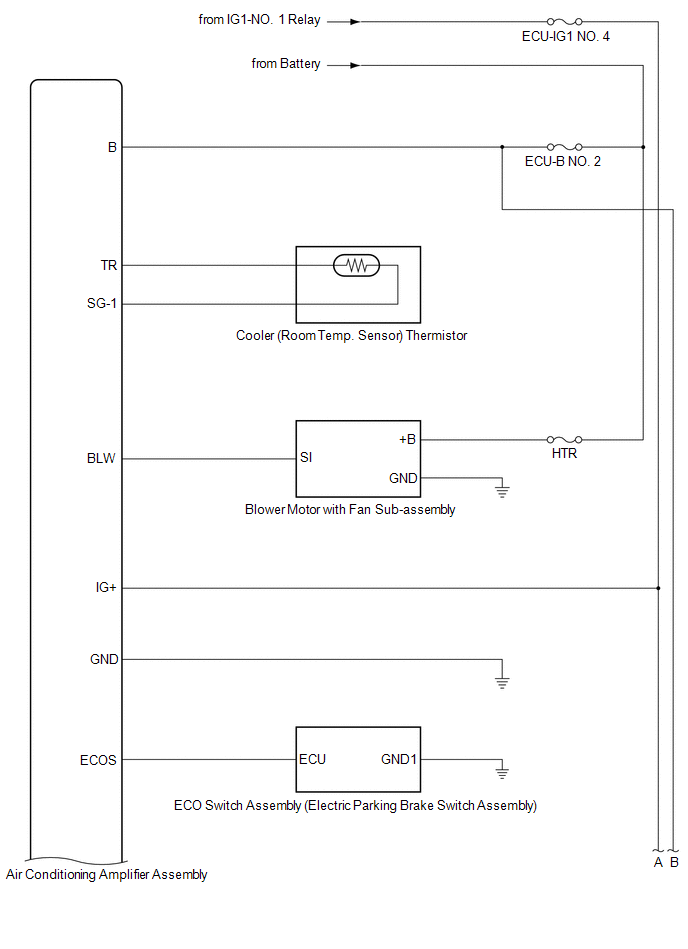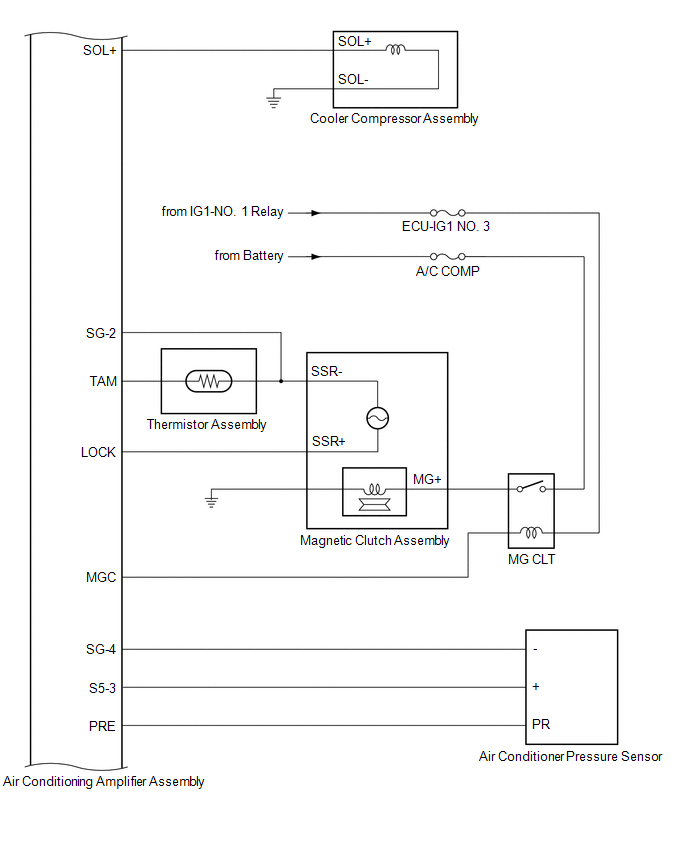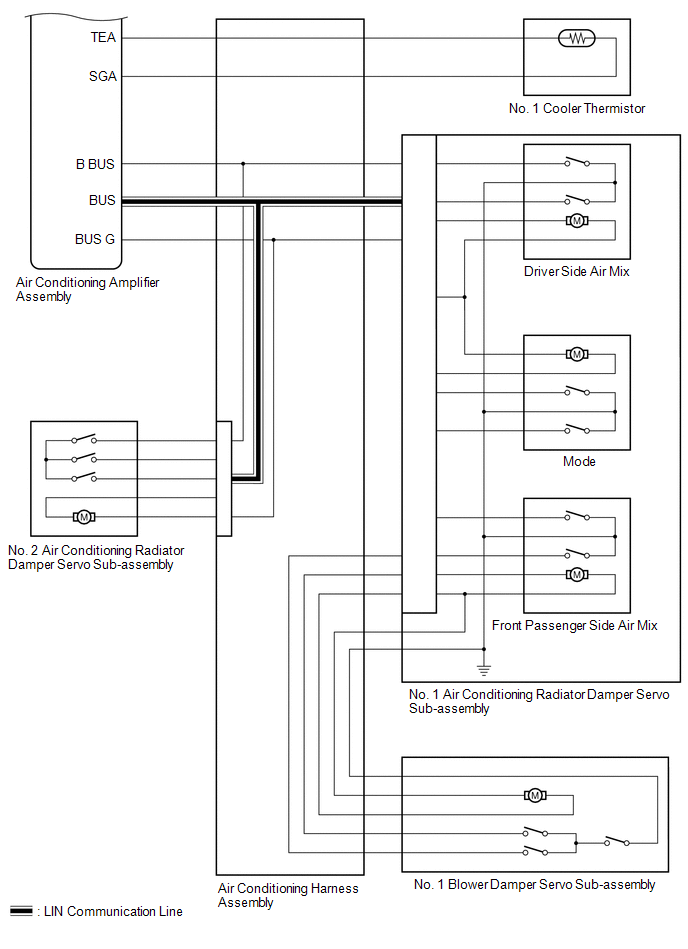A/C Switch Indicator does not Turn On
DESCRIPTION
If none of the
switch indicators on the air conditioning control panel (radio and
display receiver assembly) illuminate, the following factors may be the
cause.
|
Symptom | Factor |
|
A/C switch indicator does not illuminate |
- Air conditioning amplifier assembly malfunction
- Air conditioning control panel (radio and display receiver assembly) malfunction
- A/C switch malfunction
- A/C switch indicator malfunction (including when indicator turned off without switch operation)
- Servo motor initialization (incomplete)
- Mechanical locking of damper and damper link
- Refrigerant pressure is extremely low
- Low detected ambient temperature (including thermistor assembly malfunction)
|
PROCEDURE
| 1. |
CHECK MALFUNCTION STATUS |
(a)
Check the malfunction status of switch indicators on the air
conditioning control panel (radio and display receiver assembly).
| Result | Proceed to |
|
Indicators are not always illuminated |
A |
| Indicators are not illuminated only immediately after starting the engine |
B |
| B |
 | GO TO INITIALIZATION |
|
A |
 | |
| 2. |
READ VALUE USING TECHSTREAM |
(a) Connect the Techstream to the DLC3.
(b) Turn the engine switch on (IG).
(c) Turn the Techstream on.
(d) Enter the following menus: Body Electrical / Air Conditioner / Data List.
(e) Read the Data List according to the display on the Techstream.
Body Electrical > Air Conditioner > Data List
|
Tester Display | Measurement Item |
Range | Normal Condition |
Diagnostic Note |
|
Ambient Temp Sensor | Thermistor assembly |
Min.: -23.30┬░C (-9.94┬░F) Max.: 65.95┬░C (150.71┬░F) |
Actual ambient temperature displayed |
Thermistor assembly circuit malfunction
- When open circuit: -23.30┬░C (-9.94┬░F)
- When short circuit: 65.95┬░C (150.71┬░F)
|
Body Electrical > Air Conditioner > Data List
|
Tester Display |
| Ambient Temp Sensor |
OK:
The value displayed is 0┬░C (32┬░F) or higher.
| OK |
 | INSPECT REFRIGERANT PRESSURE WITH MANIFOLD GAUGE SET |
| NG |
 | GO TO OTHER DIAGNOSIS PROCEDURE (Ambient Temperature Display System) |
Air Conditioning Compressor Magnetic Clutch Circuit
DESCRIPTION
When the engine
is running, If refrigerant pressure does not decrease when the A/C
switch is turned off, the following factors may be the cause.
|
Symptom | Factor |
- Cooler compressor assembly does not stop operating
- Refrigerant pressure does not decrease when A/C switch is turned off
|
- Short to +B in air conditioning amplifier assembly circuit malfunction
- MG CLT relay malfunction
- Magnet clutch assembly malfunction
- Harness or connector
|
WIRING DIAGRAM
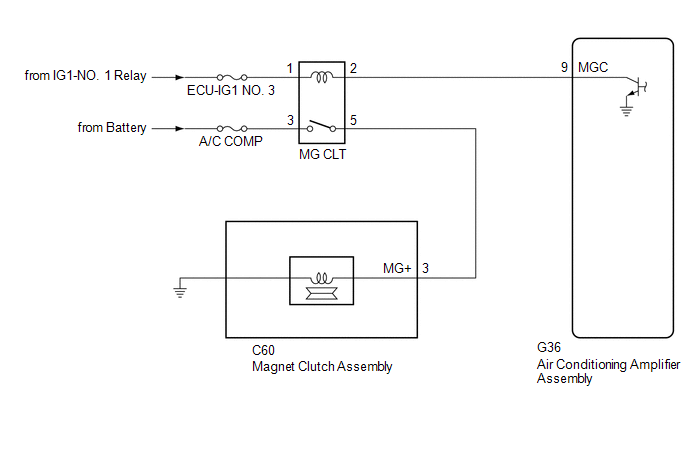
CAUTION / NOTICE / HINT
NOTICE:
Inspect the fuses for circuits related to this system before performing the following procedure.
PROCEDURE
(a) Inspect the MG CLT relay.
Click here 
| NG |
 | REPLACE MG CLT RELAY |
|
OK |
 | |
| 2. |
CHECK HARNESS AND CONNECTOR (MG CLT RELAY - POWER SOURCE) |
(a) Measure the voltage according to the value(s) in the table below.
Standard Voltage:
|
Tester Connection | Condition |
Specified Condition |
|
3 (MG CLT relay) - Body ground |
Always | 11 to 14 V |
|
1 (MG CLT relay) - Body ground |
Engine switch off | Below 1 V |
|
1 (MG CLT relay) - Body ground |
Engine switch on (IG) |
11 to 14 V |
| NG |
 | REPAIR OR REPLACE HARNESS OR CONNECTOR |
|
OK |
 | |
| 3. |
CHECK HARNESS AND CONNECTOR (MG CLT RELAY - AIR CONDITIONING AMPLIFIER ASSEMBLY) |
(a) Disconnect the G36 air conditioning amplifier assembly connector.
(b) Measure the resistance according to the value(s) in the table below.
Standard Resistance:
|
Tester Connection | Condition |
Specified Condition |
|
2 (MG CLT relay) - G36-9 (MGC) |
Always | Below 1 ╬® |
|
2 (MG CLT relay) or G36-9 (MGC) - Other terminals and body ground |
Always | 10 k╬® or higher |
| NG |
 | REPAIR OR REPLACE HARNESS OR CONNECTOR |
|
OK |
 | |
| 4. |
CHECK HARNESS AND CONNECTOR (MG CLT RELAY - MAGNET CLUTCH ASSEMBLY AND BODY GROUND) |
(a) Disconnect the C60 magnet clutch assembly connector.
(b) Measure the resistance according to the value(s) in the table below.
Standard Resistance:
|
Tester Connection | Condition |
Specified Condition |
|
5 (MG CLT relay) - C60-3 (MG+) |
Always | Below 1 ╬® |
|
5 (MG CLT relay) or C60-3 (MG+) - Other terminals and body ground |
Always | 10 k╬® or higher |
| NG |
 | REPAIR OR REPLACE HARNESS OR CONNECTOR |
|
OK |
 | |
| 5. |
CHECK HARNESS AND CONNECTOR (MAGNET CLUTCH ASSEMBLY - BODY GROUND) |
(a) Install the MG CLT relay.
(b) Connect the C60 compressor assembly with magnetic clutch connector.
(c) Measure the voltage according to the value(s) in the table below.
Standard Voltage:
|
Tester Connection | Condition |
Specified Condition |
|
C60-3 (MG+) - Body ground |
Engine running (A/C switch: Off) |
Below 1 V |
| OK |
 | REPLACE MAGNET CLUTCH ASSEMBLY |
| NG |
 | REPAIR OR REPLACE HARNESS OR CONNECTOR |
Air Vent cannot be Switched
DESCRIPTION
If the air outlet mode does not change even though the air outlet display changes, the following factors may be the cause.
|
Symptom | Factor |
|
Air outlet mode cannot be changed
- (air outlet display changes)
|
- No. 1 air conditioning radiator damper servo sub-assembly malfunction
- Damper link disconnection
- Air conditioner unit assembly malfunction
|
PROCEDURE
| 1. |
CHECK AIR OUTLET SERVO MOTOR |
(a) Confirm for which seat the air outlet mode cannot be changed.
|
Result | Proceed to |
|
The air outlet mode for the driver seat cannot be changed |
A |
| The air outlet mode for the front passenger seat cannot be changed |
|
The air outlet mode for the rear seats cannot be changed |
B |
| B |
 | GO TO STEP 4 |
|
A |
 | |
| 2. |
CHECK NO. 1 AIR CONDITIONING RADIATOR DAMPER SERVO SUB-ASSEMBLY |
(a) Check that the No. 1 air conditioning radiator damper servo sub-assembly is installed correctly.
OK:
The No. 1 air conditioning radiator damper servo sub-assembly is installed correctly.
| NG |
 | INSTALL NO. 1 AIR CONDITIONING RADIATOR DAMPER SERVO SUB-ASSEMBLY |
|
OK |
 | |
(a) Check for DTCs.
Body Electrical > Air Conditioner > Trouble Codes
|
Result | Proceed to |
|
B1443 is not output | A |
|
B1443 is output | B |
| A |
 | REPLACE AIR CONDITIONING RADIATOR ASSEMBLY |
| B |
 | GO TO DTC B1443 |
| 4. |
CHECK NO. 2 AIR CONDITIONING RADIATOR DAMPER SERVO SUB-ASSEMBLY |
(a) Check that the No. 2 air conditioning radiator damper servo sub-assembly is installed correctly.
OK:
The No. 2 air conditioning radiator damper servo sub-assembly is installed correctly.
| NG |
 | INSTALL NO. 2 AIR CONDITIONING RADIATOR DAMPER SERVO SUB-ASSEMBLY |
|
OK |
 | |
(a) Check for DTCs.
Body Electrical > Air Conditioner > Trouble Codes
|
Result | Proceed to |
|
B1449 is not output | A |
|
B1449 is output | B |
| A |
 | REPLACE AIR CONDITIONING RADIATOR ASSEMBLY |
| B |
 | GO TO DTC B1449 |
Air Vent Temperature does not Change and Right Vent is Different from Left and Vice Versa (Same Left/Right Temperature Setting)
DESCRIPTION
If the
temperature of the air that blows from the left and right front
registers differs, even though the same temperature is set for both
sides, the following factors may be the cause.
|
Symptom | Factor |
|
Temperature of outlet air is cooler on left or right side
- (when same temperature set for both sides)
|
- Cooler compressor assembly (compressor solenoid) malfunction
- Refrigerant volume (low)
- Mechanical locking of damper and damper link
- Automatic light control sensor malfunction
- Harness or connector
|
| Temperature of outlet air is warmer on left or right side
- (when same temperature set for both sides)
|
- Mechanical locking of damper and damper link
- Blockage in heater radiator unit sub-assembly
- Harness or connector
|
WIRING DIAGRAM

CAUTION / NOTICE / HINT
NOTICE:
PROCEDURE
|
1. | CHECK WHEN MALFUNCTION OCCURS |
| Result |
Proceed to |
| When using cooling function |
A |
| When using heater function |
B |
| B |
 | GO TO STEP 6 |
|
A |
 | |
| 2. |
PERFORM REFRIGERANT SHORTAGE CHECK |
(a) Connect the Techstream to the DLC3.
(b) Turn the engine switch on (IG).
(c) Turn the Techstream on.
(d) Enter the following menus: Body Electrical / Air Conditioner / Utility / Refrigerant Gas Volume Check.
Body Electrical > Air Conditioner > Utility
|
Tester Display |
| Refrigerant Gas Volume Check |
(e)
Check that the following conditions are met and perform the refrigerant
shortage check according to the display on the Techstream.
Measurement Condition: |
Item | Condition |
|
A/C switch | On |
|
Ambient temperature* |
0 to 49┬░C (32 to 120┬░F) |
|
Blower speed | HI |
*: If the ambient temperature is not within the range shown, do not perform this check.
|
Result | Amount of Refrigerant |
|
Refrigerant correct | Correct |
|
Refrigerant shortage |
Insufficient |
OK:
"Refrigerant correct" is displayed on the Techstream.
| NG |
 | CHARGE SYSTEM WITH REFRIGERANT |
|
OK |
 | |
| 3. |
PERFORM ACTIVE TEST USING TECHSTREAM |
(a) Connect the Techstream to the DLC3.
(b) Turn the engine switch on (IG).
(c) Turn the Techstream on.
(d) Enter the following menus: Body Electrical / Air Conditioner / Active Test.
(e) Perform the Active Test according to the display on the Techstream.
Body Electrical > Air Conditioner > Active Test
|
Tester Display | Measurement Item |
Control Range | Diagnostic Note |
|
Air Mix Servo Targ Pulse(D) |
No. 1 air conditioning radiator damper servo sub-assembly (driver side air mix) pulse |
Min.: 128 Max.: 383 |
Operates between 165 and 257 pulses |
|
Air Mix Servo Targ Pulse(P) |
No. 1 air conditioning radiator damper servo sub-assembly (front passenger side air mix) pulse |
Min.: 128 Max.: 383 |
Operates between 255 and 347 pulses |
Body Electrical > Air Conditioner > Active Test
|
Tester Display |
| Air Mix Servo Targ Pulse(D) |
Body Electrical > Air Conditioner > Active Test
|
Tester Display |
| Air Mix Servo Targ Pulse(P) |
OK:
Each damper servo motor operates.
| NG |
 | GO TO DTC TROUBLESHOOTING PROCEDURE FOR MALFUNCTIONING DAMPER SERVO MOTOR |
|
OK |
 | |
| 4. |
CHECK HARNESS AND CONNECTOR (AUTOMATIC LIGHT CONTROL SENSOR - MAIN BODY ECU (MULTIPLEX NETWORK BODY ECU)) |
(a) Disconnect the G23 automatic light control sensor connector.
(b) Disconnect the G33 main body ECU (multiplex network body ECU) connector.
(c) Measure the resistance according to the value(s) in the table below.
Standard Resistance:
|
Tester Connection | Condition |
Specified Condition |
|
G23-1 (CLTB) - G33-23 (CLTB) |
Always | Below 1 ╬® |
|
G23-2 (CLTE) - G33-25 (CLTE) |
Always | Below 1 ╬® |
|
G23-4 (CLTS) - G33-24 (CLTS) |
Always | Below 1 ╬® |
|
G23-1 (CLTB) or G33-23 (CLTB) - Other terminals and body ground |
Always | 10 k╬® or higher |
|
G23-2 (CLTE) or G33-25 (CLTE) - Other terminals and body ground |
Always | 10 k╬® or higher |
|
G23-4 (CLTS) or G33-24 (CLTS) - Other terminals and body ground |
Always | 10 k╬® or higher |
| NG |
 | REPAIR OR REPLACE HARNESS OR CONNECTOR |
|
OK |
 | |
| 5. |
INSPECT AUTOMATIC LIGHT CONTROL SENSOR |
(a) Remove the automatic light control sensor.
Click here

(b) Inspect the automatic light control sensor.
Click here 
| OK |
 | INSPECT REFRIGERANT PRESSURE WITH MANIFOLD GAUGE SET |
| NG |
 | REPLACE AUTOMATIC LIGHT CONTROL SENSOR |
| 6. |
BLEED AIR FROM COOLING SYSTEM |
(a) Bleed air from cooling system.
Click here 
|
NEXT |
 | |
| 7. |
CHECK OPERATION (AIR CONDITIONING SYSTEM) |
(a)
Set the same temperature for the left and right sides and check that
the air that blows from the left and right front registers is the same
temperature.
OK:
The air from the left and right front registers is the same temperature.
| OK |
 | END (MALFUNCTION DUE TO AIR IN COOLING SYSTEM) |
|
NG |
 | |
| 8. |
PERFORM ACTIVE TEST USING TECHSTREAM |
(a) Connect the Techstream to the DLC3.
(b) Turn the engine switch on (IG).
(c) Turn the Techstream on.
(d) Enter the following menus: Body Electrical / Air Conditioner / Active Test.
(e) Perform the Active Test according to the display on the Techstream.
Body Electrical > Air Conditioner > Active Test
|
Tester Display | Measurement Item |
Control Range | Diagnostic Note |
|
Air Mix Servo Targ Pulse(D) |
No. 1 air conditioning radiator damper servo sub-assembly (driver side air mix) pulse |
Min.: 128 Max.: 383 |
Operates between 165 and 257 pulses |
|
Air Mix Servo Targ Pulse(P) |
No. 1 air conditioning radiator damper servo sub-assembly (front passenger side air mix) pulse |
Min.: 128 Max.: 383 |
Operates between 255 and 347 pulses |
Body Electrical > Air Conditioner > Active Test
|
Tester Display |
| Air Mix Servo Targ Pulse(D) |
Body Electrical > Air Conditioner > Active Test
|
Tester Display |
| Air Mix Servo Targ Pulse(P) |
OK:
Each damper servo motor operates.
| OK |
 | REPLACE HEATER RADIATOR UNIT SUB-ASSEMBLY |
| NG |
 | GO TO DTC TROUBLESHOOTING PROCEDURE FOR MALFUNCTIONING DAMPER SERVO MOTOR |
Ambient Temperature Display System
DESCRIPTION
The thermistor
assembly is installed in front of the cooler condenser assembly to
detect the ambient temperature, which is used to control the automatic
air conditioning system. The thermistor assembly detects fluctuations in
the ambient temperature and sends it as a signal to the combination
meter assembly. This data is used for controlling the cabin temperature.
The resistance of the thermistor assembly changes in accordance with
the ambient temperature. As the temperature decreases, the resistance
increases. As the temperature increases, the resistance decreases. The
combination meter assembly applies voltage (5 V) to the thermistor
assembly and detects voltage changes due to changes in the resistance of
the thermistor assembly.
NOTICE:
The
thermistor assembly detects the ambient temperature in its vicinity,
not the ambient temperature around the vehicle. Depending on factors
such as radiant heat from the engine room and the vehicle speed, the
ambient temperature detected by the thermistor assembly may differ from
the ambient temperature displayed on the multi-information display in
the combination meter assembly. For example:
- When the vehicle is stopped or being driven at low speeds, the displayed
ambient temperature will not be updated to a higher temperature to
adjust for and minimize the influence of radiant heat from the engine
room on the automatic air conditioning system control. When the vehicle
is not being driven at low speeds, the adjustment is performed, but
updating of the displayed ambient temperature to a higher temperature is
delayed. The displayed ambient temperature will be updated to a lower
temperature regardless of the vehicle speed.
- When the ambient temperature around the thermistor assembly suddenly
changes due to any reason other than radiant heat from the engine room,
such as when the vehicle enters or exits a garage or tunnel, the actual
ambient temperature of the vehicle and the displayed ambient temperature
may differ or changing of the displayed value may be delayed.
WIRING DIAGRAM
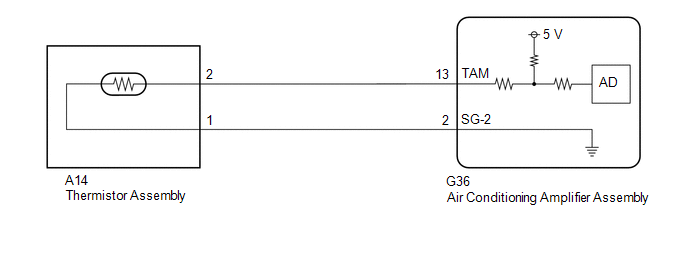
CAUTION / NOTICE / HINT
NOTICE:
- Before performing an inspection, move the vehicle to an area where all of the following conditions are met:
- The ambient temperature changes little.
- The ground temperature is low.
- There are no heat sources, such as a stove, another vehicle with its engine running or an exhaust duct, near.
- Perform the following procedure with the engine switch on (IG). Do not start the engine.
PROCEDURE
(a) Check for DTCs.
Body Electrical > Air Conditioner > Trouble Codes
|
Result | Proceed to |
|
DTC B1412 is not output |
A |
| DTC B1412 is output |
B |
| B |
 | GO TO DTC B1412 |
|
A |
 | |
| 2. |
INSPECT THERMISTOR ASSEMBLY |
(a) Remove the thermistor assembly.
Click here 
(b) Inspect the thermistor assembly.
Click here 
| NG |
 | REPLACE THERMISTOR ASSEMBLY |
|
OK |
 | |
| 3. |
CHECK HARNESS AND CONNECTOR (THERMISTOR ASSEMBLY - AIR CONDITIONING AMPLIFIER ASSEMBLY) |
(a) Disconnect the G36 air conditioning amplifier assembly connector.
(b) Measure the resistance according to the value(s) in the table below.
Standard Resistance:
|
Tester Connection | Condition |
Specified Condition |
|
A14-2 - G36-13 (TAM) |
Always | Below 1 ╬® |
|
A14-1 - G36-2 (SG-2) |
Always | Below 1 ╬® |
|
A14-2 or G36-13 (TAM) - Other terminals and body ground |
Always | 10 k╬® or higher |
|
A14-1 or G36-2 (SG-2) - Other terminals and body ground |
Always | 10 k╬® or higher |
| NG |
 | REPAIR OR REPLACE HARNESS OR CONNECTOR |
|
OK |
 | |
| 4. |
CHECK VALUE OF AMBIENT TEMPERATURE DETECTED BY THERMISTOR ASSEMBLY |
(a) Disconnect the cable from the negative (-) battery terminal and wait for at least 90 seconds.
NOTICE:
After
turning the engine switch off, waiting time may be required before
disconnecting the cable from the negative (-) battery terminal.
Therefore, make sure to read the disconnecting the cable from the
negative (-) battery terminal notices before proceeding with work.
Click here

HINT:
The
air conditioning amplifier assembly stores the value of the last
ambient temperature detected by the thermistor assembly before the
engine switch was turned off for up to 1 hour after the engine switch is
turned off. It is necessary to clear this value.
(b) Connect the cable to the negative (-) battery terminal.
(c) Measure and make a note of the ambient temperature near the thermistor assembly using a thermometer.
NOTICE:
- Perform the following procedure with the engine switch on (IG).
- Wait at least 6 minutes for the values of the thermistor assembly and thermometer to become stable before taking a measurement.
- Hold the thermometer 50 mm (1.97 in.) from the thermistor assembly with
its sensing portion at the same height and perpendicular to the
thermistor assembly.
- Hold the sensor only by its connector. Touching the sensing portion may change the resistance value.
- When measuring the ambient temperature with a thermometer, do not move
the thermometer, touch the sensing portion or allow it to contact the
vehicle body.
(d) Make a note of the ambient temperature displayed on the multi-information display in the combination meter assembly.
(e) Compare the value of the ambient temperature measured by the thermometer and the thermistor assembly.
OK:
The value of the ambient temperature measured by the thermometer and the thermistor assembly are almost the same.
| OK |
 | END |
| NG |
 | REPLACE AIR CONDITIONING AMPLIFIER ASSEMBLY |
Lost Communication with Front Panel LIN (B14B2)
DESCRIPTION
The air
conditioning control panel (radio and display receiver assembly)
communicates with the air conditioning amplifier assembly via LIN
communication.
If a malfunction occurs in the
LIN communication system, the air conditioning amplifier assembly will
not operate, even if the air conditioning control panel (radio and
display receiver assembly) is operated.
|
DTC No. | Detection Item |
DTC Detection Condition | Trouble Area |
Memory |
| B14B2 |
Lost Communication with Front Panel LIN |
Lost communication with air conditioning control assembly |
- Harness or connector
- Air conditioning control panel (radio and display receiver assembly)
- Air conditioning amplifier assembly
| Memorized (10 sec. or more)* |
- *: The air conditioning amplifier assembly stores this DTC if the
malfunction has occurred for the period of time indicated in the
brackets.
WIRING DIAGRAM
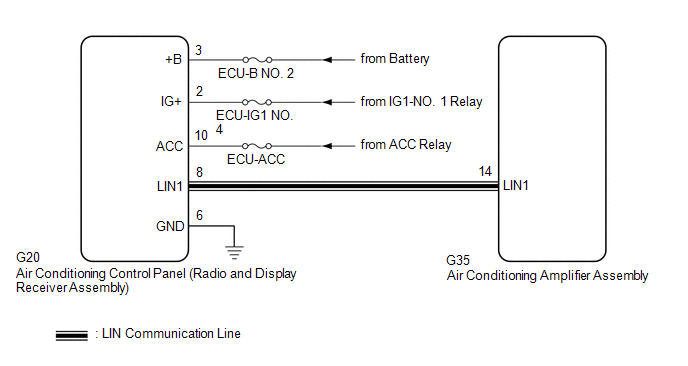
CAUTION / NOTICE / HINT
NOTICE:
Inspect the fuses for circuits related to this system before performing the following procedure.
PROCEDURE
| 1. |
CHECK
HARNESS AND CONNECTOR (AIR CONDITIONING CONTROL PANEL (RADIO AND
DISPLAY RECEIVER ASSEMBLY) - POWER SOURCE AND BODY GROUND) |
(a) Disconnect the G20 air conditioning control panel (radio and display receiver assembly) connector.
(b) Measure the voltage and resistance according to the value(s) in the table below.
Standard Voltage:
|
Tester Connection | Condition |
Specified Condition |
|
G20-3 (+B) - Body ground |
Engine switch off | 11 to 14 V |
|
G20-2 (IG+) - Body ground |
Engine switch on (IG) |
11 to 14 V |
|
G20-10 (ACC) - Body ground |
Engine switch on (ACC) |
11 to 14 V |
Standard Resistance:
|
Tester Connection | Condition |
Specified Condition |
|
G20-6 (GND) - Body ground |
Always | Below 1 ╬® |
| NG |
 | REPAIR OR REPLACE HARNESS OR CONNECTOR |
|
OK |
 | |
| 2. |
CHECK
HARNESS AND CONNECTOR (AIR CONDITIONING CONTROL PANEL (RADIO AND
DISPLAY RECEIVER ASSEMBLY) - AIR CONDITIONING AMPLIFIER ASSEMBLY) |
(a) Disconnect the G35 air conditioning amplifier assembly connector.
(b) Measure the resistance according to the value(s) in the table below.
Standard Resistance:
|
Tester Connection | Condition |
Specified Condition |
|
G20-8 (LIN1) - G35-14 (LIN1) |
Always | Below 1 ╬® |
|
G20-8 (LIN1) or G35-14 (LIN1) - Other terminals and body ground |
Always | 10 k╬® or higher |
| NG |
 | REPAIR OR REPLACE HARNESS OR CONNECTOR |
|
OK |
 | |
| 3. |
INSPECT AIR CONDITIONING AMPLIFIER ASSEMBLY |
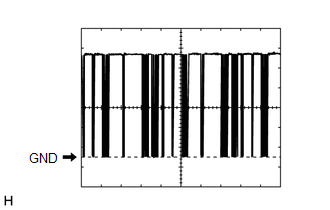
(a) Connect the G35 air conditioning amplifier assembly connector.
(b) Turn the engine switch on (IG).
(c) Using an oscilloscope, check the waveform.
|
Item | Content |
|
Terminal No. | G35-14 (LIN1) - Body ground |
|
Tool Setting | 2 V/DIV., 20 ms./DIV. |
|
Condition | Engine switch on (IG) |
OK:
Waveform is similar to that shown in the illustration.
| NG |
 | REPLACE AIR CONDITIONING AMPLIFIER ASSEMBLY |
|
OK |
 | |
| 4. |
INSPECT AIR CONDITIONING CONTROL PANEL (RADIO AND DISPLAY RECEIVER ASSEMBLY) |
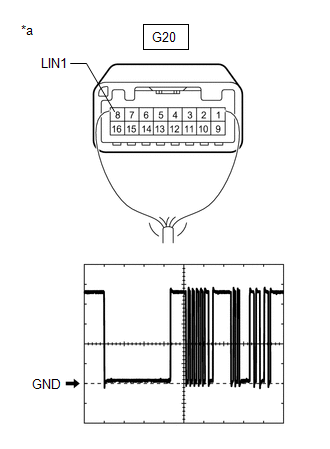
|
*a | Component with harness connected
(Air Conditioning Control Panel (Radio and Display Receiver Assembly)) |
(a) Connect the G20 air conditioning control panel (radio and display receiver assembly) connector.
(b) Turn the engine switch on (IG).
(c) Using an oscilloscope, check the waveform.
|
Item | Content |
|
Terminal No. | G20-8 (LIN1) - Body ground |
|
Tool Setting | 2 V/DIV., 20 ms./DIV. |
|
Condition | Engine switch on (IG) |
OK:
Waveform is similar to that shown in the illustration.
| OK |
 | REPLACE AIR CONDITIONING AMPLIFIER ASSEMBLY |
| NG |
 | REPLACE AIR CONDITIONING CONTROL PANEL (RADIO & DISPLAY RECEIVER ASSEMBLY) |
Refrigerant Shortage (B14B8)
DESCRIPTION
This DTC is stored if the amount of refrigerant in the air conditioning system is insufficient.
The
air conditioning amplifier assembly receives the ambient temperature
signal, refrigerant pressure signal, etc. from various sensors.
Based on these signals, the air conditioning amplifier assembly detects the amount of refrigerant.
If
the amount of refrigerant is insufficient, the A/C switch indicator
will turn off and the air conditioning system will stop operating.
|
DTC No. | Detection Item |
DTC Detection Condition | Trouble Area |
Memory |
| B14B8 |
Refrigerant Shortage | The following condition is detected in the normal operation refrigerant shortage check:
Amount of refrigerant is insufficient |
- Refrigerant line
- Cooler expansion valve
- Air conditioning amplifier assembly
- Harness or connector
- Air conditioner pressure sensor
| Memorized (10 min. or more)* |
- *: The air conditioning amplifier assembly stores this DTC if the
malfunction has occurred for the period of time indicated in the
brackets.
WIRING DIAGRAM
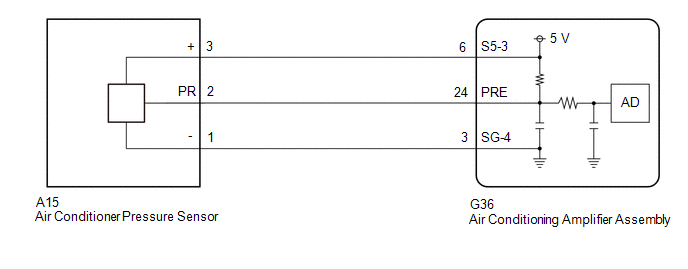
PROCEDURE
| 1. |
CHECK REFRIGERANT PRESSURE |
(a) Connect the Techstream to the DLC3.
(b) Turn the engine switch on (IG).
(c) Turn the Techstream on.
(d) Enter the following menus: Body Electrical / Air Conditioner / Data List.
(e) Read the Data List according to the display on the Techstream.
Body Electrical > Air Conditioner > Data List
|
Tester Display | Measurement Item |
Range | Normal Condition |
Diagnostic Note |
|
Regulator Pressure Sensor |
Air conditioner pressure sensor |
Min.: -66.2 psi (gauge) Max.: 478.0 psi (gauge) |
Actual refrigerant pressure displayed |
- Refrigerant line (gas leak etc.)
- Air conditioner pressure sensor circuit malfunction
|
Body Electrical > Air Conditioner > Data List
|
Tester Display |
| Regulator Pressure Sensor |
(f) Install a manifold gauge set.
Click here

(g) Read the manifold gauge set with the following conditions met.
Measurement Condition: |
Item | Condition |
|
Vehicle doors | Fully open |
|
Temperature setting | MAX COLD |
|
Blower speed | HI |
|
A/C switch | On |
|
Recirculation/fresh switch |
RECIRCULATION |
|
Interior temperature |
30 to 35┬░C (86 to 95┬░F) |
Standard Pressure:
Low pressure side
150 to 250 kPa (1.5 to 2.5 kgf/cm2, 22 to 36 psi)
High pressure side
1370 to 1570 kPa (14 to 16 kgf/cm2, 199 to 228 psi)
(h) Compare the values displayed in the Data List and on the manifold gauge set.
OK:
The values displayed in the Data List and on the manifold gauge set match.
| OK |
 | INSPECT REFRIGERANT PRESSURE WITH MANIFOLD GAUGE SET |
|
NG |
 | |
| 2. |
CHECK HARNESS AND CONNECTOR (POWER SOURCE CIRCUIT) |
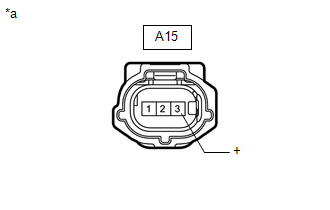
|
*a | Front view of wire harness connector
(to Air Conditioner Pressure Sensor) |
(a) Disconnect the A15 air conditioner pressure sensor connector.
(b) Measure the voltage according to the value(s) in the table below.
Standard Voltage:
|
Tester Connection | Condition |
Specified Condition |
|
A15-3 (+) - Body ground |
Engine switch on (IG) |
4.75 to 5.25 V |
| NG |
 | GO TO STEP 7 |
|
OK |
 | |
| 3. |
CHECK HARNESS AND CONNECTOR (AIR CONDITIONER PRESSURE SENSOR - BODY GROUND) |
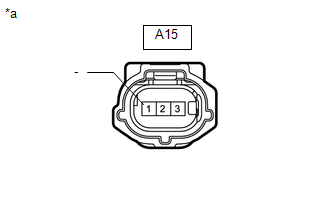
|
*a | Front view of wire harness connector
(to Air Conditioner Pressure Sensor) |
(a) Measure the resistance according to the value(s) in the table below.
Standard Resistance:
|
Tester Connection | Condition |
Specified Condition |
|
A15-1 (-) - Body ground |
Always | Below 1 ╬® |
| NG |
 | GO TO STEP 6 |
|
OK |
 | |
| 4. |
CHECK HARNESS AND CONNECTOR (AIR CONDITIONER PRESSURE SENSOR - AIR CONDITIONING AMPLIFIER ASSEMBLY) |
(a) Disconnect the G36 air conditioning amplifier assembly connector.
(b) Measure the resistance according to the value(s) in the table below.
Standard Resistance:
|
Tester Connection | Condition |
Specified Condition |
|
A15-2 (PR) - G36-24 (PRE) |
Always | Below 1 ╬® |
|
A15-2 (PR) or G36-24 (PRE) - Other terminals and body ground |
Always | 10 k╬® or higher |
| NG |
 | REPAIR OR REPLACE HARNESS OR CONNECTOR |
|
OK |
 | |
| 5. |
INSPECT AIR CONDITIONER PRESSURE SENSOR (SENSOR SIGNAL CIRCUIT) |
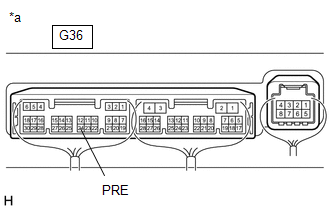
|
*a | Component with harness connected
(Air Conditioning Amplifier Assembly) |
(a) Measure the voltage with the following conditions met.
Measurement Condition: |
Item | Condition |
|
Vehicle doors | Fully open |
|
Temperature setting | MAX COLD |
|
Blower speed | HI |
|
A/C switch | On |
|
Recirculation/fresh switch |
RECIRCULATION |
|
Interior temperature |
25 to 35┬░C (77 to 95┬░F) |
NOTICE:
- If refrigerant pressure on the high pressure side becomes extremely high
during the inspection (if the voltage exceeds 4.61 V), a fail-safe
function will stop compressor operation. In this case, make sure to
measure the voltage before the fail-safe function operates.
- It is necessary to measure the voltage for a certain amount of time
(approximately 10 minutes) because the malfunction may recur after a
while.
HINT:
When the
ambient air temperature is low (below -1.5┬░C (29.3┬░F)), the compressor
with pulley will be stopped, due to inputs of the thermistor assembly
and No. 1 cooler thermistor, to prevent the evaporator from freezing. In
this case, perform the inspection in a warm indoor environment.
(1) Measure the voltage according to the value(s) in the table below.
Standard Voltage:
|
Tester Connection | Condition |
Specified Condition |
|
G36-24 (PRE) - Body ground |
Engine switch on (IG) (A/C switch: On) |
0.74 to 4.61 V |
(b) Connect the Techstream to the DLC3.
(c) Turn the engine switch on (IG).
(d) Turn the Techstream on.
(e) Enter the following menus: Body Electrical / Air Conditioner / Data List.
(f) Read the Data List according to the display on the Techstream.
Body Electrical > Air Conditioner > Data List
|
Tester Display | Measurement Item |
Range | Normal Condition |
Diagnostic Note |
|
Regulator Pressure Sensor |
Air conditioner pressure sensor |
Min.: -66.2 psi (gauge) Max.: 478.0 psi (gauge) |
Actual refrigerant pressure displayed |
- Refrigerant line (gas leak etc.)
- Air conditioner pressure sensor circuit malfunction
|
Body Electrical > Air Conditioner > Data List
|
Tester Display |
| Regulator Pressure Sensor |
OK:
The voltage and value displayed in the Data List change.
|
Result | Proceed to |
|
OK | A |
|
NG (The voltage changes but the value displayed in the Data List does not change.) |
|
NG (The voltage does not change.) |
B |
| A |
 | REPLACE AIR CONDITIONING AMPLIFIER ASSEMBLY |
| B |
 | REPLACE AIR CONDITIONER PRESSURE SENSOR |
| 6. |
CHECK HARNESS AND CONNECTOR (AIR CONDITIONER PRESSURE SENSOR - AIR CONDITIONING AMPLIFIER ASSEMBLY) |
(a) Disconnect the G36 air conditioning amplifier assembly connector.
(b) Measure the resistance according to the value(s) in the table below.
Standard Resistance:
|
Tester Connection | Condition |
Specified Condition |
|
A15-1 (-) - G36-3 (SG-4) |
Always | Below 1 ╬® |
|
A15-1 (-) or G36-3 (SG-4) - Other terminals and body ground |
Always | 10 k╬® or higher |
| OK |
 | REPLACE AIR CONDITIONING AMPLIFIER ASSEMBLY |
| NG |
 | REPAIR OR REPLACE HARNESS OR CONNECTOR |
| 7. |
CHECK HARNESS AND CONNECTOR (AIR CONDITIONER PRESSURE SENSOR - AIR CONDITIONING AMPLIFIER ASSEMBLY) |
(a) Disconnect the G36 air conditioning amplifier assembly connector.
(b) Measure the resistance according to the value(s) in the table below.
Standard Resistance:
|
Tester Connection | Condition |
Specified Condition |
|
A15-3 (+) - G36-6 (S5-3) |
Always | Below 1 ╬® |
|
A15-3 (+) or G36-6 (S5-3) - Other terminals and body ground |
Always | 10 k╬® or higher |
| OK |
 | REPLACE AIR CONDITIONING AMPLIFIER ASSEMBLY |
| NG |
 | REPAIR OR REPLACE HARNESS OR CONNECTOR |
Refrigerant Overabundance Filling Malfunction (B14BD)
DESCRIPTION
This DTC is
stored if the amount of refrigerant in the in the air conditioning
system exceeds a threshold. The air conditioning amplifier assembly
judges whether the amount of refrigerant is appropriate based on the
detected refrigerant pressure and cooler compressor assembly operation
current. If the amount of refrigerant in the system is determined to
have exceeded a threshold, operation of the cooler compressor assembly
will be stopped, and will remain stopped even if the engine switch is
turned off and then the engine is restarted.
|
DTC No. | Detection Item |
DTC Detection Condition | Trouble Area |
Memory |
| B14BD |
Refrigerant Overabundance Filling Malfunction |
All of the following conditions are met 2 times or more in the same trip:
- The vehicle speed is 20 km/h or more
- The amount of compressor oil is within the insufficient compressor oil range for 60 seconds or more
|
- Refrigerant volume
- Air conditioning amplifier assembly
| Memorized (60 sec. or more)* |
- *: The air conditioning amplifier assembly stores this DTC if the
malfunction has occurred for the period of time indicated in the
brackets.

|
*a | Electric Current (mA) |
*b | Refrigerant Pressure kPa (kgf/cm2, psi) |
PROCEDURE
| 1. |
RECOVER REFRIGERANT FROM REFRIGERATION SYSTEM |
(a) Recover the refrigerant from the air conditioning system using a refrigerant recovery unit.
Click here 
|
NEXT |
 | |
| 2. |
CHARGE AIR CONDITIONING SYSTEM WITH REFRIGERANT |
(a) Charge the air conditioning system with refrigerant.
Click here

| NEXT |  |
END |
Room Temperature Sensor Circuit (B1411)
DESCRIPTION
The cooler
(room temp. sensor) thermistor is installed in the instrument panel to
detect the cabin temperature, which is used to control the air
conditioning system. The resistance of the cooler (room temp. sensor)
thermistor changes in accordance with the cabin temperature. As the
temperature decreases, the resistance increases. As the temperature
increases, the resistance decreases.
The air
conditioning amplifier assembly applies voltage (5 V) to the cooler
(room temp. sensor) thermistor and reads voltage changes due to changes
in the resistance of the cooler (room temp. sensor) thermistor.
|
DTC No. | Detection Item |
DTC Detection Condition | Trouble Area |
Memory |
| B1411 |
Room Temperature Sensor Circuit |
Open or short in room temperature sensor circuit |
- Cooler (room temp. sensor) thermistor
- Harness or connector
- Air conditioning amplifier assembly
| Memorized (4 sec. or more)* |
- *: The air conditioning amplifier assembly stores this DTC if the
malfunction has occurred for the period of time indicated in the
brackets.
HINT:
If the cabin temperature is approximately -18.6┬░C (-1.48┬░F) or lower, DTC B1411 may be stored even though the system is normal.
WIRING DIAGRAM
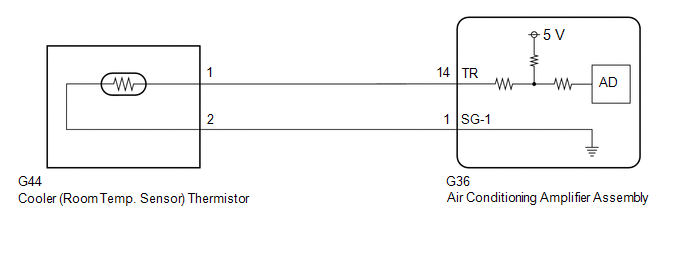
PROCEDURE
| 1. |
READ VALUE USING TECHSTREAM |
(a) Connect the Techstream to the DLC3.
(b) Turn the engine switch on (IG).
(c) Turn the Techstream on.
(d) Enter the following menus: Body Electrical / Air Conditioner / Data List.
(e) Read the Data List according to the display on the Techstream.
Body Electrical > Air Conditioner > Data List
|
Tester Display | Measurement Item |
Range | Normal Condition |
Diagnostic Note |
|
Room Temperature Sensor |
Cooler (room temp. sensor) thermistor |
Min.: -6.50┬░C (20.30┬░F) Max.: 57.25┬░C (135.05┬░F) |
Actual cabin temperature displayed |
Cooler (room temp. sensor) thermistor circuit malfunction
- When open circuit: -6.50┬░C (20.30┬░F)
- When short circuit: 57.25┬░C (135.05┬░F)
|
Body Electrical > Air Conditioner > Data List
|
Tester Display |
| Room Temperature Sensor |
OK:
The display is as specified in the normal condition column.
| OK |
 | REPLACE AIR CONDITIONING AMPLIFIER ASSEMBLY |
|
NG |
 | |
| 2. |
INSPECT COOLER (ROOM TEMP. SENSOR) THERMISTOR |
(a) Remove the cooler (room temp. sensor) thermistor.
Click here

(b) Inspect the cooler (room temp. sensor) thermistor.
Click here 
| NG |
 | REPLACE COOLER (ROOM TEMP. SENSOR) THERMISTOR |
|
OK |
 | |
| 3. |
CHECK HARNESS AND CONNECTOR (COOLER (ROOM TEMP. SENSOR) THERMISTOR - AIR CONDITIONING AMPLIFIER ASSEMBLY) |
(a) Disconnect the G36 air conditioning amplifier assembly connector.
(b) Measure the resistance according to the value(s) in the table below.
Standard Resistance:
|
Tester Connection | Condition |
Specified Condition |
|
G44-1 - G36-14 (TR) | Always |
Below 1 ╬® |
|
G44-2 - G36-1 (SG-1) |
Always | Below 1 ╬® |
|
G44-1 or G36-14 (TR) - Other terminals and body ground |
Always | 10 k╬® or higher |
|
G44-2 or G36-1 (SG-1) - Other terminals and body ground |
Always | 10 k╬® or higher |
| OK |
 | REPLACE AIR CONDITIONING AMPLIFIER ASSEMBLY |
| NG |
 | REPAIR OR REPLACE HARNESS OR CONNECTOR |
Ambient Temperature Sensor Circuit (B1412)
DESCRIPTION
The thermistor
assembly is installed in front of the cooler condenser assembly to
detect the ambient temperature, which is used to control the air
conditioning system. This sensor is connected to the air conditioning
amplifier assembly and detects fluctuations in the ambient temperature.
This data is used for controlling the cabin temperature. The sensor
sends a signal to the air conditioning amplifier assembly. The
resistance of the thermistor assembly changes in accordance with the
ambient temperature. As the temperature decreases, the resistance
increases. As the temperature increases, the resistance decreases.
The
air conditioning amplifier assembly applies voltage (5 V) to the
thermistor assembly and reads voltage changes due to changes in the
resistance of the thermistor assembly.
|
DTC No. | Detection Item |
DTC Detection Condition | Trouble Area |
Memory |
| B1412 |
Ambient Temperature Sensor Circuit |
Open or short in ambient temperature sensor circuit |
- Thermistor assembly
- Air conditioning amplifier assembly
- Harness or connector
| Memorized (4 sec. or more)* |
- *: The air conditioning amplifier assembly stores this DTC if the
malfunction has occurred for the period of time indicated in the
brackets.
HINT:
If the
ambient temperature is approximately -52.9┬░C (-63.22┬░F) or lower, DTC
B1412 may be stored even though the system is normal.
WIRING DIAGRAM
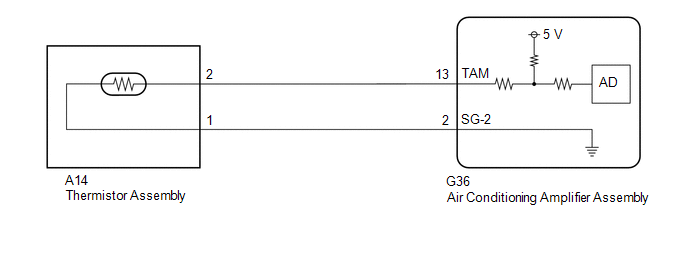
PROCEDURE
| 1. |
READ VALUE USING TECHSTREAM |
(a) Connect the Techstream to the DLC3.
(b) Turn the engine switch on (IG).
(c) Turn the Techstream on.
(d) Enter the following menus: Body Electrical / Air Conditioner / Data List.
(e) Read the Data List according to the display on the Techstream.
Body Electrical > Air Conditioner > Data List
|
Tester Display | Measurement Item |
Range | Normal Condition |
Diagnostic Note |
|
Ambient Temp Sensor | Thermistor assembly |
Min.: -23.30┬░C (-9.94┬░F) Max.: 65.95┬░C (150.71┬░F) |
Actual ambient temperature displayed |
Thermistor assembly circuit malfunction
- When open circuit: -23.30┬░C (-9.94┬░F)
- When short circuit: 65.95┬░C (150.71┬░F)
|
Body Electrical > Air Conditioner > Data List
|
Tester Display |
| Ambient Temp Sensor |
OK:
The display is as specified in the normal condition column.
| OK |
 | REPLACE AIR CONDITIONING AMPLIFIER ASSEMBLY |
|
NG |
 | |
| 2. |
INSPECT THERMISTOR ASSEMBLY |
(a) Remove the thermistor assembly.
Click here 
(b) Inspect the thermistor assembly.
Click here 
| NG |
 | REPLACE THERMISTOR ASSEMBLY |
|
OK |
 | |
| 3. |
CHECK HARNESS AND CONNECTOR (THERMISTOR ASSEMBLY - AIR CONDITIONING AMPLIFIER ASSEMBLY) |
(a) Disconnect the G36 air conditioning amplifier assembly connector.
(b) Measure the resistance according to the value(s) in the table below.
Standard Resistance:
|
Tester Connection | Condition |
Specified Condition |
|
A14-2 - G36-13 (TAM) |
Always | Below 1 ╬® |
|
A14-1 - G36-2 (SG-2) |
Always | Below 1 ╬® |
|
A14-2 or G36-13 (TAM) - Other terminals and body ground |
Always | 10 k╬® or higher |
|
A14-1 or G36-2 (SG-2) - Other terminals and body ground |
Always | 10 k╬® or higher |
| OK |
 | REPLACE AIR CONDITIONING AMPLIFIER ASSEMBLY |
| NG |
 | REPAIR OR REPLACE HARNESS OR CONNECTOR |
Evaporator Temperature Circuit or Evaporator Fin Thermistor (B1413)
DESCRIPTION
The No. 1
cooler thermistor is installed to the evaporator in the air conditioner
unit to detect the temperature of the cooled air that has passed through
the evaporator, which is used to control the air conditioning system.
It sends signals to the air conditioning amplifier assembly. The
resistance of the No. 1 cooler thermistor changes in accordance with the
temperature of the cooled air that has passed through the evaporator.
As the temperature decreases, the resistance increases. As the
temperature increases, the resistance decreases.
The
air conditioning amplifier assembly applies voltage (5 V) to the No. 1
cooler thermistor and reads voltage changes as the resistance of the No.
1 cooler thermistor changes. This sensor is used for frost prevention.
|
DTC No. | Detection Item |
DTC Detection Condition | Trouble Area |
Memory |
| B1413 |
Evaporator Temperature Circuit or Evaporator Fin Thermistor |
Open or short in evaporator temperature sensor circuit |
- No. 1 cooler thermistor
- Air conditioning harness assembly
- Air conditioning amplifier assembly
| Memorized (4 sec. or more)* |
- *: The air conditioning amplifier assembly stores this DTC if the
malfunction has occurred for the period of time indicated in the
brackets.
WIRING DIAGRAM
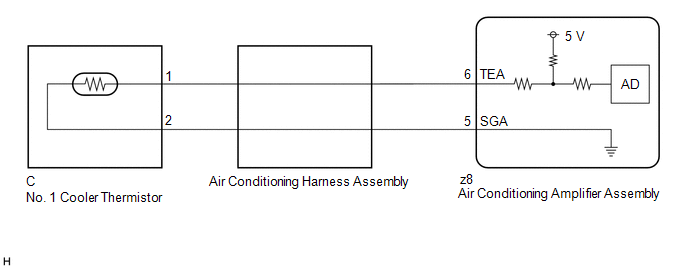
PROCEDURE
| 1. |
READ VALUE USING TECHSTREAM |
(a) Connect the Techstream to the DLC3.
(b) Turn the engine switch on (IG)
(c) Turn the Techstream on.
(d) Enter the following menus: Body Electrical / Air Conditioner / Data List.
(e) Read the Data List according to the display on the Techstream.
Body Electrical > Air Conditioner > Data List
|
Tester Display | Measurement Item |
Range | Normal Condition |
Diagnostic Note |
|
Evaporator Fin Thermistor |
No. 1 cooler thermistor |
Min.: -29.70┬░C (-21.46┬░F) Max.: 59.55┬░C (139.19┬░F) |
Actual evaporator temperature displayed |
No. 1 cooler thermistor circuit malfunction
- When open circuit: -29.70┬░C (-21.46┬░F)
- When short circuit: 59.55┬░C (139.19┬░F)
|
Body Electrical > Air Conditioner > Data List
|
Tester Display |
| Evaporator Fin Thermistor |
OK:
The display is as specified in the normal condition column.
| OK |
 | REPLACE AIR CONDITIONING AMPLIFIER ASSEMBLY |
|
NG |
 | |
| 2. |
INSPECT NO. 1 COOLER THERMISTOR |
(a) Remove the No. 1 cooler thermistor.
Click here 
(b) Inspect the No. 1 cooler thermistor.
Click here 
| NG |
 | REPLACE NO. 1 COOLER THERMISTOR |
|
OK |
 | |
| 3. |
INSPECT AIR CONDITIONING HARNESS ASSEMBLY |

|
*a | Front view of wire harness connector
(to Air Conditioning Amplifier Assembly) |
*b | Front view of wire harness connector
(to No. 1 Cooler Thermistor) |
(a) Remove the air conditioning harness assembly.
Click here 
(b) Measure the resistance according to the value(s) in the table below.
Standard Resistance:
|
Tester Connection | Condition |
Specified Condition |
|
z8-5 (SGA) - C-2 | Always |
Below 1 ╬® |
|
z8-6 (TEA) - C-1 | Always |
Below 1 ╬® |
| OK |
 | REPLACE AIR CONDITIONING AMPLIFIER ASSEMBLY |
| NG |
 | REPLACE AIR CONDITIONING HARNESS ASSEMBLY |
Compressor Lock (B1422)
DESCRIPTION
The ECM sends the engine speed signal to the air conditioning amplifier assembly via CAN communication.
The
air conditioning amplifier assembly reads the difference between
compressor speed and engine speed. If the difference becomes excessively
large, the air conditioning amplifier assembly determines that the
compressor is locked, and turns the magnet clutch assembly off.
|
DTC No. | Detection Item |
DTC Detection Condition | Trouble Area |
Memory |
| B1422 |
Compressor Lock | Open or short in A/C lock sensor circuit |
- Magnet clutch assembly
- Harness or connector
- Air conditioning amplifier assembly
| Memorized (3 seconds or more) |
HINT:
The
air conditioning amplifier assembly stores the DTC if the malfunction
has occurred for the period of time indicated in the brackets.
WIRING DIAGRAM
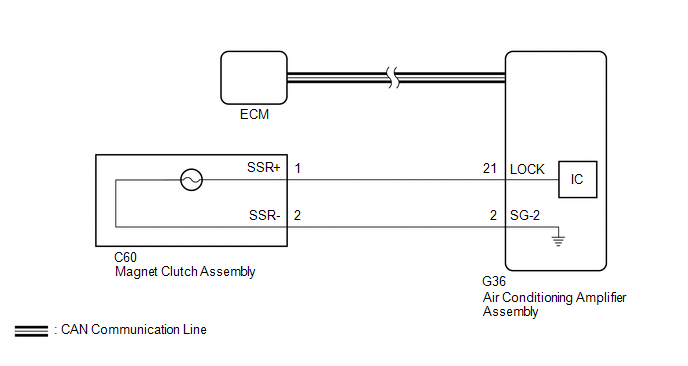
CAUTION / NOTICE / HINT
NOTICE:
- The air conditioning system uses the CAN communication system. Inspect
the communication function by following How to Proceed with
Troubleshooting. Troubleshoot the air conditioning system after
confirming that the communication system is functioning properly.
Click here 
- ECM malfunctions can affect the storage of this DTC. Therefore, check
all SFI system DTCs and confirm that the system is normal before
performing the following inspection.
Click here 
- After replacing the air conditioning amplifier assembly, make sure to perform Initialization Servo Motor.
Click here 
PROCEDURE
|
1. | INSPECT MAGNET CLUTCH ASSEMBLY |
(a) Remove the compressor assembly with magnetic clutch.
Click here

(b) Inspect the magnet clutch assembly.
Click here 
| NG |
 | REPLACE MAGNET CLUTCH ASSEMBLY |
|
OK |
 | |
| 2. |
CHECK HARNESS AND CONNECTOR (MAGNET CLUTCH ASSEMBLY - AIR CONDITIONING AMPLIFIER ASSEMBLY) |
(a) Disconnect the G36 air conditioning amplifier assembly connector.
(b) Measure the resistance according to the value(s) in the table below.
Standard Resistance:
|
Tester Connection | Condition |
Specified Condition |
|
C60-1 (SSR+) - G36-21 (LOCK) |
Always | Below 1 ╬® |
|
C60-2 (SSR-) - G36-2 (SG-2) |
Always | Below 1 ╬® |
|
C60-1 (SSR+) or G36-21 (LOCK) - Other terminals and body ground |
Always | 10 k╬® or higher |
|
C60-2 (SSR-) or G36-2 (SG-2) - Other terminals and body ground |
Always | 10 k╬® or higher |
| OK |
 | REPLACE AIR CONDITIONING AMPLIFIER ASSEMBLY |
| NG |
 | REPAIR OR REPLACE HARNESS OR CONNECTOR |
Open in Pressure Sensor Circuit / Abnormal Refrigerant Pressure (B1423)
DESCRIPTION
This DTC is
stored if refrigerant pressure on the high pressure side is extremely
low (176 kPa (1.8 kgf/cm2, 26 psi) or less) or extremely high (3025 kPa
(30.8 kgf/cm2, 439 psi) or more). The air conditioner pressure sensor,
which is installed to the high pressure side pipe to detect refrigerant
pressure, sends a refrigerant pressure signal to the air conditioning
amplifier assembly. The air conditioning amplifier assembly converts
this signal to a pressure value according to the sensor characteristics
and uses it to control the compressor.
|
DTC No. | Detection Item |
DTC Detection Condition | Trouble Area |
Memory |
| B1423 |
Open in Pressure Sensor Circuit / Abnormal Refrigerant Pressure |
- Open or short in air conditioner pressure sensor circuit
- Refrigerant pressure on high pressure side is extremely low (176 kPa
(1.8 kgf/cm2, 26 psi) or less) or extremely high (3025 kPa (30.8
kgf/cm2, 439 psi) or more)
|
- Air conditioner pressure sensor
- Harness or connector
- Air conditioning amplifier assembly
- Cooler expansion valve (blocked, stuck)
- Cooler condenser assembly (blocked, deterioration of cooling capacity due to dirt)
- Cooler dryer (moisture in the refrigerant cycle cannot be absorbed)
- Cooling fan system (cooler condenser assembly cannot be cooled down)
- Air conditioning system (leaks, blocked)
- Refrigerant volume (excessive, low)
| - |
WIRING DIAGRAM
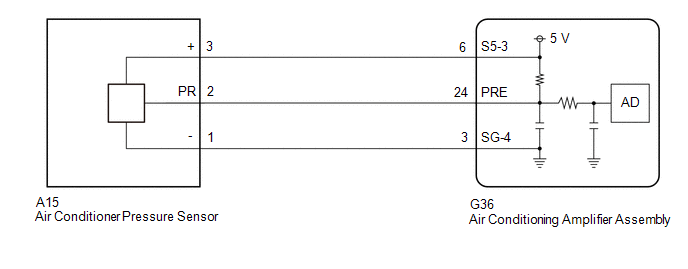
CAUTION / NOTICE / HINT
HINT:
If DTC B1423 and B14B8 are output at the same time, troubleshoot for DTC B14B8 first.
Click here 
PROCEDURE
| 1. |
PERFORM REFRIGERANT SHORTAGE CHECK |
(a) Connect the Techstream to the DLC3.
(b) Turn the engine switch on (IG).
(c) Turn the Techstream on.
(d) Enter the following menus: Body Electrical / Air Conditioner / Utility / Refrigerant Gas Volume Check.
Body Electrical > Air Conditioner > Utility
|
Tester Display |
| Refrigerant Gas Volume Check |
(e)
Check that the following conditions are met and perform the refrigerant
shortage check according to the display on the Techstream.
Measurement Condition: |
Item | Condition |
|
A/C switch | On |
|
Ambient temperature* |
0 to 49┬░C (32 to 120┬░F) |
|
Blower speed | HI |
*: If the ambient temperature is not within the range shown, do not perform this check.
|
Result | Amount of Refrigerant |
|
Refrigerant correct | Correct |
|
Refrigerant shortage |
Insufficient |
OK:
"Refrigerant correct" is displayed on the Techstream.
| NG |
 | GO TO STEP 14 |
|
OK |
 | |
| 2. |
CHECK REFRIGERANT PRESSURE |
(a) Connect the Techstream to the DLC3.
(b) Turn the engine switch on (IG).
(c) Turn the Techstream on.
(d) Enter the following menus: Body Electrical / Air Conditioner / Data List.
(e) Read the Data List according to the display on the Techstream.
Body Electrical > Air Conditioner > Data List
|
Tester Display | Measurement Item |
Range | Normal Condition |
Diagnostic Note |
|
Regulator Pressure Sensor |
Air conditioner pressure sensor |
Min.: -66.2 psi (gauge) Max.: 478.0 psi (gauge) |
Actual refrigerant pressure displayed |
- Refrigerant line (gas leak etc.)
- Air conditioner pressure sensor circuit malfunction
|
Body Electrical > Air Conditioner > Data List
|
Tester Display |
| Regulator Pressure Sensor |
(f) Install a manifold gauge set.
Click here

(g) Read the manifold gauge set with the following conditions met.
Measurement Condition: |
Item | Condition |
|
Vehicle doors | Fully open |
|
Temperature setting | MAX COLD |
|
Blower speed | HI |
|
A/C switch | On |
|
Recirculation/fresh switch |
RECIRCULATION |
|
Interior temperature |
25 to 35┬░C (77 to 95┬░F) |
Standard Pressure:
Low pressure side
150 to 250 kPa (1.5 to 2.5 kgf/cm2, 22 to 36 psi)
High pressure side
1370 to 1570 kPa (14 to 16 kgf/cm2, 199 to 228 psi)
(h) Compare the values displayed in the Data List and on the manifold gauge set.
OK:
The values displayed in the Data List and on the manifold gauge set match.
| NG |
 | GO TO STEP 8 |
|
OK |
 | |
| 3. |
CHECK REFRIGERANT HIGH PRESSURE HISTORY |
(a) Connect the Techstream to the DLC3.
(b) Turn the engine switch on (IG).
(c) Enter the following menus: Body Electrical / Air Conditioner / Data List.
(d) Read the Data List according to the display on the Techstream.
Body Electrical > Air Conditioner > Data List
|
Tester Display | Measurement Item |
Range | Normal Condition |
Diagnostic Note |
|
Refrigerant High Pressure History |
Refrigerant high pressure history |
Min.: 0 Max.: 255 |
Number of times refrigerant high pressure history stored displayed |
- |
Body Electrical > Air Conditioner > Data List
|
Tester Display |
| Refrigerant High Pressure History |
|
Result | Proceed to |
|
The value is 0 | A |
|
The value is not 0 | B |
| A |
 | INSPECT REFRIGERANT PRESSURE WITH MANIFOLD GAUGE SET |
|
B |
 | |
| 4. |
INSPECT COOLING FAN SYSTEM |
(a) Check if the cooling fan operates normally.
Click here 
| NG |
 | GO TO COOLING FAN SYSTEM |
|
OK |
 | |
| 5. |
RECOVER REFRIGERANT FROM REFRIGERATION SYSTEM |
(a) Recover the refrigerant from the air conditioning system using a refrigerant recovery unit.
Click here 
|
NEXT |
 | |
| 6. |
CHARGE AIR CONDITIONING SYSTEM WITH REFRIGERANT |
Click here 
|
NEXT |
 | |
| 7. |
PERFORM REFRIGERANT HIGH PRESSURE HISTORY CLEAR |
(a) Clear the refrigerant high pressure history stored in the air conditioning amplifier assembly.
Click here 
| NEXT |
 | END |
| 8. |
CHECK HARNESS AND CONNECTOR (POWER SOURCE CIRCUIT) |
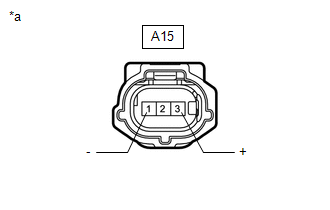
|
*a | Front view of wire harness connector
(to Air Conditioner Pressure Sensor) |
(a) Disconnect the A15 air conditioner pressure sensor connector.
(b) Measure the voltage according to the value(s) in the table below.
Standard Voltage:
|
Tester Connection | Condition |
Specified Condition |
|
A15-3 (+) - A15-1 (-) |
Engine switch on (IG) |
4.75 to 5.25 V |
| NG |
 | GO TO STEP 13 |
|
OK |
 | |
| 9. |
CHECK HARNESS AND CONNECTOR (AIR CONDITIONER PRESSURE SENSOR - BODY GROUND) |
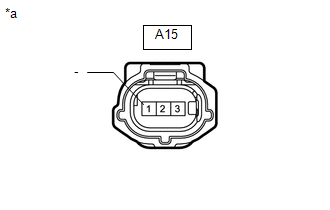
|
*a | Front view of wire harness connector
(to Air Conditioner Pressure Sensor) |
(a) Measure the resistance according to the value(s) in the table below.
Standard Resistance:
|
Tester Connection | Condition |
Specified Condition |
|
A15-1 (-) - Body ground |
Always | Below 1 ╬® |
| NG |
 | GO TO STEP 12 |
|
OK |
 | |
| 10. |
CHECK HARNESS AND CONNECTOR (AIR CONDITIONER PRESSURE SENSOR - AIR CONDITIONING AMPLIFIER ASSEMBLY) |
(a) Disconnect the G36 air conditioning amplifier assembly connector.
(b) Measure the resistance according to the value(s) in the table below.
Standard Resistance:
|
Tester Connection | Condition |
Specified Condition |
|
A15-2 (PR) - G36-24 (PRE) |
Always | Below 1 ╬® |
|
A15-2 (PR) or G36-24 (PRE) - Other terminals and body ground |
Always | 10 k╬® or higher |
| NG |
 | REPAIR OR REPLACE HARNESS OR CONNECTOR |
|
OK |
 | |
| 11. |
INSPECT AIR CONDITIONER PRESSURE SENSOR (SENSOR SIGNAL CIRCUIT) |

|
*a | Component with harness connected
(Air Conditioning Amplifier Assembly) |
(a) Measure the voltage with the following conditions met.
Measurement Condition: |
Item | Condition |
|
Vehicle doors | Fully open |
|
Temperature setting | MAX COLD |
|
Blower speed | HI |
|
A/C switch | On |
|
Recirculation/fresh switch |
RECIRCULATION |
|
Interior temperature |
25 to 35┬░C (77 to 95┬░F) |
NOTICE:
- If refrigerant pressure on the high pressure side becomes extremely high
during the inspection (if the voltage exceeds 4.61 V), a fail-safe
function will stop compressor operation. In this case, make sure to
measure the voltage before the fail-safe function operates.
- It is necessary to measure the voltage for a certain amount of time
(approximately 10 minutes) because the malfunction may recur after a
while.
HINT:
When the
ambient air temperature is low(below -1.5┬░C (29.3┬░F)), the compressor
with pulley will be stopped, due to inputs of the thermistor assembly
and No. 1 cooler thermistor, to prevent the evaporator from freezing. In
this case, perform the inspection in a warm indoor environment.
(1) Measure the voltage according to the value(s) in the table below.
Standard Voltage:
|
Tester Connection | Condition |
Specified Condition |
|
G36-24 (PRE) - Body ground |
Engine switch on (IG) (A/C switch: On) |
0.74 to 4.61 V |
(b) Connect the Techstream to the DLC3.
(c) Turn the engine switch on (IG).
(d) Turn the Techstream on.
(e) Enter the following menus: Body Electrical / Air Conditioner / Data List.
(f) Read the Data List according to the display on the Techstream.
Body Electrical > Air Conditioner > Data List
|
Tester Display | Measurement Item |
Range | Normal Condition |
Diagnostic Note |
|
Regulator Pressure Sensor |
Air conditioner pressure sensor |
Min.: -66.2 psi (gauge) Max.: 478.0 psi (gauge) |
Actual refrigerant pressure displayed |
- Refrigerant line (gas leak etc.)
- Air conditioner pressure sensor circuit malfunction
|
Body Electrical > Air Conditioner > Data List
|
Tester Display |
| Regulator Pressure Sensor |
OK:
The voltage and value displayed in the Data List change.
|
Result | Proceed to |
|
OK | A |
|
NG (The voltage changes but the value displayed in the Data List does not change.) |
|
NG (The voltage does not change.) |
B |
| A |
 | REPLACE AIR CONDITIONING AMPLIFIER ASSEMBLY |
| B |
 | REPLACE AIR CONDITIONER PRESSURE SENSOR |
| 12. |
CHECK HARNESS AND CONNECTOR (AIR CONDITIONER PRESSURE SENSOR - AIR CONDITIONING AMPLIFIER ASSEMBLY) |
(a) Disconnect the G36 air conditioning amplifier assembly connector.
(b) Measure the resistance according to the value(s) in the table below.
Standard Resistance:
|
Tester Connection | Condition |
Specified Condition |
|
A15-1 (-) - G36-3 (SG-4) |
Always | Below 1 ╬® |
|
A15-1 (-) or G36-3 (SG-4) - Other terminals and body ground |
Always | 10 k╬® or higher |
| OK |
 | REPLACE AIR CONDITIONING AMPLIFIER ASSEMBLY |
| NG |
 | REPAIR OR REPLACE HARNESS OR CONNECTOR |
| 13. |
CHECK HARNESS AND CONNECTOR (AIR CONDITIONER PRESSURE SENSOR - AIR CONDITIONING AMPLIFIER ASSEMBLY) |
(a) Disconnect the G36 air conditioning amplifier assembly connector.
(b) Measure the resistance according to the value(s) in the table below.
Standard Resistance:
|
Tester Connection | Condition |
Specified Condition |
|
A15-3 (+) - G36-6 (S5-3) |
Always | Below 1 ╬® |
|
A15-3 (+) or G36-6 (S5-3) - Other terminals and body ground |
Always | 10 k╬® or higher |
| OK |
 | REPLACE AIR CONDITIONING AMPLIFIER ASSEMBLY |
| NG |
 | REPAIR OR REPLACE HARNESS OR CONNECTOR |
| 14. |
REPAIR AIR CONDITIONING SYSTEM LEAK |
(a) Identify the area where refrigerant is leaking from.
Click here 
(b) Repair the identified area of the air conditioning system.
(c) Evacuate the air conditioning system.
| NEXT |
 | CHARGE SYSTEM WITH REFRIGERANT |
Air Mix Damper Control Servo Motor Circuit (Passenger Side) (B1441,B1443,B1446)
DESCRIPTION
- B1441: The No. 1 air conditioning radiator damper servo sub-assembly
(front passenger side air mix) sends pulse signals to inform the air
conditioning amplifier assembly of the damper position. The air
conditioning amplifier assembly activates the motor (normal or reverse)
based on these signals to move the No. 1 air conditioning radiator
damper servo sub-assembly (front passenger side air mix) to the
appropriate position. This adjusts the amount of air passing through the
heater core after passing the evaporator and controls the temperature
of the output air. The air conditioning amplifier assembly communicates
with the servo through a communication/driver IC and wiring assembly
called the air conditioning harness assembly.
- B1443: The No. 1 air conditioning radiator damper servo sub-assembly
(mode) sends pulse signals to inform the air conditioning amplifier
assembly of the damper position. The air conditioning amplifier assembly
activates the motor (normal or reverse) based on these signals to move
the air outlet damper to the appropriate position, which controls the
air outlet switching. The air conditioning amplifier assembly
communicates with the servo through a communication/driver IC and wiring
assembly called the air conditioning harness assembly.
- B1446: The No. 1 air conditioning radiator damper servo sub-assembly
(driver side air mix) sends pulse signals to inform the air conditioning
amplifier assembly of the damper position. The air conditioning
amplifier assembly activates the motor (normal or reverse) based on
these signals to move the No. 1 air conditioning radiator damper servo
sub-assembly (driver side air mix) to the appropriate position. As a
result, the amount of air passing through the heater core after passing
through the evaporator is adjusted, and the temperature of the air
blowing toward the driver side is controlled. The air conditioning
amplifier assembly communicates with the servo through a
communication/driver IC and wiring assembly called the air conditioning
harness assembly.
|
DTC No. | Detection Item |
DTC Detection Condition | Trouble Area |
Memory |
| B1441 |
Air Mix Damper Control Servo Motor Circuit (Passenger Side) |
Air
mix damper position sensor value does not change even if air
conditioning amplifier assembly operates No. 1 air conditioning radiator
damper servo sub-assembly (front passenger side air mix) |
- No. 1 air conditioning radiator damper servo sub-assembly (front passenger side air mix)
- Air conditioning harness assembly
- Air conditioning amplifier assembly
- Air conditioning radiator assembly
| Memorized (30 sec. or more)* |
|
B1443 | Air Outlet Damper Control Servo Motor Circuit |
Air
outlet damper position sensor value does not change even if air
conditioning amplifier assembly operates No. 1 air conditioning radiator
damper servo sub-assembly (mode) |
- No. 1 air conditioning radiator damper servo sub-assembly (mode)
- Air conditioning harness assembly
- Air conditioning amplifier assembly
- Air conditioning radiator assembly
| Memorized (30 sec. or more)* |
|
B1446 | Air Mix Damper Control Servo Motor Circuit (Driver Side) |
Air
mix damper position sensor value does not change even if air
conditioning amplifier assembly operates No. 1 air conditioning radiator
damper servo sub-assembly (driver side air mix) |
- No. 1 air conditioning radiator damper servo sub-assembly (driver side air mix)
- Air conditioning harness assembly
- Air conditioning amplifier assembly
- Air conditioning radiator assembly
| Memorized (30 sec. or more)* |
- *: The air conditioning amplifier assembly stores this DTC if the
malfunction has occurred for the period of time indicated in the
brackets.
DTC Detection Condition Combination Table | |
Vehicle Condition |
|
Pattern 1 | Pattern 2 |
|
Diagnosis Condition | No. 1 air conditioning radiator damper servo sub-assembly operating |
ŌŚŗ | ŌŚŗ |
|
Malfunction | Damper servo operation request signals are output but the damper position sensor value does not change |
ŌŚŗ | - |
|
Damper servo operation request signals are output but the damper position sensor value is abnormal |
- | ŌŚŗ |
|
Detection Time | Continuously for 30 seconds or more |
Continuously for 30 seconds or more |
|
Trip Count | 1 trip |
1 trip |
HINT:
If the conditions of either of these patterns are detected, a DTC will be stored.
WIRING DIAGRAM

CAUTION / NOTICE / HINT
HINT:
- Confirm that no mechanical problems are present because this DTC can be
stored when either a damper link or damper is mechanically locked.
- When installing a damper servo motor, make sure to install it correctly.
Click here 
- After replacing a damper servo motor, make sure to perform Servo Motor Initialization.
Click here 
PROCEDURE
(a) Check for DTCs.
Body Electrical > Air Conditioner > Trouble Codes
|
Result | Proceed to |
|
Only B1497 is output |
A |
| B1441, B1442, B1443 and B1446 are output |
B |
| B1441, B1443 or B1446 is output |
C |
| A |
 | GO TO DTC B1497 |
| B |
 | REPLACE NO. 1 AIR CONDITIONING RADIATOR DAMPER SERVO SUB-ASSEMBLY |
|
C |
 | |
| 2. |
INSPECT NO. 1 AIR CONDITIONING RADIATOR DAMPER SERVO SUB-ASSEMBLY (INSTALLATION CONDITION) |
(a) Check that the No. 1 air conditioning radiator damper servo sub-assembly is installed correctly.
OK:
The No. 1 air conditioning radiator damper servo sub-assembly is installed correctly.
| NG |
 | INSTALL NO. 1 AIR CONDITIONING RADIATOR DAMPER SERVO SUB-ASSEMBLY CORRECTLY |
|
OK |
 | |
| 3. |
INSPECT NO. 1 AIR CONDITIONING RADIATOR DAMPER SERVO SUB-ASSEMBLY (MOTOR, LINK, DAMPER) |
(a) Check for a wire harness caught between the links of the motors and dampers.
OK:
No wire harnesses are caught between the links of the motors and dampers.
| NG |
 | REMOVE PINCHED WIRE HARNESS |
|
OK |
 | |
| 4. |
INSPECT AIR CONDITIONING RADIATOR ASSEMBLY (DAMPER) |
(a) Remove the No. 1 air conditioning radiator damper servo sub-assembly.
Click here 
(b) Operate the dampers by hand.
OK:
The dampers are easily operated by hand.
| OK |
 | REPLACE NO. 1 AIR CONDITIONING RADIATOR DAMPER SERVO SUB-ASSEMBLY |
| NG |
 | REPLACE AIR CONDITIONING RADIATOR ASSEMBLY |
Air Inlet Damper Control Servo Motor (B1442)
DESCRIPTION
The No. 1
blower damper servo sub-assembly sends pulse signals to inform the air
conditioning amplifier assembly of the damper position. The air
conditioning amplifier assembly activates the motor (normal or reverse)
based on these signals to move the air inlet damper to the appropriate
position to change the air inlet mode (fresh, recirculation/fresh, and
recirculation).
The air conditioning amplifier
assembly communicates with the servo through a communication/driver IC
and wiring assembly called the air conditioning harness assembly.
|
DTC No. | Detection Item |
DTC Detection Condition | Trouble Area |
Memory |
| B1442 |
Air Inlet Damper Control Servo Motor |
Air
inlet damper position sensor value does not change even if air
conditioning amplifier assembly operates No. 1 blower damper servo
sub-assembly |
- No. 1 blower damper servo sub-assembly
- No. 1 air conditioning radiator damper servo sub-assembly
- Air conditioning harness assembly
- Air conditioning amplifier assembly
- Blower assembly
| Memorized (30 sec. or more)* |
- *: The air conditioning amplifier assembly stores this DTC if the
malfunction has occurred for the period of time indicated in the
brackets.
DTC Detection Condition Combination Table | |
Vehicle Condition |
|
Pattern 1 | Pattern 2 |
|
Diagnosis Condition | No. 1 blower damper servo sub-assembly operating |
ŌŚŗ | ŌŚŗ |
|
Malfunction | Air inlet damper servo operation request signals are output but the air inlet damper position sensor value does not change |
ŌŚŗ | - |
|
Air inlet damper servo operation request signals are output but the air inlet damper position sensor value is abnormal |
- | ŌŚŗ |
|
Detection Time | Continuously for 30 seconds or more |
Continuously for 30 seconds or more |
|
Trip Count | 1 trip |
1 trip |
HINT:
If the conditions of either of these patterns are detected, a DTC will be stored.
WIRING DIAGRAM
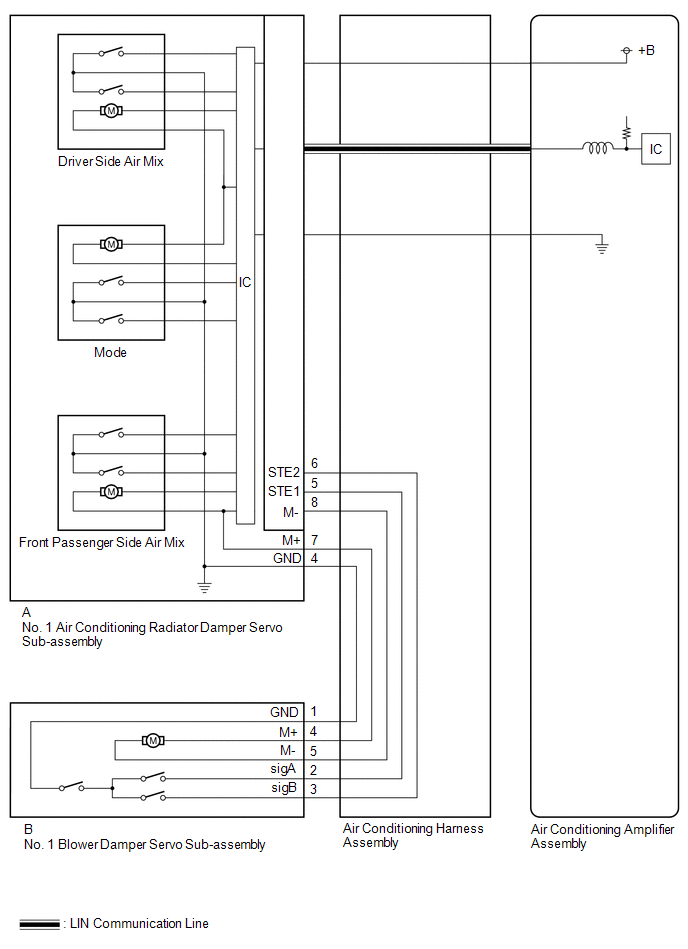
CAUTION / NOTICE / HINT
HINT:
- Confirm that no mechanical problems are present because this DTC can be
stored when either a damper link or damper is mechanically locked.
- When installing a damper servo motor, make sure to install it correctly.
Click here 
- After replacing a damper servo motor, make sure to perform Servo Motor Initialization.
Click here 
PROCEDURE
(a) Check for DTCs.
Body Electrical > Air Conditioner > Trouble Codes
|
Result | Proceed to |
|
Only B1497 is output |
A |
| B1441, B1442, B1443 and B1446 are output |
B |
| Only B1442 is output |
C |
| A |
 | GO TO DTC B1497 |
| B |
 | REPLACE NO. 1 AIR CONDITIONING RADIATOR DAMPER SERVO SUB-ASSEMBLY |
|
C |
 | |
| 2. |
INSPECT NO. 1 BLOWER DAMPER SERVO SUB-ASSEMBLY (INSTALLATION CONDITION) |
(a) Check that the No. 1 blower damper servo sub-assembly is installed correctly.
OK:
The No. 1 blower damper servo sub-assembly is installed correctly.
| NG |
 | INSTALL NO. 1 BLOWER DAMPER SERVO SUB-ASSEMBLY |
|
OK |
 | |
| 3. |
INSPECT NO. 1 BLOWER DAMPER SERVO SUB-ASSEMBLY (MOTOR, LINK, DAMPER) |
(a) Check for a wire harness caught between the links of the motors and dampers.
OK:
No wire harnesses are caught between the links of the motors and dampers.
| NG |
 | REMOVE PINCHED WIRE HARNESS |
|
OK |
 | |
| 4. |
INSPECT NO. 1 BLOWER DAMPER SERVO SUB-ASSEMBLY (DAMPER) |
(a) Remove the No. 1 blower damper servo sub-assembly.
Click here

(b) Operate the air inlet dampers by hand.
OK:
The air inlet dampers are easily operated by hand.
| NG |
 | REPLACE BLOWER ASSEMBLY |
|
OK |
 | |
| 5. |
INSPECT AIR CONDITIONING HARNESS ASSEMBLY |
(a) Disconnect the No. 1 air conditioning radiator damper servo sub-assembly connector.
(b) Measure the resistance according to the value(s) in the table below.
Standard Resistance:
|
Tester Connection | Condition |
Specified Condition |
|
A-6 (STE2) - B-3 (sigB) |
Always | Below 1 ╬® |
|
A-5 (STE1) - B-2 (sigA) |
Always | Below 1 ╬® |
|
A-8 (M-) - B-5 (M-) | Always |
Below 1 ╬® |
|
A-7 (M+) - B-4 (M+) | Always |
Below 1 ╬® |
|
A-4 (GND) - B-1 (GND) |
Always | Below 1 ╬® |
|
A-6 (STE2) or B-3 (sigB) - Other terminals and Body ground |
Always | 10 k╬® or higher |
|
A-5 (STE1) or B-2 (sigA) - Other terminals and Body ground |
Always | 10 k╬® or higher |
|
A-8 (M-) or B-5 (M-) - Other terminals and Body ground |
Always | 10 k╬® or higher |
|
A-7 (M+) or B-4 (M+) - Other terminals and Body ground |
Always | 10 k╬® or higher |
| NG |
 | REPLACE AIR CONDITIONING HARNESS ASSEMBLY |
|
OK |
 | |
| 6. |
PERFORM ACTIVE TEST USING TECHSTREAM |
(a) Connect the No. 1 air conditioning radiator damper servo sub-assembly connector.
(b) Remove the No. 2 air conditioning radiator damper servo sub-assembly.
Click here 
(c)
Connect the No. 1 blower damper servo sub-assembly connector to the No.
2 air conditioning radiator damper servo sub-assembly.
(d) Connect the Techstream to the DLC3.
(e) Turn the engine switch on (IG).
(f) Turn the Techstream on.
(g) Enter the following menus: Body Electrical / Air Conditioner / Active Test.
(h) Perform the Active Test according to the display on the Techstream.
Body Electrical > Air Conditioner > Active Test
|
Tester Display | Measurement Item |
Control Range | Diagnostic Note |
|
Air Inlet Damper Targ Pulse |
No. 1 blower damper servo sub-assembly pulse* |
Min.: 128 Max.: 383 |
Operates between 220 and 256 pulses |
- *: Though this Active Test is for the No. 1 blower damper servo
sub-assembly, in this case it is used to check the operation of the No. 2
air conditioning radiator damper servo sub-assembly.
Body Electrical > Air Conditioner > Active Test
|
Tester Display |
| Air Inlet Damper Targ Pulse |
OK:
The No. 2 air conditioning radiator damper servo sub-assembly operates.
| OK |
 | REPLACE NO. 1 BLOWER DAMPER SERVO SUB-ASSEMBLY |
| NG |
 | REPLACE NO. 1 AIR CONDITIONING RADIATOR DAMPER SERVO SUB-ASSEMBLY |
Air Outlet Damper Control Servo Motor Circuit (Rear) (B1449)
DESCRIPTION
The No. 2 air
conditioning radiator damper servo sub-assembly sends pulse signals to
inform the air conditioning amplifier assembly of the damper position.
The air conditioning amplifier assembly activates the motor (normal or
reverse) based on these signals to move the air outlet damper to the
appropriate position, which controls the rear air outlet switching. The
air conditioning amplifier assembly communicates with the servo through a
communication/driver IC and wiring assembly called the air conditioning
harness assembly.
|
DTC No. | Detection Item |
DTC Detection Condition | Trouble Area |
Memory |
| B1449 |
Air Outlet Damper Control Servo Motor Circuit (Rear) |
Air
outlet damper position sensor value does not change even if air
conditioning amplifier assembly operates No. 2 air conditioning radiator
damper servo sub-assembly |
- No. 2 air conditioning radiator damper servo sub-assembly
- Air conditioning harness assembly
- Air conditioning amplifier assembly
- Air conditioning radiator assembly
| Memorized (30 sec. or more)* |
- *: The air conditioning amplifier assembly stores this DTC if the
malfunction has occurred for the period of time indicated in the
brackets.
DTC Detection Condition Combination Table | |
Vehicle Condition |
|
Pattern 1 | Pattern 2 |
|
Diagnosis Condition | No. 2 air conditioning radiator damper servo sub-assembly operating |
ŌŚŗ | ŌŚŗ |
|
Malfunction | Air
outlet damper servo operation request signals are output but the rear
passenger side air outlet damper position sensor value does not change |
ŌŚŗ | - |
|
Air
outlet damper servo operation request signals are output but the rear
passenger side air outlet damper position sensor value is abnormal |
- | ŌŚŗ |
|
Detection Time | Continuously for 30 seconds or more |
Continuously for 30 seconds or more |
|
Trip Count | 1 trip |
1 trip |
HINT:
If the conditions of either of these patterns are detected, a DTC will be stored.
WIRING DIAGRAM
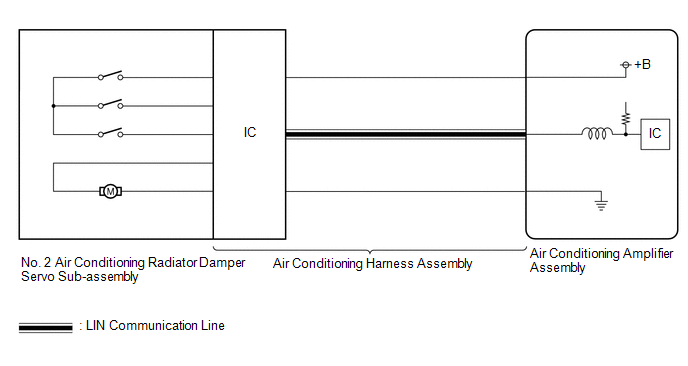
CAUTION / NOTICE / HINT
HINT:
- Confirm that no mechanical problems are present because this DTC can be
stored when either a damper link or damper is mechanically locked.
- When installing a damper servo motor, make sure to install it correctly.
Click here 
- After replacing a damper servo motor, make sure to perform Servo Motor Initialization.
Click here 
PROCEDURE
(a) Check for DTCs.
Body Electrical > Air Conditioner > Trouble Codes
|
Result | Proceed to |
|
DTC B1497 is not output |
A |
| DTC B1497 is output |
B |
| B |
 | GO TO DTC B1497 |
|
A |
 | |
| 2. |
INSPECT NO. 2 AIR CONDITIONING RADIATOR DAMPER SERVO SUB-ASSEMBLY (INSTALLATION CONDITION) |
(a) Check that the No. 2 air conditioning radiator damper servo sub-assembly is installed correctly.
Click here 
OK:
The No. 2 air conditioning radiator damper servo sub-assembly is installed correctly.
| NG |
 | INSTALL NO. 2 AIR CONDITIONING RADIATOR DAMPER SERVO SUB-ASSEMBLY CORRECTLY |
|
OK |
 | |
| 3. |
INSPECT NO. 2 AIR CONDITIONING RADIATOR DAMPER SERVO SUB-ASSEMBLY (MOTOR, LINK, DAMPER) |
(a) Check for a wire harness caught between the links of the motors and dampers.
OK:
No wire harnesses are caught between the links of the motors and dampers.
| NG |
 | REMOVE PINCHED WIRE HARNESS |
|
OK |
 | |
| 4. |
INSPECT AIR CONDITIONING RADIATOR ASSEMBLY (DAMPER) |
(a) Remove the No. 2 air conditioning radiator damper servo sub-assembly.
Click here 
(b) Operate the dampers by hand.
OK:
The dampers are easily operated by hand.
| NG |
 | REPLACE AIR CONDITIONING RADIATOR ASSEMBLY |
|
OK |
 | |
| 5. |
PERFORM ACTIVE TEST USING TECHSTREAM |
(a) Remove the No. 1 air conditioning radiator damper servo sub-assembly.
Click here 
(b)
Connect the No. 1 air conditioning radiator damper servo sub-assembly
connector to the No. 2 air conditioning radiator damper servo
sub-assembly.
(c) Connect the Techstream to the DLC3.
(d) Turn the engine switch on (IG).
(e) Turn the Techstream on.
(f) Enter the following menus: Body Electrical / Air Conditioner / Active Test.
(g) Perform the Active Test according to the display on the Techstream.
Body Electrical > Air Conditioner > Active Test
|
Tester Display | Measurement Item |
Control Range | Diagnostic Note |
|
Air Outlet Servo Pulse (D) |
No. 1 air conditioning radiator damper servo sub-assembly (mode) pulse* |
Min.: 128 Max.: 383 |
Operates between 241 and 348 pulses |
- *: Though this Active Test is for the No. 1 air conditioning radiator
damper servo sub-assembly, in this case it is used to check the
operation of the No. 2 air conditioning radiator damper servo
sub-assembly.
Body Electrical > Air Conditioner > Active Test
|
Tester Display |
| Air Outlet Servo Pulse (D) |
OK:
The No. 2 air conditioning radiator damper servo sub-assembly operates.
| OK |
 | REPLACE AIR CONDITIONING HARNESS ASSEMBLY |
| NG |
 | REPLACE NO. 2 AIR CONDITIONING RADIATOR DAMPER SERVO SUB-ASSEMBLY |
Compressor Solenoid Circuit (B1451)
DESCRIPTION
The cooler compressor assembly receives refrigerant compression demand signals from the air conditioning amplifier assembly.
Based on this signal, the cooler compressor assembly changes the amount of compressor output.
|
DTC No. | Detection Item |
DTC Detection Condition | Trouble Area |
Memory |
| B1451 |
Compressor Solenoid Circuit |
Open or short in compressor solenoid circuit |
- Cooler compressor assembly
- Harness or connector
- Air conditioning amplifier assembly
| - |
WIRING DIAGRAM
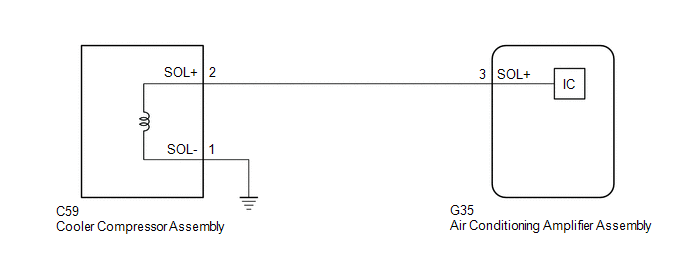
PROCEDURE
| 1. |
INSPECT AIR CONDITIONING AMPLIFIER ASSEMBLY |
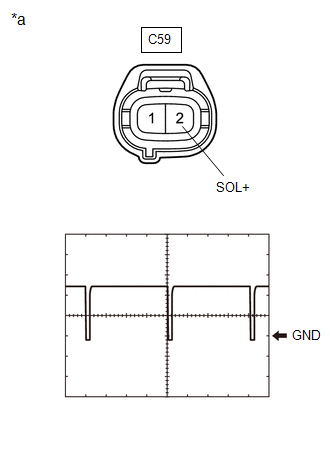
|
*a | Front view of wire harness connector
(to Cooler Compressor Assembly) |
(a) Disconnect the C59 cooler compressor assembly connector.
(b) Connect an oscilloscope to terminal C59-2 (SOL+) and body ground and check the waveform.
|
Item | Content |
|
Tool Setting | 5 V/DIV., 500 ╬╝s./DIV. |
|
Condition |
- Engine running
- Blower switch: LO
- A/C switch: On
|
OK:
Waveform is similar to that shown in the illustration.
| OK |
 | REPLACE COOLER COMPRESSOR ASSEMBLY |
|
NG |
 | |
| 2. |
CHECK HARNESS AND CONNECTOR (COOLER COMPRESSOR ASSEMBLY - AIR CONDITIONING AMPLIFIER ASSEMBLY) |
(a) Disconnect the G35 air conditioning amplifier assembly connector.
(b) Measure the resistance according to the value(s) in the table below.
Standard Resistance:
|
Tester Connection | Condition |
Specified Condition |
|
C59-2 (SOL+) - G35-3 (SOL+) |
Always | Below 1 ╬® |
|
C59-2 (SOL+) or G35-3 (SOL+) - Other terminals and body ground |
Always | 10 k╬® or higher |
| OK |
 | REPLACE AIR CONDITIONING AMPLIFIER ASSEMBLY |
| NG |
 | REPAIR OR REPLACE HARNESS OR CONNECTOR |
Communication Malfunction (Bus Ic) (B1497)
DESCRIPTION
The air
conditioning harness assembly connects the air conditioning amplifier
assembly and the servo motors. The air conditioning amplifier assembly
supplies power and sends operation instructions to each servo motor
through the air conditioning harness assembly. Each servo motor sends
damper position information to the air conditioning amplifier assembly.
|
DTC No. | Detection Item |
DTC Detection Condition | Trouble Area |
Memory |
| B1497 |
Communication Malfunction (Bus Ic) |
Error or open in communication line |
- Air conditioning harness assembly
- No. 1 air conditioning radiator damper servo sub-assembly
- No. 2 air conditioning radiator damper servo sub-assembly
- Air conditioning amplifier assembly
| Memorized (10 sec. or more)* |
- *: The air conditioning amplifier assembly stores this DTC if the
malfunction has occurred for the period of time indicated in the
brackets.
WIRING DIAGRAM
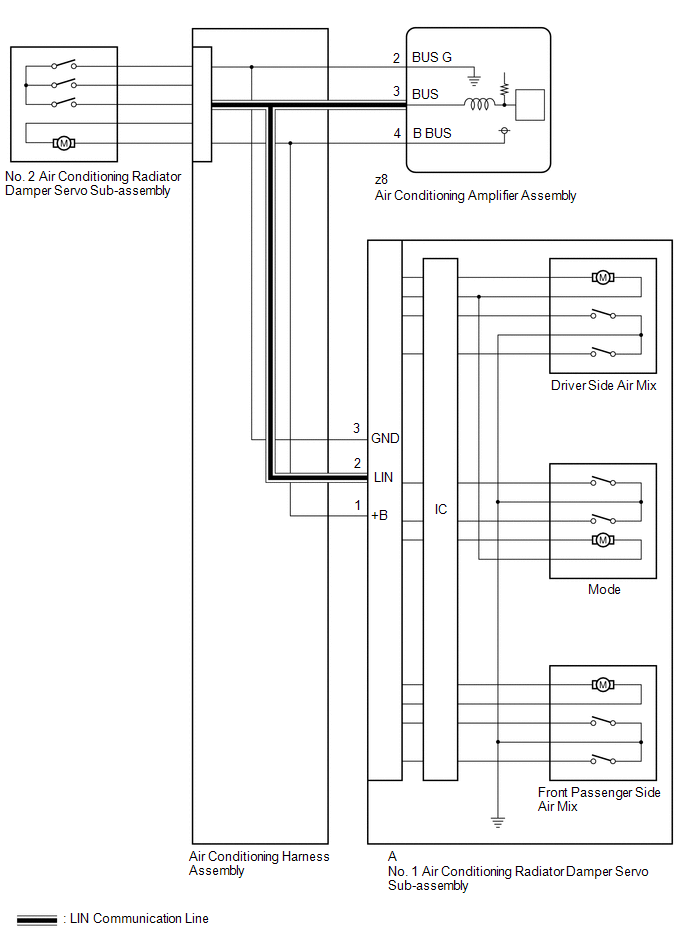
PROCEDURE
| 1. |
PERFORM ACTIVE TEST USING TECHSTREAM |
(a) Connect the Techstream to the DLC3.
(b) Turn the engine switch on (IG).
(c) Turn the Techstream on.
(d) Enter the following menus: Body Electrical / Air Conditioner / Active test.
(e) Perform the Active Test according to the display on the Techstream.
Body Electrical > Air Conditioner > Active Test
|
Tester Display | Measurement Item |
Control Range | Diagnostic Note |
|
Air Mix Servo Targ Pulse(D) |
No. 1 air conditioning radiator damper servo sub-assembly (driver side air mix) pulse |
Min.: 128 Max.: 383 |
Operates between 165 and 257 pulses |
|
A/O Servo Pulse(Rr D) | No. 2 air conditioning radiator damper servo sub-assembly pulse |
Min.: 128 Max.: 383 |
Operates between 158 and 260 pulses |
Body Electrical > Air Conditioner > Active Test
|
Tester Display |
| Air Mix Servo Targ Pulse(D) |
Body Electrical > Air Conditioner > Active Test
|
Tester Display |
| A/O Servo Pulse(Rr D) |
|
Result | Proceed to |
|
All of the damper servo motors are malfunctioning |
A |
| One of the damper servo motors is malfunctioning |
B |
| B |
 | GO TO STEP 4 |
|
A |
 | |
| 2. |
PERFORM ACTIVE TEST USING TECHSTREAM |
(a) Disconnect the No. 1 air conditioning radiator damper servo sub-assembly connector.
(b) Connect the Techstream to the DLC3.
(c) Turn the engine switch on (IG).
(d) Turn the Techstream on.
(e) Enter the following menus: Body Electrical / Air Conditioner / Active test.
(f) Perform the Active Test according to the display on the Techstream.
Body Electrical > Air Conditioner > Active Test
|
Tester Display | Measurement Item |
Control Range | Diagnostic Note |
|
A/O Servo Pulse(Rr D) | No. 2 air conditioning radiator damper servo sub-assembly pulse |
Min.: 128 Max.: 383 |
Operates between 158 and 260 pulses |
Body Electrical > Air Conditioner > Active Test
|
Tester Display |
| A/O Servo Pulse(Rr D) |
OK:
The damper servo motor operates smoothly.
| OK |
 | REPLACE NO. 1 AIR CONDITIONING RADIATOR DAMPER SERVO SUB-ASSEMBLY |
|
NG |
 | |
| 3. |
INSPECT AIR CONDITIONING AMPLIFIER ASSEMBLY |
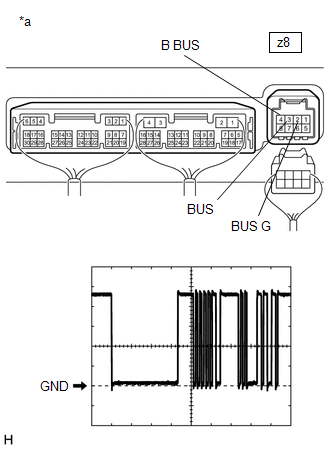
|
*a | Component with harness connected (Air Conditioning Amplifier Assembly) |
NOTICE:
When
inspecting the air conditioning amplifier assembly, do not bring the
tester probes too close to each other as a short circuit may occur.
(a) Disconnect the z8 air conditioning amplifier assembly connector.
(b) Measure the voltage and resistance according to the value(s) in the table below.
Standard Voltage:
|
Tester Connection | Condition |
Specified Condition |
|
z8-4 (B BUS) - Body ground |
Engine switch on (IG) |
11 to 14 V |
Standard Resistance:
|
Tester Connection | Condition |
Specified Condition |
|
z8-2 (BUS G) - Body ground |
Always | Below 1 ╬® |
(c) Turn the engine switch on (IG).
(d) Using an oscilloscope, check the waveform.
|
Item | Content |
|
Terminal No. | z8-3 (BUS) - z8-2 (BUS G) |
|
Tool Setting | 2 V/DIV., 2 ms./DIV. |
|
Condition | Engine switch on (IG) |
OK:
Waveform is similar to that shown in the illustration.
HINT:
The waveform varies with the blower speed.
| OK |
 | REPLACE AIR CONDITIONING HARNESS ASSEMBLY |
| NG |
 | REPLACE AIR CONDITIONING AMPLIFIER ASSEMBLY |
| 4. |
PERFORM ACTIVE TEST USING TECHSTREAM |
(a) Connect the Techstream to the DLC3.
(b) Turn the engine switch on (IG).
(c) Turn the Techstream on.
(d) Enter the following menus: Body Electrical / Air Conditioner / Active test.
(e) Perform the Active Test according to the display on the Techstream.
Body Electrical > Air Conditioner > Active Test
|
Tester Display | Measurement Item |
Control Range | Diagnostic Note |
|
Air Mix Servo Targ Pulse(D) |
No. 1 air conditioning radiator damper servo sub-assembly (driver side air mix) pulse |
Min.: 128 Max.: 383 |
Operates between 165 and 257 pulses |
|
A/O Servo Pulse(Rr D) | No. 2 air conditioning radiator damper servo sub-assembly pulse |
Min.: 128 Max.: 383 |
Operates between 158 and 260 pulses |
Body Electrical > Air Conditioner > Active Test
|
Tester Display |
| Air Mix Servo Targ Pulse(D) |
Body Electrical > Air Conditioner > Active Test
|
Tester Display |
| A/O Servo Pulse(Rr D) |
|
Result | Proceed to |
|
Only the No. 1 air conditioning radiator damper servo sub-assembly does not operate |
A |
| Only the No. 2 air conditioning radiator damper servo sub-assembly does not operate |
B |
| B |
 | REPLACE AIR CONDITIONING HARNESS ASSEMBLY |
|
A |
 | |
| 5. |
INSPECT
AIR CONDITIONING HARNESS ASSEMBLY (AIR CONDITIONING AMPLIFIER ASSEMBLY -
NO. 1 AIR CONDITIONING RADIATOR DAMPER SERVO SUB-ASSEMBLY) |
(a) Disconnect the z8 air conditioning amplifier assembly connector.
(b) Disconnect the No. 1 air conditioning radiator damper servo sub-assembly connector.
(c) Measure the resistance according to the value(s) in the table below.
Standard Resistance:
|
Tester Connection | Condition |
Specified Condition |
|
z8-2 (BUS G) - A-3 (GND) |
Always | Below 1 ╬® |
|
z8-3 (BUS) - A-2 (LIN) |
Always | Below 1 ╬® |
|
z8-4 (B BUS) - A-1 (+B) |
Always | Below 1 ╬® |
| OK |
 | REPLACE NO. 1 AIR CONDITIONING RADIATOR DAMPER SERVO SUB-ASSEMBLY |
| NG |
 | REPLACE AIR CONDITIONING HARNESS ASSEMBLY |
Blower Motor Circuit
DESCRIPTION
The blower
motor with fan sub-assembly is operated by signals from the air
conditioning amplifier assembly. Blower motor speed signals are
transmitted in accordance with changes in the duty ratio.
If the airflow volume is low or the blower speed cannot be changed, the following factors may be the cause.
|
Symptom | Factor |
|
Airflow volume cannot be changed |
- Air conditioning amplifier assembly malfunction
- Blower motor with fan sub-assembly malfunction
- Harness or connector
|
WIRING DIAGRAM
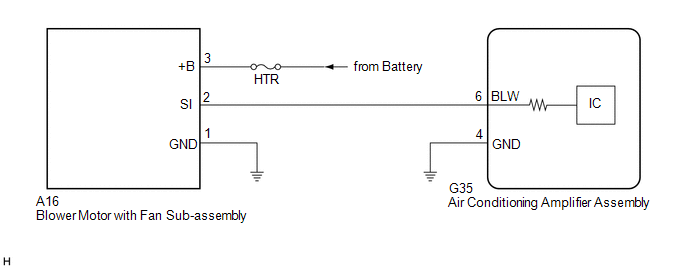
CAUTION / NOTICE / HINT
NOTICE:
Inspect the fuses for circuits related to this system before performing the following procedure.
PROCEDURE
| 1. |
PERFORM ACTIVE TEST USING TECHSTREAM |
(a) Connect the Techstream to the DLC3.
(b) Turn the engine switch on (IG).
(c) Turn the Techstream on.
(d) Enter the following menus: Body Electrical / Air Conditioner / Active Test.
(e) Perform the Active Test according to the display on the Techstream.
Body Electrical > Air Conditioner > Active Test
|
Tester Display | Measurement Item |
Control Range | Diagnostic Note |
|
Blower Motor | Blower motor with fan sub-assembly |
Min.: 0 Max.: 31 |
- |
Body Electrical > Air Conditioner > Active Test
|
Tester Display |
| Blower Motor |
| Result |
Proceed to |
| Blower motor with fan sub-assembly does not operate |
A |
| Blower motor with fan sub-assembly operates but does not change speed |
B |
| B |
 | GO TO STEP 5 |
|
A |
 | |
| 2. |
CHECK HARNESS AND CONNECTOR (BLOWER MOTOR WITH FAN SUB-ASSEMBLY - POWER SOURCE AND BODY GROUND) |
(a) Disconnect the A16 blower motor with fan sub-assembly connector.
(b) Measure the voltage and resistance according to the value(s) in the table below.
Standard Voltage:
|
Tester Connection | Condition |
Specified Condition |
|
A16-3 (+B) - Body ground |
Always | 11 to 14 V |
Standard Resistance:
|
Tester Connection | Condition |
Specified Condition |
|
A16-1 (GND) - Body ground |
Always | Below 1 ╬® |
| NG |
 | REPAIR OR REPLACE HARNESS OR CONNECTOR |
|
OK |
 | |
| 3. |
CHECK HARNESS AND CONNECTOR (BLOWER MOTOR WITH FAN SUB-ASSEMBLY - AIR CONDITIONING AMPLIFIER ASSEMBLY) |
(a) Disconnect the G35 air conditioning amplifier assembly connector.
(b) Measure the resistance according to the value(s) in the table below.
Standard Resistance:
|
Tester Connection | Condition |
Specified Condition |
|
A16-2 (SI) - G35-6 (BLW) |
Always | Below 1 ╬® |
|
A16-2 (SI) or G35-6 (BLW) - Other terminals and body ground |
Always | 10 k╬® or higher |
| NG |
 | REPAIR OR REPLACE HARNESS OR CONNECTOR |
|
OK |
 | |
| 4. |
INSPECT BLOWER MOTOR WITH FAN SUB-ASSEMBLY |
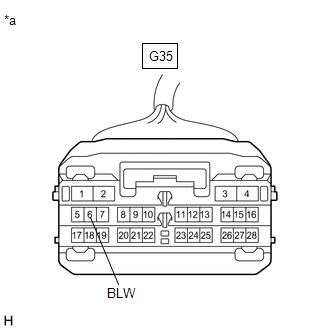
|
*a | Front view of wire harness connector
(to Air Conditioning Amplifier Assembly) |
(a) Connect the A16 blower motor with fan sub-assembly connector.
(b) Measure the voltage according to the value(s) in the table below.
Standard Voltage:
|
Tester Connection | Condition |
Specified Condition |
|
G35-6 (BLW) - Body ground |
Always | 4.75 to 5.25 V |
| NG |
 | REPLACE BLOWER MOTOR WITH FAN SUB-ASSEMBLY |
|
OK |
 | |
| 5. |
INSPECT AIR CONDITIONING AMPLIFIER ASSEMBLY |
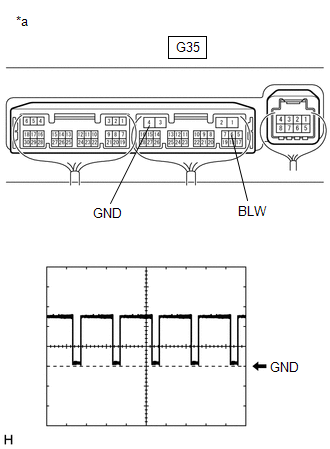
|
*a | Component with harness connected (Air Conditioning Amplifier Assembly) |
(a) Connect the G35 air conditioning amplifier assembly connector.
(b) Turn the engine switch on (IG).
(c) Set the blower speed to LO.
(d) Using an oscilloscope, check the waveform.
|
Item | Content |
|
Terminal No. | G35-6 (BLW) - G35-4 (GND) |
|
Tool Setting | 2 V/DIV., 1 ms./DIV. |
|
Condition |
- Engine switch on (IG)
- Blower speed: LO
|
OK:
Waveform is similar to that shown in the illustration.
HINT:
The waveform varies with the blower speed.
| OK |
 | REPLACE BLOWER MOTOR WITH FAN SUB-ASSEMBLY |
| NG |
 | REPLACE AIR CONDITIONING AMPLIFIER ASSEMBLY |
Blower Motor does not Operate
DESCRIPTION
If air does not
flow from the front registers after the blower switch on the air
conditioning control panel (radio and display receiver assembly) is
operated, the following factors may be the cause.
|
Symptom | Factor |
|
No air flows from the registers |
- Air conditioning amplifier assembly malfunction
- Blower motor with fan sub-assembly malfunction
- Warm-up control
- Engine coolant temperature sensor malfunction
- Harness or connector
|
PROCEDURE
| 1. |
CHECK AIR CONDITIONING SYSTEM (MANUAL MODE) |
(a)
Turn off the AUTO switch, operate the blower switch and check that the
blower motor with fan sub-assembly can be operated manually.
OK:
The blower motor with fan sub-assembly operates normally.
| NG |
 | GO TO OTHER DIAGNOSIS PROCEDURE (Blower Motor Circuit) |
|
OK |
 | |
| 2. |
READ VALUE USING TECHSTREAM |
(a) Connect the Techstream to the DLC3.
(b) Turn the engine switch on (IG).
(c) Turn the Techstream on.
(d) Enter the following menus: Powertrain / Engine / Data List.
(e) Read the Data List according to the display on the Techstream.
Powertrain > Engine > Data List
|
Tester Display | Measurement Item |
Range | Normal Condition |
Diagnostic Note |
|
Coolant Temperature | Engine coolant temperature |
Min.: -40┬░C (-40┬░F), Max.: 140┬░C (284┬░F) |
75 to 100┬░C (167 to 212┬░F): After warming up |
This is the engine coolant temperature.
HINT:
- After warming up the engine, the engine coolant temperature will be 75 to 100┬░C (167 to 212┬░F).
- After a long soak, the engine coolant temperature, intake air
temperature and ambient air temperature will be approximately equal.
- If the value is -40┬░C (-40┬░F), or higher than 135┬░C (275┬░F), the sensor circuit is open or shorted.
- Check if the engine overheats if the value indicated is higher than 135┬░C (275┬░F).
|
Powertrain > Engine > Data List
|
Tester Display |
| Coolant Temperature |
OK:
After warming up the engine, the temperature value displayed is within the range specified in the normal condition column.
| OK |
 | REPLACE AIR CONDITIONING AMPLIFIER ASSEMBLY |
| NG |
 | GO TO COOLING SYSTEM |
Cooling is Poor
DESCRIPTION
If the cooling effect of the air conditioning system is weak, the following factors may be the cause.
|
Symptom | Factor |
- Cooling effectiveness is poor
- Cooling response is slow
|
- ECO mode control of air conditioning system is enabled
- Cooler compressor assembly malfunction
- Refrigerant volume (high)
- Refrigerant volume (low)
- Clogged cooler condenser assembly fins
- Cooling fan system malfunction
- Mechanical locking of damper and damper link
- Automatic light control sensor malfunction
- High inlet air temperature
- Harness or connector
|
WIRING DIAGRAM
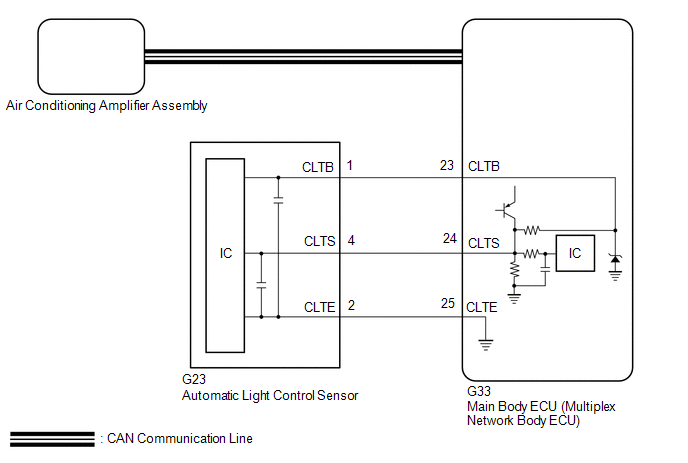
PROCEDURE
| 1. |
CHECK ECO MODE SETTING |
(a) Check if the ECO mode indicator is off.
OK:
The ECO mode indicator is off.
| OK |
 | GO TO STEP 3 |
|
NG |
 | |
| 2. |
CHECK ECO MODE CONTROL OPERATION |
(a)
Operate the ECO switch assembly (electric parking brake switch
assembly) and check that the ECO mode indicator turns off and the blower
speed reduction is canceled.
HINT:
- When ECO mode control is operating, the air conditioning amplifier
assembly controls the air conditioning system to enhance fuel
efficiency. Therefore, explain to the customer that, when ECO mode
control is operating, the blower speed will be reduced.
|
Control |
Outline |
|
Blower Control |
When
the air conditioning system is in AUTO mode, the blower speed will be
reduced to a certain speed. Additionally, if warm-up control is
operating, the blower speed will be further reduced. |
|
Air Inlet Control |
If the ambient temperature is a certain value or more, the air inlet mode will be changed to recirculation mode.
|
- In some situations, ECO mode control may not operate even though it is enabled.
|
Result | Proceed to |
|
ECO mode indicator turns off and blower speed reduction is canceled |
A |
| ECO mode indicator turns off, but the blower speed reduction is not canceled |
B |
| ECO mode indicator does not turn off |
| B |
 | GO TO ECO Switch Circuit |
|
A |
 | |
| 3. |
PERFORM REFRIGERANT SHORTAGE CHECK |
(a) Connect the Techstream to the DLC3.
(b) Turn the engine switch on (IG).
(c) Turn the Techstream on.
(d) Enter the following menus: Body Electrical / Air Conditioner / Utility / Refrigerant Gas Volume Check.
Body Electrical > Air Conditioner > Utility
|
Tester Display |
| Refrigerant Gas Volume Check |
(e)
Check that the following conditions are met and perform the refrigerant
shortage check according to the display on the Techstream.
Measurement Condition: |
Item | Condition |
|
A/C switch | On |
|
Ambient temperature* |
0 to 49┬░C (32 to 120┬░F) |
|
Blower speed | HI |
*: If the ambient temperature is not within the range shown, do not perform this check.
|
Result | Amount of Refrigerant |
|
Refrigerant correct | Correct |
|
Refrigerant shortage |
Insufficient |
OK:
"Refrigerant correct" is displayed on the Techstream.
| NG |
 | REPAIR REFRIGERANT LEAK |
|
OK |
 | |
| 4. |
PERFORM ACTIVE TEST USING TECHSTREAM |
(a) Connect the Techstream to the DLC3.
(b) Turn the engine switch on (IG).
(c) Turn the Techstream on.
(d) Enter the following menus: Body Electrical / Air Conditioner / Active Test.
(e) Perform the Active Test according to the display on the Techstream.
Body Electrical > Air Conditioner > Active Test
|
Tester Display | Measurement Item |
Control Range | Diagnostic Note |
|
Air Mix Servo Targ Pulse(D) |
No. 1 air conditioning radiator damper servo sub-assembly (driver side air mix) pulse |
Min.: 128 Max.: 383 |
Operates between 165 and 257 pulses |
|
Air Mix Servo Targ Pulse(P) |
No. 1 air conditioning radiator damper servo sub-assembly (front passenger side air mix) pulse |
Min.: 128 Max.: 383 |
Operates between 255 and 347 pulses |
Body Electrical > Air Conditioner > Active Test
|
Tester Display |
| Air Mix Servo Targ Pulse(D) |
Body Electrical > Air Conditioner > Active Test
|
Tester Display |
| Air Mix Servo Targ Pulse(P) |
OK:
Each damper servo motor operates.
| NG |
 | GO TO DTC TROUBLESHOOTING PROCEDURE FOR MALFUNCTIONING DAMPER SERVO MOTOR |
|
OK |
 | |
| 5. |
CHECK HARNESS AND CONNECTOR (AUTOMATIC LIGHT CONTROL SENSOR - MAIN BODY ECU (MULTIPLEX NETWORK BODY ECU)) |
(a) Disconnect the G23 automatic light control sensor connector.
(b) Disconnect the G33 main body ECU (multiplex network body ECU) connector.
(c) Measure the resistance according to the value(s) in the table below.
Standard Resistance:
|
Tester Connection | Condition |
Specified Condition |
|
G23-1 (CLTB) - G33-23 (CLTB) |
Always | Below 1 ╬® |
|
G23-2 (CLTE) - G33-25 (CLTE) |
Always | Below 1 ╬® |
|
G23-4 (CLTS) - G33-24 (CLTS) |
Always | Below 1 ╬® |
|
G23-1 (CLTB) or G33-23 (CLTB) - Other terminals and body ground |
Always | 10 k╬® or higher |
|
G23-2 (CLTE) or G33-25 (CLTE) - Other terminals and body ground |
Always | 10 k╬® or higher |
|
G23-4 (CLTS) or G33-24 (CLTS) - Other terminals and body ground |
Always | 10 k╬® or higher |
| NG |
 | REPAIR OR REPLACE HARNESS OR CONNECTOR |
|
OK |
 | |
| 6. |
INSPECT AUTOMATIC LIGHT CONTROL SENSOR |
(a) Remove the automatic light control sensor.
Click here

(b) Inspect the automatic light control sensor.
Click here 
| OK |
 | INSPECT REFRIGERANT PRESSURE WITH MANIFOLD GAUGE SET |
| NG |
 | REPLACE AUTOMATIC LIGHT CONTROL SENSOR |
Customize Parameters
CUSTOMIZE PARAMETERS
CUSTOMIZE AIR CONDITIONING SYSTEM
(a) Customizing with the Techstream.
NOTICE:
- When the customer requests a change in a function, first make sure that the function can be customized.
- Be sure to make a note of the current settings before customizing.
- When troubleshooting a function, first make sure that the function is set to the default setting.
HINT:
The following items can be customized.
(1) Connect the Techstream.
(2) Turn the engine switch on (IG).
(3) Turn the Techstream on.
(4) Enter the following menus: Customize Setting / Air Conditioner.
(5) Select the setting by referring to the table below.
Air Conditioner
|
Tester Display | Description |
Default | Setting |
ECU |
| Set Temperature Shift |
Function to perform control with the shifted temperature versus the displayed temperature |
Normal | 00001:-2C,00010:-1C,00100:Normal,01000:+1C,10000:+2C |
Air conditioning amplifier assembly |
|
Evaporator Control | Function
to set the evaporator control to the automatic position (Automatic) to
save power or to the coldest position (Manual) to dehumidify the air and
to prevent the windows from fogging up |
Automatic | 0:Automatic,1:Manual |
Air conditioning amplifier assembly |
|
Compressor Mode | Function to turn the A/C on automatically by pressing the AUTO switch when the blower is on and the A/C is off |
Automatic | 0:Automatic,1:Manual |
Air conditioning amplifier assembly |
|
Air Inlet Mode | Function to change the mode automatically to recirculation air mode when turning the A/C on to cool the cabin quickly*1 |
Automatic | 0:Automatic,1:Manual |
Air conditioning amplifier assembly |
|
Foot/DEF Auto Mode | Function to change the air outlet mode to foot/defroster automatically when AUTO mode is on |
ON | 0:ON,1:OFF |
Air conditioning amplifier assembly |
|
Foot/DEF Automatic Blow Up Function |
Function to increase the blower level automatically when the defroster is on |
ON | 0:ON,1:OFF |
Air conditioning amplifier assembly |
|
Ambient Temperature Shift |
Function to display the shifted ambient temperature versus the actual ambient temperature |
Normal | 0000001:-3C,0000010:-2C,0000100:-1C,0001000:Normal,0010000:+1C,0100000:+2C,1000000:+3C |
Air conditioning amplifier assembly |
|
ECO MODE Cancel | Function to disable the operation of the ECO switch assembly when set to OFF*2 |
OFF | 0:OFF,1:ON |
Air conditioning amplifier assembly |
|
Refrigerant Shortage Check |
Function to cancel the refrigerant shortage check (check performed during normal operation) when set to ON |
ON | 0:ON,1:OFF |
Air conditioning amplifier assembly |
|
Fan speed increment control |
Function to set the speed to reach the target blower fan speed when AUTO mode is on |
Normal | 001:Slow,010:Normal,100:Fast |
Air conditioning amplifier assembly |
|
Outside Air Mode Auto Switch Function |
Function to automatically change the air inlet to FRESH mode when the engine switch is off for 60 seconds |
ON | 0:ON,1:OFF |
Air conditioning amplifier assembly |
- *1: except USA and Canada
- *2: Make sure to disable ECO mode control before setting this customize setting to ON.
(b) Customizing with the multi-display.
(1) Turn the engine switch on (IG).
(2) Enter the following menus: MENU / Setup / Vehicle / Vehicle Customization / Climate Settings.
(3) Select the setting by referring to the table below.
|
Display | Default |
Content | Setting |
Relevant ECU |
| Auto A/C Mode |
On | Function to turn the A/C on automatically by pressing the AUTO switch when the blower is on and the A/C is off |
On or Off | Air conditioning amplifier assembly |
Data List / Active Test
DATA LIST / ACTIVE TEST
DATA LIST
NOTICE:
In
the table below, the values listed under "Normal Condition" are
reference values. Do not depend solely on these reference values when
deciding whether a part is faulty or not.
HINT:
Using
the Techstream to read the Data List allows the values or states of
switches, sensors, actuators and other items to be read without removing
any parts. This non-intrusive inspection can be very useful because
intermittent conditions or signals may be discovered before parts or
wiring is disturbed. Reading the Data List information early in
troubleshooting is one way to save diagnostic time.
(a) Connect the Techstream to the DLC3.
(b) Turn the engine switch on (IG).
(c) Turn the Techstream on.
(d) Enter the following menus:
(1) for Air Conditioner: Body Electrical / Air Conditioner / Data List.
(2) for Engine: Powertrain / Engine / Data List.
(e) Read the Data List according to the display on the Techstream.
Body Electrical > Air Conditioner > Data List
|
Tester Display | Measurement Item |
Range | Normal Condition |
Diagnostic Note |
|
Room Temperature Sensor |
Cooler (room temp. sensor) thermistor |
Min.: -6.50┬░C (20.30┬░F) Max.: 57.25┬░C (135.05┬░F) |
Actual cabin temperature displayed |
Cooler (room temp. sensor) thermistor circuit malfunction
- When open circuit: -6.50┬░C (20.30┬░F)
- When short circuit: 57.25┬░C (135.05┬░F)
|
| Ambient Temp Sensor |
Thermistor assembly | Min.: -23.30┬░C (-9.94┬░F)
Max.: 65.95┬░C (150.71┬░F) |
Actual ambient temperature displayed |
Thermistor assembly circuit malfunction
- When open circuit: -23.30┬░C (-9.94┬░F)
- When short circuit: 65.95┬░C (150.71┬░F)
|
| Adjusted Ambient Temp |
Adjusted ambient temperature |
Min.: -30.80┬░C (-23.44┬░F) Max.: 50.80┬░C (123.44┬░F) |
Adjust ambient temperature displayed |
Air conditioning amplifier assembly malfunction |
|
Evaporator Fin Thermistor |
No. 1 cooler thermistor |
Min.: -29.70┬░C (-21.46┬░F) Max.: 59.55┬░C (139.19┬░F) |
Actual evaporator temperature displayed |
No. 1 cooler thermistor circuit malfunction
- When open circuit: -29.70┬░C (-21.46┬░F)
- When short circuit: 59.55┬░C (139.19┬░F)
|
| Evaporator Target Temp |
Evaporator target temperature |
Min.: -327.68┬░C (-557.82┬░F) Max.: 327.67┬░C (621.81┬░F) |
Evaporator target temperature displayed |
No. 1 cooler thermistor circuit malfunction
- When open circuit: -327.68┬░C (-557.82┬░F)
- When short circuit: 327.67┬░C (621.81┬░F)
|
| Solar Sensor (D Side) |
Driver side automatic light control sensor |
Min.: 0 Max.: 255 |
Driver side automatic light control sensor value increases as brightness increases |
Driver side automatic light control sensor circuit malfunction
- When open circuit: 0
- When short circuit: 255
|
| Solar Sensor (P Side) |
Front passenger side automatic light control sensor |
Min.: 0 Max.: 255 |
Front passenger side automatic light control sensor value increases as brightness increases |
Front passenger side automatic light control sensor circuit malfunction
- When open circuit: 0
- When short circuit: 255
|
| Engine Coolant Temp |
Engine coolant temperature sensor |
Min.: 1.30┬░C (34.34┬░F) Max.: 90.55┬░C (194.99┬░F) |
Actual engine coolant temperature displayed |
- SFI system malfunction
- CAN communication system malfunction
|
| Blower Motor Speed Level |
Blower motor speed level |
Min.: 0 Max.: 31 |
Displayed speed level increases in range between 0 and 31 as blower motor speed increases |
Blower motor with fan sub-assembly circuit malfunction |
|
Regulator Pressure Sensor |
Air conditioner pressure sensor |
Min.: -66.2 psi (gauge) Max.: 478.0 psi (gauge) |
Actual refrigerant pressure displayed |
- Refrigerant line (gas leak etc.)
- Air conditioner pressure sensor circuit malfunction
|
| Regulator Control Current |
Solenoid valve control current |
Min.: 0 A Max.: 0.997 A |
Value changes between 0 A and 0.997 A in accordance with solenoid valve operation |
Cooler compressor assembly circuit malfunction |
|
Air Outlet Servo Pulse (R) |
No. 2 air conditioning radiator damper servo sub-assembly target pulse |
Min.: 128 Max.: 383 |
- FACE: 260 (pulse)
- B/L: 212 (pulse)
- FOOT: 182 (pulse)
- F/D: 220 (pulse)
- SHUT: 158 (pulse)
- D/F: 177 (pulse)
| No. 2 air conditioning radiator damper servo sub-assembly circuit malfunction |
|
Air Outlet Servo Actual Pls(R) |
No. 2 air conditioning radiator damper servo sub-assembly actual pulse |
Min.: 128 Max.: 383 |
- FACE: 260 (pulse)
- B/L: 212 (pulse)
- FOOT: 182 (pulse)
- F/D: 220 (pulse)
- SHUT: 158 (pulse)
- D/F: 177 (pulse)
| No. 2 air conditioning radiator damper servo sub-assembly circuit malfunction |
|
Air Mix Servo Targ Pulse(D) |
No. 1 air conditioning radiator damper servo sub-assembly (driver side air mix or air mix) target pulse |
Min.: 128 Max.: 383 |
- MAX COLD: 257 (pulse)
- MAX HOT: 165 (pulse)
| No. 1 air conditioning radiator damper servo sub-assembly (driver side air mix) circuit malfunction |
|
Air Mix Servo Actual Pulse(D) |
No. 1 air conditioning radiator damper servo sub-assembly (driver side air mix or air mix) actual pulse |
Min.: 128 Max.: 383 |
- MAX COLD: 257 (pulse)
- MAX HOT: 165 (pulse)
| No. 1 air conditioning radiator damper servo sub-assembly (driver side air mix) circuit malfunction |
|
Air Mix Servo Targ Pulse(P) |
No. 1 air conditioning radiator damper servo sub-assembly (front passenger side air mix) target pulse |
Min.: 128 Max.: 383 |
- MAX COLD: 255 (pulse)
- MAX HOT: 347 (pulse)
| No. 1 air conditioning radiator damper servo sub-assembly (front passenger side air mix) circuit malfunction |
|
Air Mix Servo Actual Pulse(P) |
No. 1 air conditioning radiator damper servo sub-assembly (front passenger side air mix) actual pulse |
Min.: 128 Max.: 383 |
- MAX COLD: 255 (pulse)
- MAX HOT: 347 (pulse)
| No. 1 air conditioning radiator damper servo sub-assembly (front passenger side air mix) circuit malfunction |
|
Air Outlet Servo Pulse (D) |
No. 1 air conditioning radiator damper servo sub-assembly (mode) target pulse |
Min.: 128 Max.: 383 |
- FACE-R: 241 (pulse)
- FACE: 256 (pulse)
- FACE1: 256 (pulse)
- FACE2: 256 (pulse)
- B/L: 267 (pulse)
- B/L2: 267 (pulse)
- FOOT-R: 305 (pulse)
- FOOT: 297 (pulse)
- FOOT-D: 305 (pulse)
- FOOT-0: 288 (pulse)
- F/D: 320 (pulse)
- DEF-FOOT: 339 (pulse)
- DEF or SHUT: 348 (pulse)
| No. 1 air conditioning radiator damper servo sub-assembly (mode) circuit malfunction |
|
Air Outlet Servo Actu Pulse(D) |
No. 1 air conditioning radiator damper servo sub-assembly (mode) actual pulse |
Min.: 128 Max.: 383 |
- FACE-R: 241 (pulse)
- FACE: 256 (pulse)
- FACE1: 256 (pulse)
- FACE2: 256 (pulse)
- B/L: 267 (pulse)
- B/L2: 267 (pulse)
- FOOT-R: 305 (pulse)
- FOOT: 297 (pulse)
- FOOT-D: 305 (pulse)
- FOOT-0: 288 (pulse)
- F/D: 320 (pulse)
- DEF-FOOT: 339 (pulse)
- DEF or SHUT: 348 (pulse)
| No. 1 air conditioning radiator damper servo sub-assembly (mode) circuit malfunction |
|
Air Inlet Damper Targ Pulse |
No. 1 blower damper servo sub-assembly target pulse |
Min.: 128 Max.: 383 |
- Recirculation: 256 (pulse)
- Fresh: 220 (pulse)
| No. 1 blower damper servo sub-assembly circuit malfunction |
|
Air Inlet Damper Actual Pulse |
No. 1 blower damper servo sub-assembly actual pulse |
Min.: 128 Max.: 383 |
- Recirculation: 256 (pulse)
- Fresh: 220 (pulse)
| No. 1 blower damper servo sub-assembly circuit malfunction |
|
Shift Set Temperature | Shift set temperature |
2C decr, 1C decr, Normal, 1C incr or 2C incr |
Customized value displayed |
- |
| Air Inlet Mode |
Air inlet mode | Auto or Manual |
Customized value displayed |
*1 |
| Compressor Mode |
Compressor mode | Auto or Manual |
Customized value displayed |
- |
| Evaporator Control |
Evaporator control | Auto or Manual |
Customized value displayed |
- |
| ECO MODE Cancel |
ECO mode cancel | OFF or ON |
Customized value displayed |
- |
| ECO Switch |
ECO switch assembly (electric parking brake switch assembly) |
OFF or ON | OFF: ECO switch assembly (electric parking brake switch assembly) not pushed
ON: ECO switch assembly (electric parking brake switch assembly) pushed and held |
ECO switch assembly (electric parking brake switch assembly) circuit malfunction |
|
Refrigerant Shortage Check |
Refrigerant shortage check |
ON or OFF | Customized value displayed |
- |
| Fan speed increment control |
Fan speed increment control |
Slow, Normal or Fast | Customized value displayed |
- |
| Foot/DEF Auto Mode |
Foot/defroster auto mode |
ON or OFF | Customized value displayed |
- |
| Foot/DEF Auto Blow Up |
Foot/defroster auto blower speed increase |
ON or OFF | Customized value displayed |
- |
| Ambient Temperature Shift |
Ambient temperature shift |
3C decr, 2C decr, 1C decr, Normal, 1C incr, 2C incr or 3C incr |
Customized value displayed |
- |
| A/C Cutoff Signal |
A/C control cutoff signal |
OFF or ON | The ECM sends the air conditioning control cutoff signal displayed |
- |
| Refrigerant Gas Type |
Refrigerant gas type |
R134a or 1234yf | Refrigerant gas type displayed |
- |
| Set Temperature (D Side) |
Driver side set temperature |
Min.: MAX COLD Max.: MAX HOT |
Driver side set temperature displayed |
- |
| Set Temperature (P Side) |
Front passenger side set temperature |
Min.: MAX COLD Max.: MAX HOT |
Front passenger side set temperature displayed |
- |
| Outside Air Mode Auto Switch Function |
Outside air mode auto switch function |
ON or OFF | Customized value displayed |
- |
| Number of Trouble Codes |
Number of trouble codes |
Min.: 0 Max.: 255 |
Number of DTCs displayed |
- |
| Refrigerant High Pressure History |
Refrigerant high pressure history |
Min.: 0 Max.: 255 |
Number of times refrigerant high pressure history stored displayed |
*2 |
- *1: except USA and Canada
- *2: Refer to the following procedure to clear the refrigerant high pressure history.
Click here 
Powertrain > Engine > Data List |
Tester Display | Measurement Item |
Range | Normal Condition |
Diagnostic Note |
|
Coolant Temperature | Engine coolant temperature |
Min.: -40┬░C (-40┬░F) Max.: 140┬░C (284┬░F) |
75 to 100┬░C (167 to 212┬░F): After warming up |
This is the engine coolant temperature.
HINT:
- After warming up the engine, the engine coolant temperature will be 75 to 100┬░C (167 to 212┬░F).
- After a long soak, the engine coolant temperature, intake air
temperature and ambient air temperature will be approximately equal.
- If the value is -40┬░C (-40┬░F), or higher than 135┬░C (275┬░F), the sensor circuit is open or shorted.
- Check if the engine overheats if the value indicated is higher than 135┬░C (275┬░F).
|
ACTIVE TEST
HINT:
Using
the Techstream to perform Active Tests allows relays, VSVs, actuators
and other items to be operated without removing any parts. This
non-intrusive functional inspection can be very useful because
intermittent operation may be discovered before parts or wiring is
disturbed. Performing Active Tests early in troubleshooting is one way
to save diagnostic time. Data List information can be displayed while
performing Active Tests.
(a) Connect the Techstream to the DLC3.
(b) Turn the engine switch on (IG).
(c) Turn the Techstream on.
(d) Enter the following menus: Body Electrical / Air Conditioner / Active Test.
(e) Perform the Active Test according to the display on the Techstream.
Body Electrical > Air Conditioner > Active Test
|
Tester Display | Measurement Item |
Control Range | Diagnostic Note |
|
Blower Motor | Blower motor with fan sub-assembly |
Min.: 0 Max.: 31 |
- |
| Magnetic Clutch Relay |
Air conditioning system operation |
OFF or ON | - |
|
Defogger Relay (Rear) | Rear window defogger |
OFF or ON | - |
|
Air Mix Servo Targ Pulse(D) |
No. 1 air conditioning radiator damper servo sub-assembly (driver side air mix) pulse |
Min.: 128 Max.: 383 |
Operates between 165 and 257 pulses |
|
Air Mix Servo Targ Pulse(P) |
No. 1 air conditioning radiator damper servo sub-assembly (front passenger side air mix) pulse |
Min.: 128 Max.: 383 |
Operates between 255 and 347 pulses |
|
Air Outlet Servo Pulse (D) |
No. 1 air conditioning radiator damper servo sub-assembly (mode) pulse |
Min.: 128 Max.: 383 |
Operates between 241 and 348 pulses |
|
Air Inlet Damper Targ Pulse |
No. 1 blower damper servo sub-assembly pulse |
Min.: 128 Max.: 383 |
Operates between 220 and 256 pulses |
|
A/O Servo Pulse(Rr D) | No. 2 air conditioning radiator damper servo sub-assembly pulse |
Min.: 128 Max.: 383 |
Operates between 158 and 260 pulses |
Diagnosis System
DIAGNOSIS SYSTEM
DESCRIPTION
Air
conditioning system data and Diagnostic Trouble Codes (DTCs) can be
read through the Data Link Connector 3 (DLC3) of the vehicle. When the
system seems to be malfunctioning, use the Techstream to check for
malfunctions and perform troubleshooting.
CHECK DLC3
Check the DLC3.
Click here 
Diagnostic Trouble Code Chart
DIAGNOSTIC TROUBLE CODE CHART
Air Conditioning System (for Gasoline Model) |
DTC No. | Detection Item |
DTC Detection Condition | Link |
|
B1411 | Room Temperature Sensor Circuit |
Open or short in room temperature sensor circuit |
 |
|
B1412 | Ambient Temperature Sensor Circuit |
Open or short in ambient temperature sensor circuit |
 |
|
B1413 | Evaporator Temperature Circuit or Evaporator Fin Thermistor |
Open or short in evaporator temperature sensor circuit |
 |
|
B1422 | Compressor Lock |
Open or short in A/C lock sensor circuit |
 |
|
B1423 | Open in Pressure Sensor Circuit / Abnormal Refrigerant Pressure |
- Open or short in air conditioner pressure sensor circuit
- Refrigerant pressure on high pressure side is extremely low (176 kPa
(1.8 kgf/cm2, 26 psi) or less) or extremely high (3025 kPa (30.8
kgf/cm2, 439 psi) or more)
|
 |
|
B1441 | Air Mix Damper Control Servo Motor Circuit (Passenger Side) |
Air
mix damper position sensor value does not change even if air
conditioning amplifier assembly operates No. 1 air conditioning radiator
damper servo sub-assembly (front passenger side air mix) |
 |
|
B1442 | Air Inlet Damper Control Servo Motor |
Air
inlet damper position sensor value does not change even if air
conditioning amplifier assembly operates No. 1 blower damper servo
sub-assembly |
 |
|
B1443 | Air Outlet Damper Control Servo Motor Circuit |
Air
outlet damper position sensor value does not change even if air
conditioning amplifier assembly operates No. 1 air conditioning radiator
damper servo sub-assembly (mode) |
 |
|
B1446 | Air Mix Damper Control Servo Motor Circuit (Driver Side) |
Air
mix damper position sensor value does not change even if air
conditioning amplifier assembly operates No. 1 air conditioning radiator
damper servo sub-assembly (driver side air mix) |
 |
|
B1449 | Air Outlet Damper Control Servo Motor Circuit (Rear) |
Air
outlet damper position sensor value does not change even if air
conditioning amplifier assembly operates No. 2 air conditioning radiator
damper servo sub-assembly |
 |
|
B1451 | Compressor Solenoid Circuit |
Open or short in compressor solenoid circuit |
 |
|
B1497 | Communication Malfunction (Bus Ic) |
Error or open in communication line |
 |
|
B14B2 | Lost Communication with Front Panel LIN |
Lost communication with air conditioning control assembly |
 |
|
B14B8 | Refrigerant Shortage |
The following condition is detected in the normal operation refrigerant shortage check:
Amount of refrigerant is insufficient |
 |
|
B14BD | Refrigerant Overabundance Filling Malfunction |
All of the following conditions are met 2 times or more in the same trip:
- The vehicle speed is 20 km/h or more
- The amount of compressor oil is within the insufficient compressor oil range for 60 seconds or more
|
 |
|
U0100 | Lost Communication With ECM/PCM "A" |
No communication with ECM |
 |
|
U0131 | Lost Communication With Power Steering Control Module |
No communication with power steering ECU (rack and pinion power steering gear assembly) |
 |
|
U0142 | Lost Communication With Body Control Module "B" |
No communication with main body ECU (multiplex network body ECU) |
 |
|
U0151 | Lost Communication With Restraints Control Module |
No communication with airbag ECU assembly |
 |
|
U0155 | Lost Communication With Instrument Panel Cluster (IPC) Control Module |
No communication with combination meter assembly |
 |
|
U0163 | Lost Communication With Navigation Control Module |
No communication with air conditioning control panel (radio and display receiver assembly) |
 |
Dtc Check / Clear
DTC CHECK / CLEAR
CHECK FOR DTC
(a) Connect the Techstream to the DLC3.
(b) Turn the engine switch on (IG).
(c) Turn the Techstream on.
(d) Enter the following menus: Body Electrical / Air Conditioner / Trouble Codes.
Body Electrical > Air Conditioner > Trouble Codes
(e) Check for DTCs.
CLEAR DTC
(a) Connect the Techstream to the DLC3.
(b) Turn the engine switch on (IG).
(c) Turn the Techstream on.
(d) Enter the following menus: Body Electrical / Air Conditioner / Trouble Codes.
Body Electrical > Air Conditioner > Clear DTCs
(e) Clear the DTCs.
ECO Switch Circuit
DESCRIPTION
When the ECO
switch assembly (electric parking brake switch assembly) is operated,
the air conditioning amplifier assembly receives a signal and enables or
disables ECO mode control of the air conditioning system.
|
Symptom | Factor |
|
When ECO switch assembly (electric parking brake switch assembly) is operated, blower speed does not change |
- Air conditioning amplifier assembly malfunction
- ECO switch assembly (electric parking brake switch assembly) malfunction
- Harness or connector
|
WIRING DIAGRAM
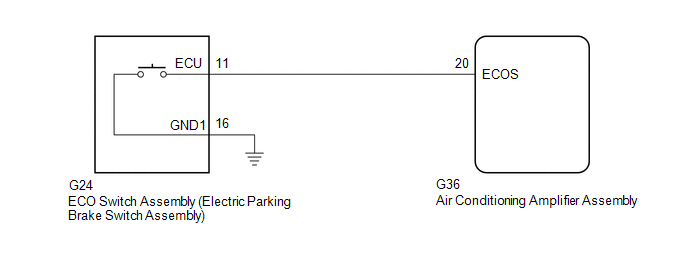
PROCEDURE
| 1. |
READ VALUE USING TECHSTREAM |
(a) Connect the Techstream to the DLC3.
(b) Turn the engine switch on (IG).
(c) Turn the Techstream on.
(d) Enter the following menus: Body Electrical / Air Conditioner / Data List.
(e) Read the Data List according to the display on the Techstream.
Body Electrical > Air Conditioner > Data List
|
Tester Display | Measurement Item |
Range | Normal Condition |
Diagnostic Note |
|
ECO Switch | ECO switch assembly (electric parking brake switch assembly) |
OFF or ON | OFF: ECO switch assembly (electric parking brake switch assembly) not pushed
ON: ECO switch assembly (electric parking brake switch assembly) pushed and held |
ECO switch assembly (electric parking brake switch assembly) circuit malfunction |
Body Electrical > Air Conditioner > Data List
|
Tester Display |
| ECO Switch |
OK:
ECO
switch assembly (electric parking brake switch assembly) condition
displayed on the Techstream changes with the actual switch operation.
| OK |
 | REPLACE AIR CONDITIONING AMPLIFIER ASSEMBLY |
|
NG |
 | |
| 2. |
INSPECT ECO SWITCH ASSEMBLY (ELECTRIC PARKING BRAKE SWITCH ASSEMBLY) |
(a) Remove the ECO switch assembly (electric parking brake switch assembly).
Click here 
(b) Inspect the ECO switch assembly (electric parking brake switch assembly).
Click here 
| NG |
 | REPLACE ECO SWITCH ASSEMBLY (ELECTRIC PARKING BRAKE SWITCH ASSEMBLY) |
|
OK |
 | |
| 3. |
CHECK HARNESS AND CONNECTOR (ECO SWITCH ASSEMBLY (ELECTRIC PARKING BRAKE SWITCH ASSEMBLY) - AIR CONDITIONING AMPLIFIER ASSEMBLY) |
(a) Disconnect the G36 air conditioning amplifier assembly connector.
(b) Measure the resistance according to the value(s) in the table below.
Standard Resistance:
|
Tester Connection | Condition |
Specified Condition |
|
G24-11 (ECU) - G36-20 (ECOS) |
Always | Below 1 ╬® |
|
G24-16 (GND1) - Body ground |
Always | Below 1 ╬® |
|
G24-11 (ECU) or G36-20 (ECOS) - Other terminals and body ground |
Always | 10 k╬® or higher |
| OK |
 | REPLACE AIR CONDITIONING AMPLIFIER ASSEMBLY |
| NG |
 | REPAIR OR REPLACE HARNESS OR CONNECTOR |
Front Window Fogging
DESCRIPTION
If the
windshield frequently fogs up even though the air conditioning system is
operating, the following factors may be the cause.
|
Symptom | Factor |
|
Windshield frequently fogs up |
- Cooler compressor assembly malfunction
- Refrigerant volume (low)
- Cooler expansion valve (opened excessively)
- No. 1 air conditioning radiator damper servo sub-assembly malfunction
- Mechanical locking of damper and damper link
|
PROCEDURE
| 1. |
PERFORM REFRIGERANT SHORTAGE CHECK |
(a) Connect the Techstream to the DLC3.
(b) Turn the engine switch on (IG).
(c) Turn the Techstream on.
(d) Enter the following menus: Body Electrical / Air Conditioner / Utility / Refrigerant Gas Volume Check.
Body Electrical > Air Conditioner > Utility
|
Tester Display |
| Refrigerant Gas Volume Check |
(e)
Check that the following conditions are met and perform the refrigerant
shortage check according to the display on the Techstream.
Measurement Condition: |
Item | Condition |
|
A/C switch | On |
|
Ambient temperature* |
0 to 49┬░C (32 to 120┬░F) |
|
Blower speed | HI |
*: If the ambient temperature is not within the range shown, do not perform this check.
|
Result | Amount of Refrigerant |
|
Refrigerant correct | Correct |
|
Refrigerant shortage |
Insufficient |
OK:
"Refrigerant correct" is displayed on the Techstream.
| NG |
 | CHARGE SYSTEM WITH REFRIGERANT |
|
OK |
 | |
(a) Press the front defroster switch on the air conditioning control panel (radio and display receiver assembly).
OK:
The air outlet mode changes to DEF mode.
| OK |
 | INSPECT REFRIGERANT PRESSURE WITH MANIFOLD GAUGE SET |
| NG |
 | GO TO DTC B1443 |
How To Proceed With Troubleshooting
CAUTION / NOTICE / HINT
HINT:
- Use the following procedure to troubleshoot the air conditioning system.
- *: Use the Techstream.
PROCEDURE
|
1. | VEHICLE BROUGHT TO WORKSHOP |
|
NEXT |
 | |
| 2. |
CUSTOMER PROBLEM ANALYSIS |
HINT:
- In troubleshooting, confirm that the problem symptoms have been
accurately identified. Preconceptions should be discarded in order to
make an accurate judgment. To clearly understand what the problem
symptoms are, it is extremely important to ask the customer about the
problem and the conditions at the time the malfunction occurred.
- Gather as much information as possible for reference. Past problems that seem unrelated may also help in some cases.
- The following 5 items are important points for problem analysis:
|
What |
Vehicle model, system name |
|
When |
Date, time, occurrence frequency |
|
Where |
Road conditions |
|
Under what conditions? |
Driving conditions, weather conditions |
|
How did it happen? |
Problem symptoms |
|
NEXT |
 | |
| 3. |
INSPECT BATTERY VOLTAGE |
(a) Inspect the battery voltage.
Standard Voltage:
11 to 14 V
If the voltage is below 11 V, recharge or replace the battery before proceeding to the next step.
(b) Check the fuses and relays.
(c)
Check the connector connections and terminals to make sure that there
are no abnormalities such as loose connections, deformation, etc.
|
NEXT |
 | |
| 4. |
CHECK COMMUNICATION FUNCTION OF CAN COMMUNICATION SYSTEM* |
(a) Using the Techstream, check for CAN communication system DTCs.
Click here

|
Result | Proceed to |
|
CAN communication system DTCs are not output |
A |
| CAN communication system DTCs are output |
B |
| B |
 | GO TO CAN COMMUNICATION SYSTEM |
|
A |
 | |
(a) Check for DTCs and note any codes that are output.
Body Electrical > Air Conditioner > Trouble Codes
(b) Clear the DTCs.
Body Electrical > Air Conditioner > Clear DTCs
(c)
Recheck for DTCs. Based on the DTCs output above, try to force output
of the air conditioning system DTC by simulating the operation indicated
by the DTC.
Body Electrical > Air Conditioner > Trouble Codes
|
Result | Proceed to |
|
DTCs are not output | A |
|
DTCs are output | B |
| B |
 | GO TO DIAGNOSTIC TROUBLE CODE CHART |
|
A |
 | |
| 6. |
CHECK AIR CONDITIONING CONTROL PANEL (RADIO AND DISPLAY RECEIVER ASSEMBLY) |
(a)
Operate each switch on the air conditioning control panel (radio and
display receiver assembly) and check that the switches of the air
conditioning system operate normally.
| NG |
 | GO TO PROBLEM SYMPTOMS TABLE |
|
OK |
 | |
(a)
Operate the blower switch on the air conditioning control panel (radio
and display receiver assembly) and check that the blower control
operates normally.
| NG |
 | GO TO PROBLEM SYMPTOMS TABLE |
|
OK |
 | |
| 8. |
CHECK AIR INLET CONTROL |
(a)
Operate the recirculation/fresh switch on the air conditioning control
panel (radio and display receiver assembly) and check that the air inlet
control operates normally.
| NG |  |
GO TO PROBLEM SYMPTOMS TABLE |
|
OK |
 | |
| 9. |
CHECK AIR OUTLET CONTROL |
(a)
Operate the air outlet mode switch on the air conditioning control
panel (radio and display receiver assembly) and check that the air
outlet control operates normally.
| NG |  |
GO TO PROBLEM SYMPTOMS TABLE |
|
OK |
 | |
| 10. |
CHECK COOLING FUNCTION |
(a)
Operate the temperature adjustment switches on the air conditioning
control panel (radio and display receiver assembly) and check that cool
air is blown from the registers.
| NG |  |
GO TO PROBLEM SYMPTOMS TABLE |
|
OK |
 | |
| 11. |
CHECK HEATER FUNCTION |
(a)
Operate the temperature adjustment switches on the air conditioning
control panel (radio and display receiver assembly) and check that warm
air is blown from the registers.
| NG |  |
GO TO PROBLEM SYMPTOMS TABLE |
|
OK |
 | |
| 12. |
USE SIMULATION METHOD TO CHECK |
Click here

|
NEXT |
 | |
| NEXT |
 | END |
Initialization
INITIALIZATION
SERVO MOTOR INITIALIZATION
(a) Connect the Techstream to the DLC3.
(b) Turn the engine switch on (IG).
(c) Press the OFF switch.
(d) Turn the Techstream on.
(e) Enter the following menus: Body Electrical / Air Conditioner / Utility / Servomotor Initialization.
(f) According to the Techstream display, perform servo motor initialization.
Body Electrical > Air Conditioner > Utility
|
Tester Display |
| Servomotor Initialization |
HINT:
When
initialization is started, the AUTO switch indicator will illuminate
and then will turn off when initialization has completed.
(g) Select Exit to complete initialization.
No Cool Air Comes Out
DESCRIPTION
If warm air
blows from the registers regardless of the temperature setting of the
air conditioning system, the following factors may be the cause.
|
Symptom | Factor |
|
No cool air comes out
- (Blower control is normal)
|
- Cooler compressor assembly malfunction
- Refrigerant pressure is extremely high or low
- Refrigerant volume (low)
- Clogged cooler condenser assembly fins
- Cooling fan system malfunction
- Mechanical locking of damper and damper link
- No. 1 cooler thermistor malfunction
- High inlet air temperature
|
PROCEDURE
| 1. |
CHECK SWITCH INDICATOR |
(a)
Operate each switch on the air conditioning control panel (radio and
display receiver assembly) and check that the switch indicators operate
normally.
OK:
All switch indicators operate normally.
| NG |
 | GO TO OTHER DIAGNOSIS PROCEDURE (Operation not Accepted Even If Air Conditioning Switch is Operated) |
|
OK |
 | |
| 2. |
PERFORM ACTIVE TEST USING TECHSTREAM |
(a) Connect the Techstream to the DLC3.
(b) Turn the engine switch on (IG).
(c) Turn the Techstream on.
(d) Enter the following menus: Body Electrical / Air Conditioner / Active Test.
(e) Perform the Active Test according to the display on the Techstream.
Body Electrical > Air Conditioner > Active Test
|
Tester Display | Measurement Item |
Control Range | Diagnostic Note |
|
Air Mix Servo Targ Pulse(D) |
No. 1 air conditioning radiator damper servo sub-assembly (driver side air mix) pulse |
Min.: 128 Max.: 383 |
Operates between 165 and 257 pulses |
|
Air Mix Servo Targ Pulse(P) |
No. 1 air conditioning radiator damper servo sub-assembly (front passenger side air mix) pulse |
Min.: 128 Max.: 383 |
Operates between 255 and 347 pulses |
Body Electrical > Air Conditioner > Active Test
|
Tester Display |
| Air Mix Servo Targ Pulse(D) |
Body Electrical > Air Conditioner > Active Test
|
Tester Display |
| Air Mix Servo Targ Pulse(P) |
OK:
Each damper servo motor operates.
| OK |
 | INSPECT REFRIGERANT PRESSURE WITH MANIFOLD GAUGE SET |
| NG |
 | GO TO DTC TROUBLESHOOTING PROCEDURE FOR MALFUNCTIONING DAMPER SERVO MOTOR |
No Warm Air Comes Out
DESCRIPTION
If cool air
blows from the registers regardless of the temperature setting of the
air conditioning system, the following factors may be the cause.
|
Symptom | Factor |
- No warm air comes out
- (Blower control is normal)
- Outlet air temperature does not increase
- (Blower control is normal)
|
- Engine coolant temperature (low)
- Refrigerant volume (low)
- No. 1 air conditioning radiator damper servo sub-assembly malfunction
- Warm-up control
- Blockage in heater radiator unit sub-assembly
- Heater radiator unit sub-assembly malfunction
|
PROCEDURE
| 1. |
READ VALUE USING TECHSTREAM |
(a) Connect the Techstream to the DLC3.
(b) Turn the engine switch on (IG).
(c) Turn the Techstream on.
(d) Enter the following menus: Powertrain / Engine / Data List.
(e) Read the Data List according to the display on the Techstream.
Powertrain > Engine > Data List
|
Tester Display | Measurement Item |
Range | Normal Condition |
Diagnostic Note |
|
Coolant Temperature | Engine coolant temperature |
Min.: -40┬░C (-40┬░F), Max.: 140┬░C (284┬░F) |
75 to 100┬░C (167 to 212┬░F): After warming up |
This is the engine coolant temperature.
HINT:
- After warming up the engine, the engine coolant temperature will be 75 to 100┬░C (167 to 212┬░F).
- After a long soak, the engine coolant temperature, intake air
temperature and ambient air temperature will be approximately equal.
- If the value is -40┬░C (-40┬░F), or higher than 135┬░C (275┬░F), the sensor circuit is open or shorted.
- Check if the engine overheats if the value indicated is higher than 135┬░C (275┬░F).
|
Powertrain > Engine > Data List
|
Tester Display |
| Coolant Temperature |
OK:
After warming up the engine, the temperature value displayed is within the range specified in the normal condition column.
| NG |
 | GO TO COOLING SYSTEM |
|
OK |
 | |
| 2. |
PERFORM ACTIVE TEST USING TECHSTREAM |
(a) Connect the Techstream to the DLC3.
(b) Turn the engine switch on (IG).
(c) Turn the Techstream on.
(d) Enter the following menus: Body Electrical / Air Conditioner / Active Test.
(e) Perform the Active Test according to the display on the Techstream.
Body Electrical > Air Conditioner > Active Test
|
Tester Display | Measurement Item |
Control Range | Diagnostic Note |
|
Air Mix Servo Targ Pulse(D) |
No. 1 air conditioning radiator damper servo sub-assembly (driver side air mix) pulse |
Min.: 128 Max.: 383 |
Operates between 165 and 257 pulses |
|
Air Mix Servo Targ Pulse(P) |
No. 1 air conditioning radiator damper servo sub-assembly (front passenger side air mix) pulse |
Min.: 128 Max.: 383 |
Operates between 255 and 347 pulses |
Body Electrical > Air Conditioner > Active Test
|
Tester Display |
| Air Mix Servo Targ Pulse(D) |
Body Electrical > Air Conditioner > Active Test
|
Tester Display |
| Air Mix Servo Targ Pulse(P) |
OK:
Each damper servo motor operates.
| OK |
 | REPLACE HEATER RADIATOR UNIT SUB-ASSEMBLY |
| NG |
 | GO TO DTC TROUBLESHOOTING PROCEDURE FOR MALFUNCTIONING DAMPER SERVO MOTOR |
Operation not Accepted Even If Air Conditioning Switch is Operated
DESCRIPTION
If the air
conditioning system cannot be operated using the air conditioning
control panel (radio and display receiver assembly), the following
factors may be the cause.
|
Symptom | Factor |
|
Air conditioning system cannot be operated using air conditioning control panel (radio and display receiver assembly)
- (With the exception of the switch indicators, no inputs are reflected when other switches operated)
|
- LIN communication malfunction between air conditioning amplifier
assembly and air conditioning control panel (radio and display receiver
assembly)
- Short to +B or ground in air conditioning amplifier assembly circuit
- Air conditioning amplifier assembly malfunction
- Air conditioning control panel (radio and display receiver assembly) malfunction
- Harness or connector
|
WIRING DIAGRAM
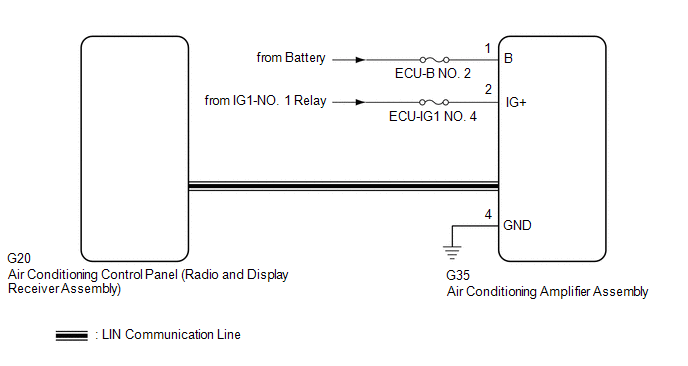
CAUTION / NOTICE / HINT
NOTICE:
Inspect the fuses for circuits related to this system before performing the following procedure.
PROCEDURE
(a) Check for DTCs.
Body Electrical > Air Conditioner > Trouble Codes
|
Result | Proceed to |
|
B14B2 is not output | A |
|
B14B2 is output | B |
| B |
 | GO TO DTC B14B2 |
|
A |
 | |
| 2. |
CHECK HARNESS AND CONNECTOR (AIR CONDITIONING AMPLIFIER ASSEMBLY - BATTERY AND BODY GROUND) |
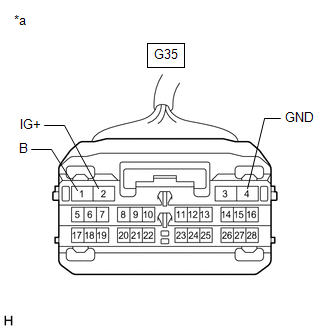
|
*a | Front view of wire harness connector
(to Air Conditioning Amplifier Assembly) |
(a) Disconnect the G35 air conditioning amplifier assembly connector.
(b) Measure the voltage and resistance according to the value(s) in the table below.
Standard Voltage:
|
Tester Connection | Switch Condition |
Specified Condition |
|
G35-1 (B) - Body ground |
Always | 11 to 14 V |
|
G35-2 (IG+) - Body ground |
Engine switch on (IG) |
11 to 14 V |
|
Engine switch off | Below 1 V |
Standard Resistance:
|
Tester Connection | Condition |
Specified Condition |
|
G35-4 (GND) - Body ground |
Always | Below 1 ╬® |
| OK |
 | REPLACE AIR CONDITIONING AMPLIFIER ASSEMBLY |
| NG |
 | REPAIR OR REPLACE HARNESS OR CONNECTOR |
Parts Location
PARTS LOCATION
ILLUSTRATION
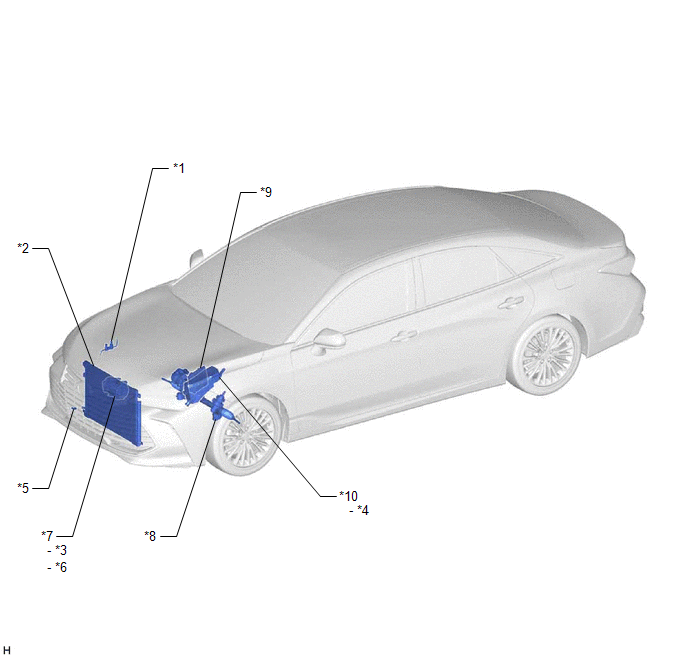
|
*1 | AIR CONDITIONER PRESSURE SENSOR |
*2 | COOLER CONDENSER ASSEMBLY |
|
*3 | MAGNET CLUTCH ASSEMBLY |
*4 | MG CLT RELAY |
|
*5 | THERMISTOR ASSEMBLY |
*6 | COOLER COMPRESSOR ASSEMBLY |
|
*7 | COMPRESSOR ASSEMBLY WITH MAGNETIC CLUTCH |
*8 | POWER STEERING ECU (RACK AND PINION POWER STEERING GEAR ASSEMBLY) |
|
*9 | ECM |
*10 | NO. 1 ENGINE ROOM RELAY BLOCK AND NO. 1 JUNCTION BLOCK ASSEMBLY
- HTR FUSE - A/C COMP FUSE |
ILLUSTRATION
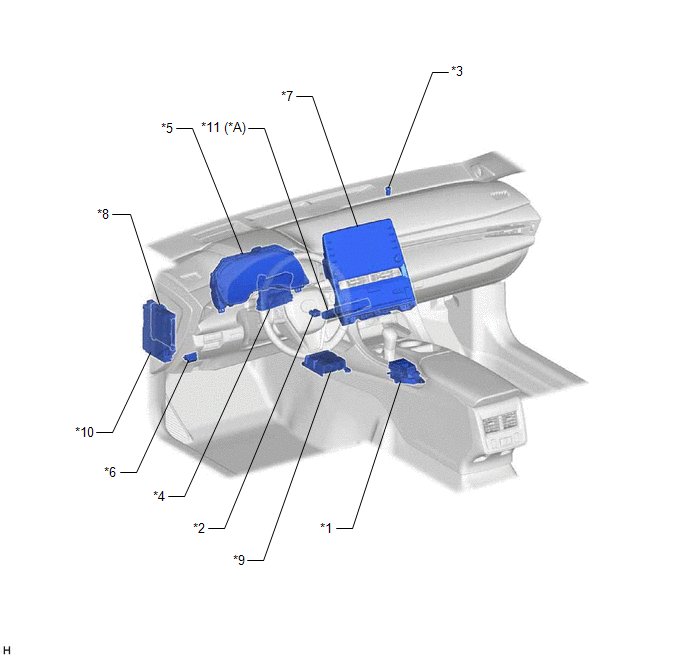
|
*A | w/ Manual (SOS) Switch |
- | - |
|
*1 | ECO SWITCH ASSEMBLY (ELECTRIC PARKING BRAKE SWITCH ASSEMBLY) |
*2 | COOLER (ROOM TEMP. SENSOR) THERMISTOR |
|
*3 | AUTOMATIC LIGHT CONTROL SENSOR |
*4 | AIR CONDITIONING AMPLIFIER ASSEMBLY |
|
*5 | COMBINATION METER ASSEMBLY |
*6 | DLC3 |
|
*7 | AIR CONDITIONING CONTROL PANEL (RADIO AND DISPLAY RECEIVER ASSEMBLY) |
*8 | MAIN BODY ECU (MULTIPLEX NETWORK BODY ECU) |
|
*9 | AIRBAG ECU ASSEMBLY |
*10 | INSTRUMENT PANEL JUNCTION BLOCK ASSEMBLY
- ECU-B NO. 2 FUSE - ECU-IG1 NO. 3 FUSE - ECU-IG1 NO. 4 FUSE
- ECU-ACC FUSE |
|
*11 | DCM (TELEMATICS TRANSCEIVER) |
- | - |
ILLUSTRATION
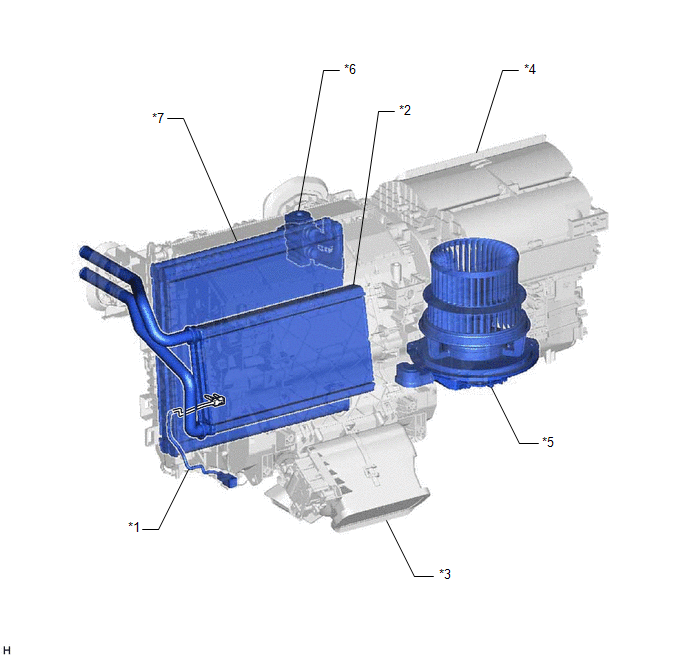
|
*1 | NO. 1 COOLER THERMISTOR |
*2 | HEATER RADIATOR UNIT SUB-ASSEMBLY |
|
*3 | AIR CONDITIONING RADIATOR ASSEMBLY |
*4 | BLOWER ASSEMBLY |
|
*5 | BLOWER MOTOR WITH FAN SUB-ASSEMBLY |
*6 | COOLER EXPANSION VALVE |
|
*7 | NO. 1 COOLER EVAPORATOR SUB-ASSEMBLY |
- | - |
ILLUSTRATION
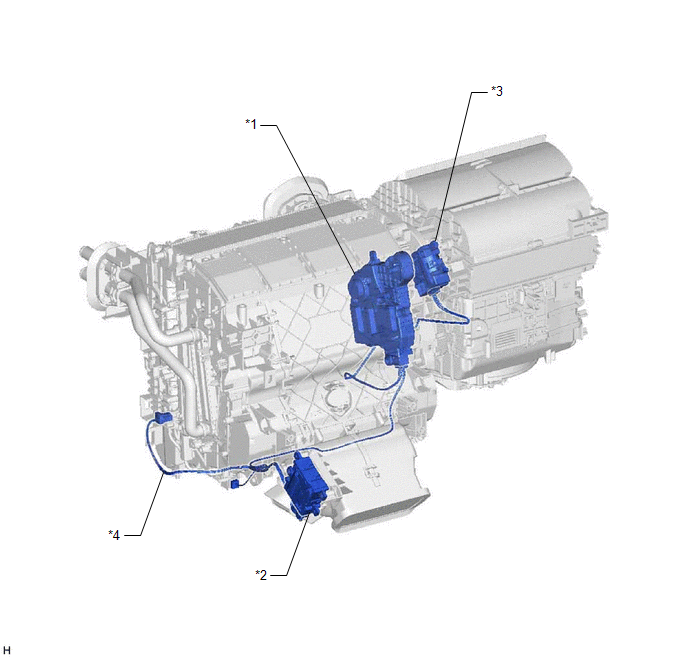
|
*1 | NO. 1 AIR CONDITIONING RADIATOR DAMPER SERVO SUB-ASSEMBLY |
*2 | NO. 2 AIR CONDITIONING RADIATOR DAMPER SERVO SUB-ASSEMBLY |
|
*3 | NO. 1 BLOWER DAMPER SERVO SUB-ASSEMBLY |
*4 | AIR CONDITIONING HARNESS ASSEMBLY |
Precaution
PRECAUTION
PRECAUTION FOR DISCONNECTING CABLE FROM NEGATIVE BATTERY TERMINAL
NOTICE:
When
disconnecting the cable from the negative (-) battery terminal,
initialize the following systems after the cable is reconnected.
|
System Name | See Procedure |
|
Lane Departure Alert System (w/ Steering Control) |
 |
|
Intelligent Clearance Sonar System |
|
Parking Assist Monitor System |
|
Panoramic View Monitor System |
|
Pre-collision System |
|
Lighting System (for Gasoline Model with Cornering Light) |
DO NOT HANDLE REFRIGERANT IN AN ENCLOSED AREA OR NEAR AN OPEN FLAME
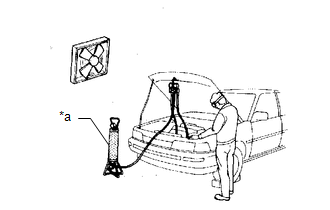
ALWAYS WEAR EYE PROTECTION
BE CAREFUL NOT TO GET LIQUID REFRIGERANT IN YOUR EYES OR ON YOUR SKIN
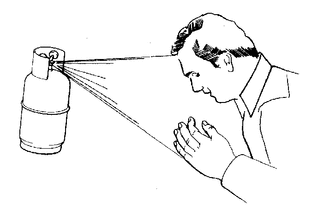
If liquid refrigerant gets in your eyes or on your skin.
(a) Wash the area with lots of cold water.
CAUTION:
Do not rub your eyes or skin.
(b) Apply clean petroleum jelly to the skin.
(c) Go immediately to a hospital or see a physician for professional treatment.
NEVER HEAT CONTAINER OR EXPOSE CONTAINER TO AN OPEN FLAME
BE CAREFUL NOT TO DROP CONTAINER OR APPLY PHYSICAL SHOCKS TO IT
DO NOT OPERATE COMPRESSOR WITHOUT ENOUGH REFRIGERANT IN REFRIGERANT SYSTEM
If
there is not enough refrigerant in the air conditioning system, oil
lubrication will be insufficient and the compressor may be damaged.
Necessary care should be taken to avoid this.
DO NOT OPEN HIGH PRESSURE MANIFOLD VALVE WHILE COMPRESSOR IS OPERATING
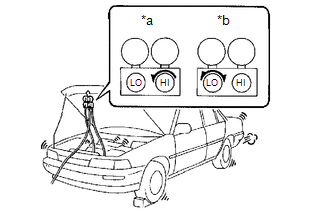
Open and close only the low pressure valve.
If the high pressure valve is opened, refrigerant will flow in the reverse direction causing the charging cylinder to rupture.
BE CAREFUL NOT TO OVERCHARGE SYSTEM WITH REFRIGERANT
If
the system is overcharged with refrigerant, it causes problems such as
insufficient cooling, poor fuel economy, engine overheating, etc.
DO NOT OPERATE ENGINE AND COMPRESSOR WITH NO REFRIGERANT
CAUTION:
Doing
so may damage the inside of the compressor because the compressor parts
always move regardless of whether the air conditioning system is turned
on or off.
SUPPLEMENTAL RESTRAINT SYSTEM (SRS)
This
vehicle is equipped with a Supplemental Restraint System (SRS). Failure
to carry out service operations in the correct sequence could cause the
SRS to unexpectedly deploy during servicing, possibly leading to a
serious accident. Before servicing (including removal or installation of
parts, inspection or replacement), be sure to read the precautionary
notices.
Click here 
GENERAL PRECAUTION
While
using the battery during inspection, do not bring the positive (+) and
negative (-) tester probes too close to each other as a short circuit
may occur.
Problem Symptoms Table
PROBLEM SYMPTOMS TABLE
HINT:
- Use the table below to help determine the cause of problem symptoms. If
multiple suspected areas are listed, the potential causes of the
symptoms are listed in order of probability in the "Suspected Area"
column of the table. Check each symptom by checking the suspected areas
in the order they are listed. Replace parts as necessary.
- Inspect the fuses and relays related to this system before inspecting the suspected areas below.
VEHICLE CHECK ITEMS
HINT:
- You can reduce the number of systems to check by using the results of the following operation check
- Perform the following checks based on Customer Feedback and the vehicle condition.
- The customer's opinion may not be consistent with the actual problem
(eg: the cooling performance of the air conditioner is bad ŌåÆ actually,
the wind volume is weak). It is important to check the problem symptoms
accurately and judge correctly based on various sources of information.
- Judgment as to whether the air conditioner panel is normal or abnormal
can be judged by checking if the indicator illuminates or turns off when
the switch is operated.
- During servo motor initialization, the AUTO indicator light comes on, and then goes off when initialization has finished.
- If the performance of the air conditioner is poor or there is a foul odor, check for clogging in the clean air filter.
Malfunction Operation/Function:
|
Common Function of Cool and Heater Function |
Only Cool Air Function |
Only Heater Function |
Suspected Area |
|
A/C Switch Operation |
Blower Operation | Recirculation/Fresh Function |
Air Outlet Changing Function |
|
x | o |
o | o |
x | x |
Go to "Problem Symptoms Table: Air Conditioning Control" |
|
o | o |
o | o |
x | o |
Go to "Problem Symptoms Table: Cooling Function" |
|
o | o |
o | o |
o | x |
Go to "Problem Symptoms Table: Heater Function" |
|
o | x |
o | o |
x | x |
Go to "Problem Symptoms Table: Blower Control" |
|
o | o |
x | o |
x | x |
Go to "Problem Symptoms Table: Air Inlet Control" |
|
o | o |
o | x |
x | x |
Go to "Problem Symptoms Table: Air Outlet Control" |
|
x | x |
x | x |
x | x |
Air Conditioning Amplifier Assembly or Air Conditioning Assembly is Defective |
AIR CONDITIONING CONTROL
|
Symptom | Suspected Area |
Link |
| Air conditioning system cannot be operated using air conditioning control panel (radio and display receiver assembly)
- (With the exception of the switch indicators, no inputs are reflected when other switches operated)
|
- Air conditioning amplifier assembly
- Air conditioning control panel (radio and display receiver assembly)
|
 |
|
Air conditioning system cannot be operated using air conditioning control panel (radio and display receiver assembly)
- (Air conditioning system display operates)
| Air conditioning control panel (radio and display receiver assembly) |
 |
|
Air
conditioning system cannot be operated using air conditioning control
panel (radio and display receiver assembly) immediately after starting
the engine
- (Air conditioning system display operates)
- (Only AUTO indicator illuminates)
- (A/C switch indicator does not illuminate)
| Refer to "INITIALIZATION" |
 |
|
A/C switch indicator does not illuminate |
- Air conditioning amplifier assembly
- Air conditioning control panel (radio and display receiver assembly)
- A/C switch
- A/C switch indicator
- Servo motor
- Damper and damper link
- Refrigerant pressure
- Ambient temperature
|
 |
COOLING FUNCTION
|
Symptom | Suspected Area |
Link |
| No cool air comes out
- (Blower control is normal)
|
- Cooler compressor assembly
- Refrigerant pressure
- Refrigerant volume
- Cooler condenser assembly
- Cooling fan system
- Damper and damper link
- No. 1 cooler thermistor
- High inlet air temperature
|
 |
- Cooling effectiveness is poor
- Cooling response is slow
|
- ECO switch assembly (electric parking brake switch assembly)
- Cooler compressor assembly
- Refrigerant volume
- Cooler condenser assembly
- Cooling fan system
- Damper and damper link
- Automatic light control sensor
- High inlet air temperature
- Harness or connector
|
 |
|
Temperature of outlet air is cooler on left or right side
- (when same temperature set for both sides)
|
- Cooler compressor assembly
- Refrigerant volume
- Damper and damper link
- Automatic light control sensor
- Harness or connector
|
 |
- Compressor assembly with pulley does not stop operating
- Refrigerant pressure does not decrease when A/C switch is turned off
|
- Short to +B in air conditioning amplifier assembly circuit
- MG CLT relay
- Magnet clutch assembly
|
 |
HEATER FUNCTION
|
Symptom | Suspected Area |
Link |
|
|
- Engine coolant temperature
- Refrigerant volume
- No. 1 air conditioning radiator damper servo sub-assembly
- Damper and damper link
- Warm-up control
- Blockage in heater radiator unit sub-assembly
- Heater radiator unit sub-assembly
|
 |
|
Temperature of outlet air is warmer on left or right side
- (when same temperature set for both sides)
|
- Damper and damper link
- Blockage in heater radiator unit sub-assembly
- Harness or connector
|
 |
BLOWER CONTROL
|
Symptom | Suspected Area |
Link |
| Blower motor does not operate at all
- (Air does not blow from registers)
|
- Blower motor with fan sub-assembly
- Air conditioning amplifier assembly
- Warm-up control
- Engine coolant temperature sensor
- Harness or connector
|
 |
|
Airflow volume cannot be changed |
- Air conditioning amplifier assembly
- Blower motor with fan sub-assembly
- Harness or connector
|
 |
- Airflow volume is constantly low
- Airflow volume sometimes becomes low
|
- Blower motor with fan sub-assembly
- ECO switch assembly (electric parking brake switch assembly)
- Clean air filter
- No. 1 cooler evaporator sub-assembly or heater radiator unit sub-assembly fins
- No. 1 cooler thermistor
- Aspirator
|
 |
AIR INLET CONTROL
|
Symptom | Suspected Area |
Link |
- Air inlet mode changes between recirculation/fresh randomly
- Recirculation/fresh switch indicator is blinking
|
- Customize setting*
- Ambient temperature
- Refrigerant pressure
- Air conditioner pressure sensor circuit
- Engine coolant temperature
|
 |
- Air inlet mode cannot be changed between recirculation/fresh
- Air inlet mode does not change between recirculation/fresh automatically
|
- No. 1 blower damper servo sub-assembly
- Damper link
- Air inlet damper mechanically locked
- Engine coolant temperature
- Air conditioner unit assembly
|
 |
AIR OUTLET CONTROL
|
Symptom | Suspected Area |
Link |
| Air outlet mode cannot be changed
- (air outlet display changes)
|
- No. 1 air conditioning radiator damper servo sub-assembly
- Damper link
- Air conditioner unit assembly
|
 |
|
Air outlet mode cannot be changed
- (air outlet display does not change)
| Air conditioning control panel (radio and display receiver assembly) |
 |
DEFROSTER CONTROL
|
Symptom | Suspected Area |
Link |
| Windshield frequently fogs up |
- Cooler compressor assembly
- Refrigerant volume
- Cooler expansion valve
- No. 1 air conditioning radiator damper servo sub-assembly
- Damper and damper link
|
 |
Recirculated/Fresh Air Modes do not Switch
DESCRIPTION
If the air
inlet mode cannot be changed between recirculation/fresh or exhaust gas
odors can be smelled even though recirculation mode is selected, the
following factors may be the cause.
|
Symptom | Factor |
- Air inlet mode cannot be changed between recirculation/fresh
- Exhaust gas odors can be smelled when air inlet mode set to recirculation mode
|
- No. 1 blower damper servo sub-assembly malfunction
- Damper link disconnection
- Air inlet damper mechanically locked
- Engine coolant temperature (high)
- Air conditioner unit assembly malfunction
|
PROCEDURE
| 1. |
CHECK NO. 1 BLOWER DAMPER SERVO SUB-ASSEMBLY |
(a) Check that the No. 1 blower damper servo sub-assembly is installed correctly.
OK:
The No. 1 blower damper servo sub-assembly is installed correctly.
| NG |
 | INSTALL NO. 1 BLOWER DAMPER SERVO SUB-ASSEMBLY CORRECTLY |
|
OK |
 | |
(a) Check for DTCs.
Body Electrical > Air Conditioner > Trouble Codes
|
Result | Proceed to |
|
B1442 is not output | A |
|
B1442 is output | B |
| B |
 | GO TO DTC B1442 |
|
A |
 | |
| 3. |
READ VALUE USING TECHSTREAM |
(a) Connect the Techstream to the DLC3.
(b) Turn the engine switch on (IG).
(c) Turn the Techstream on.
(d) Enter the following menus: Powertrain / Engine / Data List.
(e) Read the Data List according to the display on the Techstream.
Powertrain > Engine > Data List
|
Tester Display | Measurement Item |
Range | Normal Condition |
Diagnostic Note |
|
Coolant Temperature | Engine coolant temperature |
Min.: -40┬░C (-40┬░F), Max.: 140┬░C (284┬░F) |
75 to 100┬░C (167 to 212┬░F): After warming up |
This is the engine coolant temperature.
HINT:
- After warming up the engine, the engine coolant temperature will be 75 to 100┬░C (167 to 212┬░F).
- After a long soak, the engine coolant temperature, intake air
temperature and ambient air temperature will be approximately equal.
- If the value is -40┬░C (-40┬░F), or higher than 135┬░C (275┬░F), the sensor circuit is open or shorted.
- Check if the engine overheats if the value indicated is higher than 135┬░C (275┬░F).
|
Powertrain > Engine > Data List
|
Tester Display |
| Coolant Temperature |
OK:
After warming up the engine, the temperature value displayed is within the range specified in the normal condition column.
| OK |
 | REPLACE AIR CONDITIONER UNIT ASSEMBLY |
| NG |
 | GO TO COOLING SYSTEM |
Recirculated/Fresh Air Modes Switch without User Input
DESCRIPTION
If recirculation/fresh mode changes unintentionally and without permission, the following causes are possible.
|
Symptom | Factor |
- Recirculation/fresh mode changes without permission
- Recirculation/fresh mode light blinks
|
- Customize setting*
- Change in ambient air temperature
- Decrease in refrigerant pressure
- Air conditioner pressure sensor circuit malfunction
- Engine coolant temperature (high)
|
PROCEDURE
| Result |
Proceed to |
| for USA and Canada |
A |
| except USA and Canada |
B |
| A |
 | GO TO STEP 3 |
|
B |
 | |
| 2. |
CHECK CUSTOMIZE SETTING |
(a) Using the Techstream, check that the customize setting Air Inlet Mode is not set to "Automatic".
Air Conditioner
|
Tester Display | Description |
Default | Setting |
ECU |
| Air Inlet Mode |
Function to change the mode automatically to recirculation air mode when turning the A/C on to cool the cabin quickly |
Automatic | 0:Automatic,1:Manual |
Air conditioning amplifier assembly |
OK:
Air Inlet Mode is not set to "Automatic".
| NG |
 | CUSTOMIZE SETTING |
|
OK |
 | |
| 3. |
READ VALUE USING TECHSTREAM |
(a) Connect the Techstream to the DLC3.
(b) Turn the engine switch on (IG).
(c) Turn the Techstream on.
(d) Enter the following menus: Body Electrical / Air Conditioner / Data List.
(e) Read the Data List according to the display on the Techstream.
Body Electrical > Air Conditioner > Data List
|
Tester Display | Measurement Item |
Range | Normal Condition |
Diagnostic Note |
|
Ambient Temp Sensor | Thermistor assembly |
Min.: -23.30┬░C (-9.94┬░F) Max.: 65.95┬░C (150.71┬░F) |
Actual ambient temperature displayed |
Thermistor assembly circuit malfunction
- When open circuit: -23.30┬░C (-9.94┬░F)
- When short circuit: 65.95┬░C (150.71┬░F)
|
Body Electrical > Air Conditioner > Data List
|
Tester Display |
| Ambient Temp Sensor |
OK:
The value of the display does not change frequently.
| NG |
 | GO TO AMBIENT TEMPERATURE DISPLAY SYSTEM |
|
OK |
 | |
| 4. |
READ VALUE USING TECHSTREAM |
(a) Connect the Techstream to the DLC3.
(b) Turn the engine switch on (IG).
(c) Turn the Techstream on.
(d) Enter the following menus: Powertrain / Engine / Data List.
(e) Read the Data List according to the display on the Techstream.
Powertrain > Engine > Data List
|
Tester Display | Measurement Item |
Range | Normal Condition |
Diagnostic Note |
|
Coolant Temperature | Engine coolant temperature |
Min.: -40┬░C (-40┬░F), Max.: 140┬░C (284┬░F) |
75 to 100┬░C (167 to 212┬░F): After warming up |
This is the engine coolant temperature.
HINT:
- After warming up the engine, the engine coolant temperature will be 75 to 100┬░C (167 to 212┬░F).
- After a long soak, the engine coolant temperature, intake air
temperature and ambient air temperature will be approximately equal.
- If the value is -40┬░C (-40┬░F), or higher than 135┬░C (275┬░F), the sensor circuit is open or shorted.
- Check if the engine overheats if the value indicated is higher than 135┬░C (275┬░F).
|
Powertrain > Engine > Data List
|
Tester Display |
| Coolant Temperature |
OK:
The value of the display does not change frequently.
| NG |
 | GO TO COOLING SYSTEM |
|
OK |
 | |
| 5. |
CHECK REFRIGERANT PRESSURE |
(a) Connect the Techstream to the DLC3.
(b) Turn the engine switch on (IG).
(c) Turn the Techstream on.
(d) Enter the following menus: Body Electrical / Air Conditioner / Data List.
(e) Read the Data List according to the display on the Techstream.
Body Electrical > Air Conditioner > Data List
|
Tester Display | Measurement Item |
Range | Normal Condition |
Diagnostic Note |
|
Regulator Pressure Sensor |
Air conditioner pressure sensor |
Min.: -66.2 psi (gauge) Max.: 478.0 psi (gauge) |
Actual refrigerant pressure displayed |
- Refrigerant line (gas leak etc.)
- Air conditioner pressure sensor circuit malfunction
|
Body Electrical > Air Conditioner > Data List
|
Tester Display |
| Regulator Pressure Sensor |
(f) Install a manifold gauge set.
(g) Read the manifold gauge pressure when the following conditions are met.
(1) Prepare the vehicle according to the table below.
Measurement Condition: |
Item | Condition |
|
Vehicle doors | Fully open |
|
Temperature setting | MAX COLD |
|
Blower speed | HI |
|
A/C switch | On |
|
Recirculation/fresh switch |
RECIRCULATION |
|
Interior temperature |
25 to 35┬░C (77 to 95┬░F) |
Standard Pressure:
Low pressure side
150 to 250 kPa (1.5 to 2.5 kgf/cm2, 22 to 36 psi)
High pressure side
1370 to 1570 kPa (14 to 16 kgf/cm2, 199 to 228 psi)
(h) Compare the values displayed in the Data List and on the manifold gauge.
OK:
The values displayed in the Data List and on the manifold gauge match.
| OK |
 | GO TO ON-VEHICLE INSPECTION (CHECK REFRIGERANT PRESSURE USING GAUGE) |
| NG |
 | REPLACE AIR CONDITIONER PRESSURE SENSOR |
System Description
SYSTEM DESCRIPTION
COMMUNICATION SYSTEM FUNCTION
(a)
The air conditioning amplifier assembly communicates with each ECU via
CAN communication and LIN communication. Additionally, the air
conditioning amplifier assembly sends operation signals to each damper
servo motor and receives damper position information and sensor
information from the damper servo motors and No. 1 cooler thermistor
through the air conditioning harness assembly.
Air Conditioning Amplifier Assembly ŌåÉŌåÆ Airbag ECU Assembly |
Receiver | Sender |
Signal | Communication Line |
|
Air conditioning amplifier assembly |
Airbag ECU assembly | Front passenger seat belt buckle switch status signal |
CAN |
| Front passenger seat occupant status signal |
Air Conditioning Amplifier Assembly ŌåÉŌåÆ Main Body ECU (Multiplex Network Body ECU) |
Receiver | Sender |
Signal | Communication Line |
|
Air conditioning amplifier assembly |
Main body ECU (multiplex network body ECU) |
Auto dimmer signal |
CAN |
| Front passenger door courtesy switch signal |
|
Rear right door courtesy switch signal |
|
Rear left door courtesy switch signal |
|
High beam headlight request signal |
|
Low beam headlight request signal |
|
Destination symbol signal |
|
Country code 1st signal |
|
Country code 2nd signal |
|
Country code 3rd signal |
|
Steering wheel signal |
|
Solar data (R) signal |
|
Solar data (L) signal |
|
Main body ECU (multiplex network body ECU) |
Air conditioning amplifier assembly |
Rear defogger drive request signal |
CAN |
| Ambient temperature display signal |
Air Conditioning Amplifier Assembly ŌåÉŌåÆ Power Steering ECU (Rack and Pinion Power Steering Gear Assembly) |
Receiver | Sender |
Signal | Communication Line |
|
Air conditioning amplifier assembly |
Power steering ECU (rack and pinion power steering gear assembly) |
Loading control level signal |
CAN |
| Power steering ECU (rack and pinion power steering gear assembly) |
Air conditioning amplifier assembly |
Ambient temperature display signal |
CAN |
Air Conditioning Amplifier Assembly ŌåÉŌåÆ Combination Meter Assembly |
Receiver | Sender |
Signal | Communication Line |
|
Air conditioning amplifier assembly |
Combination meter assembly |
Vehicle speed signal (meter to other) |
CAN |
| Temperature unit signal (centigrade/fahrenheit) |
|
Combination meter assembly |
Air conditioning amplifier assembly |
Ambient temperature display signal |
CAN |
| Ambient temperature display whole number/decimal (0/0.5┬░C) signal |
Air Conditioning Amplifier Assembly ŌåÉŌåÆ Air Conditioning Control Panel (Radio and Display Receiver Assembly) |
Receiver | Sender |
Signal | Communication Line |
|
Air conditioning amplifier assembly |
Air conditioning control panel (radio and display receiver assembly) |
AUTO switch state signal |
CAN |
| Rear defogger switch state signal |
|
Air outlet switch state signal |
|
OFF switch state signal |
|
A/C switch state signal |
|
SYNC switch state signal |
|
Mode switch state signal |
|
Blower up switch state signal |
|
Blower down switch state signal |
|
Driver side TEMP up switch state signal |
|
Driver side TEMP down switch state signal |
|
Front passenger side TEMP up switch state signal |
|
Front passenger side TEMP down switch state signal |
|
Blower level switch state signal 1 |
|
Blower level switch state signal 2 |
|
Blower level switch state signal 3 |
|
Blower level switch state signal 4 |
|
Blower level switch state signal 5 |
|
Blower level switch state signal 6 |
|
Blower level switch state signal 7 |
|
Driver side seat speech recognition operation mode information signal |
|
Driver side seat speech recognition data addition subtraction information signal |
|
Driver side seat speech recognition temperature directions data signal |
|
Front passenger side seat speech recognition operation mode information signal |
|
Front passenger side seat speech recognition data addition subtraction information signal |
|
Front passenger side seat speech recognition temperature directions data signal |
|
AVN1S39 valid information |
|
Independent A/C control information signal |
LIN |
| AUTO composite switch operation signal |
|
AUTO switch operation signal |
|
OFF switch operation signal |
|
A/C switch operation signal |
|
Blower switch operation signal |
|
Air outlet mode switch operation signal |
|
Front defroster switch operation signal |
|
Rear defogger switch operation signal |
|
SYNC switch operation signal |
|
Driver side temperature setting signal |
|
Front passenger side temperature setting signal |
|
Front right seat heater switch signal |
|
Front left seat heater switch signal |
|
Existence of seat AUTO function signal |
|
Existence of seat ventilator/heater function signal |
|
Part number information 1 signal |
|
Part number information 2 signal |
|
Part number information 3 signal |
|
Part number information 4 signal |
|
Part number information 5 signal |
|
Air conditioning control panel (radio and display receiver assembly) |
Air conditioning amplifier assembly |
A/C display request signal |
CAN |
| AUTO indicator signal |
|
Rear defogger indicator signal |
|
A/C indicator signal |
|
SYNC indicator signal |
|
Blower level indicator signal |
|
Outlet AUTO indicator signal |
|
Outlet indicator signal |
|
Blower manual status signal |
|
Blower customize indicator signal |
|
A/C on-screen request signal |
|
Driver side temperature display signal |
|
Front passenger side temperature display signal |
|
A/C screen select information signal |
|
Switch design DUAL/SYNC. Select information signal |
|
Temperature unit select information signal |
|
Blower step select information signal |
|
Speech recognition level information signal |
|
Destination select information signal |
|
Control information status signal |
|
Ambient temperature display signal |
|
Ambient temperature display whole number/decimal (0/0.5┬░C) signal |
|
ECO mode indicator signal |
LIN |
| Entire front panel display instruction signal |
|
AUTO indicator signal |
|
Blower level indicator signal |
|
Recirculation indicator signal |
|
Air outlet mode display signal |
|
Rear defogger indicator signal |
|
SYNC indicator signal |
|
Driver side temperature setting display signal |
|
Front passenger side temperature setting display signal |
|
Dimmer signal |
|
A/C indicator signal |
|
Front right seat heater indicator signal |
|
Front left seat heater indicator signal |
Air Conditioning Amplifier Assembly ŌåÉŌåÆ ECM |
Receiver | Sender |
Signal | Communication Line |
|
Air conditioning amplifier assembly |
ECM | Drive mode select signal |
CAN |
| Engine type information signal 1 |
|
Engine type information signal 2 |
|
Engine type information signal 3 |
|
Engine type information signal 4 |
|
Engine speed data signal |
|
Alternative field duty value signal |
|
Engine coolant temperature signal |
|
A/C control cut-off signal 1 |
|
A/C control cut-off signal 2 |
|
A/C control cut-off signal 3 |
|
A/C control cut-off signal 4 |
|
A/C control cut-off signal 5 |
|
Variable control inhibition signal |
|
Compulsory internal air circulation at high coolant temperature command signal |
|
ECM | Air conditioning amplifier assembly |
Magnet clutch request signal |
CAN |
| A/C idle up request signal |
|
ECO switch information signal |
|
Heater idle up request signal |
|
Charging control inhibit signal |
|
Prior A/C control request signal |
|
Acceleration cut inhibit signal |
|
Generator control inhibit signal |
|
Request control by refrigerant signal |
|
Ambient temperature before correction signal |
|
Refrigerant information signal |
|
Evaporator temperature sensor signal |
|
Variable compressor solenoid current signal |
|
Air conditioner pressure sensor signal |
Air Conditioning Amplifier Assembly ŌåÉŌåÆ DCM (Telematics Transceiver) (w/ Manual (SOS) Switch) |
Receiver | Sender |
Signal | Communication Line |
|
Air conditioning amplifier assembly |
DCM (telematics transceiver) |
Remote engine start system control signal |
CAN |
| Defogger control signal |
|
Air conditioner control signal |
|
DCM (telematics transceiver) |
Air conditioning amplifier assembly |
Drive recorder ACN01 signal |
CAN |
| Drive recorder ACN02 signal |
|
Drive recorder ACN03 signal |
|
Drive recorder ACN04 signal |
|
Drive recorder ACN05 signal |
|
Drive recorder ACN06 signal |
|
Drive recorder ACN07 signal |
|
Drive recorder ACN08 signal |
|
In-vehicle temperature signal |
|
Ambient temperature display signal |
|
A/C control state signal |
Air Conditioning Amplifier Assembly ŌåÉŌåÆ Damper Servo |
Receiver | Sender |
Signal | Communication Line |
|
Air conditioning amplifier assembly |
No. 1 air conditioning radiator damper servo sub-assembly |
Damper position signal |
LIN |
| No. 2 air conditioning radiator damper servo sub-assembly |
|
No. 1 blower damper servo sub-assembly |
|
No. 1 air conditioning radiator damper servo sub-assembly |
Air conditioning amplifier assembly |
|
No. 2 air conditioning radiator damper servo sub-assembly |
|
No. 1 blower damper servo sub-assembly |
Air Conditioning Amplifier Assembly ŌåÉŌåÆ Blower Motor, Sensor, Switch, etc. |
Receiver | Sender |
Signal | Communication Line |
|
Air conditioning amplifier assembly |
Cooler (room temp. sensor) thermistor |
Sensor value signal |
Direct line |
| Thermistor assembly |
|
Air conditioner pressure sensor |
|
No. 1 cooler thermistor |
|
Magnet clutch assembly |
Operation signal |
|
ECO switch assembly (electric parking brake switch assembly) |
ECO switch signal |
|
Blower motor with fan sub-assembly |
Air conditioning amplifier assembly |
Drive signal |
Direct line |
|
Cooler compressor assembly |
|
Magnetic clutch relay |
Terminals Of Ecu
TERMINALS OF ECU
CHECK AIR CONDITIONING AMPLIFIER ASSEMBLY

HINT:
Check from the rear of the connector while it is connected to the air conditioning amplifier assembly.
|
Terminal No. (Symbol) |
Wiring Color | Terminal Description |
Condition | Specified Condition |
|
G36-1 (SG-1) - Body ground |
LG - Body ground | Ground for cooler (room temp. sensor) thermistor |
Always | Below 1 V |
|
G36-2 (SG-2) - Body ground |
W - Body ground | Ground for thermistor assembly |
Always | Below 1 V |
|
G36-3 (SG-4) - Body ground |
L - Body ground | Ground for air conditioner pressure sensor |
Always | Below 1 V |
|
G36-6 (S5-3) - G36-3 (SG-4) |
GR - L | Power supply for air conditioner pressure sensor |
Engine switch on (IG) |
4.75 to 5.25 V |
| Engine switch off |
Below 1 V |
|
G36-9 (MGC) - G35-4 (GND) |
G - W-B | Magnetic clutch operation signal |
- Engine running
- Blower switch: LO
- A/C switch: Off
| 11 to 14 V |
- Engine running
- Blower switch: LO
- A/C switch: On
| Below 1 V |
|
G36-13 (TAM) - G36-2 (SG-2) |
R - W | Thermistor assembly signal |
- Engine switch on (IG)
- Ambient temperature: 25┬░C (77┬░F)
| 1.05 to 1.45 V |
- Engine switch on (IG)
- Ambient temperature: 40┬░C (104┬░F)
| 0.64 to 0.87 V |
|
G36-14 (TR) - G36-1 (SG-1) |
GR - LG | Cooler (room temp. sensor) thermistor signal |
- Engine switch on (IG)
- Cabin temperature: 25┬░C (77┬░F)
| 1.05 to 1.45 V |
- Engine switch on (IG)
- Cabin temperature: 40┬░C (104┬░F)
| 0.64 to 0.87 V |
|
G36-20 (ECOS) - G35-4 (GND) |
W - W-B | ECO switch assembly (electric parking brake switch assembly) signal |
- Engine switch on (IG)
- ECO switch assembly (electric parking brake switch assembly): Off
| 11 to 14 V |
- Engine switch on (IG)
- ECO switch assembly (electric parking brake switch assembly): On
| Below 1 V |
|
G36-21 (LOCK) - G36-2 (SG-2) |
B - W | A/C lock sensor signal |
- Engine running
- Blower switch: LO
- A/C switch: On
| Pulse generation
(See waveform 1) |
|
G36-24 (PRE) - G36-3 (SG-4) |
W - L | Air conditioner pressure sensor signal |
- Engine running
- Air conditioning system operating
- Refrigerant pressure: Abnormal pressure (more than 3025 kPa (30.8 kgf/cm2, 439 psi))
| 4.61 V or higher |
- Engine running
- Air conditioning system operating
- Refrigerant pressure: Abnormal pressure (less than 176 kPa (1.8 kgf/cm2, 26 psi))
| Below 0.74 V |
- Engine running
- Air conditioning system operating
- Refrigerant pressure: Normal pressure (less than 3025 kPa (30.8 kgf/cm2, 439 psi) and more than 176 kPa (1.8 kgf/cm2, 26 psi))
| 0.74 to 4.61 V |
|
G35-1 (B) - G35-4 (GND) |
LA-B - W-B | Power source (Back-up) |
Always | 11 to 14 V |
|
G35-2 (IG+) - G35-4 (GND) |
LA-GR - W-B | Power source (IG) |
Engine switch on (IG) |
11 to 14 V |
| Engine switch off |
Below 1 V |
|
G35-3 (SOL+) - G35-4 (GND) |
R - W-B | Compressor solenoid operation signal |
- Engine running
- Blower switch: LO
- A/C switch: On
| Pulse generation
(See waveform 2) |
|
G35-4 (GND) - Body ground |
W-B - Body ground | Ground for main power supply |
Always | Below 1 V |
|
G35-6 (BLW) - G35-4 (GND) |
LG - W-B | Blower motor speed control signal |
- Engine switch on (IG)
- Blower switch: LO
| Pulse generation
(See waveform 3) |
|
G35-11 (CANH) - G35-12 (CANL) |
SB - W | CAN communication system |
CAN communication is performed |
Pulse generation |
|
G35-14 (LIN1) - G35-4 (GND) |
LG - W-B | LIN communication signal |
Engine switch on (IG) |
Pulse generation (See waveform 4) |
|
z8-2 (BUS G) - Body ground |
B - Body ground | Ground for BUS IC |
Always | Below 1 V |
|
z8-3 (BUS) - z8-2 (BUS G) |
L - B | BUS IC control signal |
Engine switch on (IG) |
Pulse generation (See waveform 5) |
|
z8-4 (B BUS) - z8-2 (BUS G) |
R - B | Power supply for BUS IC |
Engine switch off | 11 to 14 V |
|
z8-5 (SGA) - Body ground |
GR - Body ground | Ground for No. 1 cooler thermistor |
Always | Below 1 V |
|
z8-6 (TEA) - z8-5 (SGA) |
GR - GR | No. 1 cooler thermistor signal |
- Engine switch on (IG)
- Evaporator temperature: 0┬░C (32┬░F)
| 1.7 to 2.1 V |
- Engine switch on (IG)
- Evaporator temperature: 15┬░C (59┬░F)
| 0.9 to 1.3 V |
(a) Waveform 1:
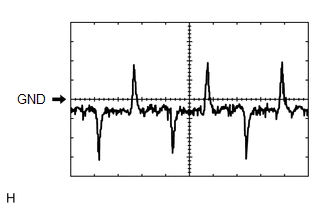
|
Item | Content |
|
Terminal No. | G36-21 (LOCK) - G36-2 (SG-2) |
|
Tool Setting | 200 mV/DIV., 10 ms./DIV. |
|
Condition |
- Engine running
- Blower switch: LO
- A/C switch: On
|
(b) Waveform 2:
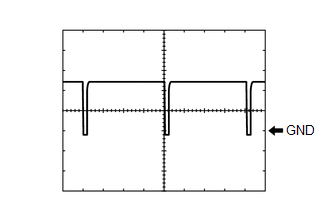
|
Item | Content |
|
Terminal No. | G35-3 (SOL+) - G35-4 (GND) |
|
Tool Setting | 5 V/DIV., 500 ╬╝s./DIV. |
|
Condition |
- Engine running
- Blower switch: LO
- A/C switch: On
|
(c) Waveform 3:
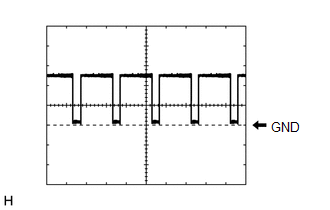
|
Item | Content |
|
Terminal No. | G35-6 (BLW) - G35-4 (GND) |
|
Tool Setting | 2 V/DIV., 1 ms./DIV. |
|
Condition |
- Engine switch on (IG)
- Blower switch: LO
|
(d) Waveform 4:
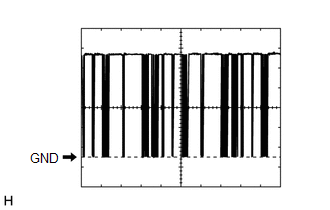
|
Item | Content |
|
Terminal No. | G35-14 (LIN1) - G35-4 (GND) |
|
Tool Setting | 2 V/DIV., 20 ms./DIV. |
|
Condition | Engine switch on (IG) |
(e) Waveform 5:
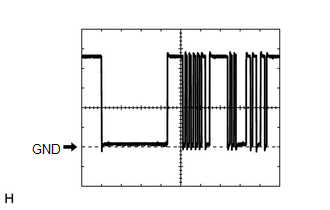
|
Item | Content |
|
Terminal No. | z8-3 (BUS) - z8-2 (BUS G) |
|
Tool Setting | 2 V/DIV., 2 ms./DIV. |
|
Condition | Engine switch on (IG) |
CHECK AIR CONDITIONING CONTROL PANEL (RADIO AND DISPLAY RECEIVER ASSEMBLY)

HINT:
Check from the rear of the connector while it is connected to the air conditioning control assembly.
|
Terminal No. (Symbol) |
Wiring Color | Terminal Description |
Condition | Specified Condition |
|
G20-2 (IG+) - G20-6 (GND) |
GR - W-B | Power source (IG) |
Engine switch off | Below 1 V |
|
Engine switch on (IG) |
11 to 14 V |
|
G20-3 (+B) - G20-6 (GND) |
L - W-B | Power source (Back-up) |
Engine switch off | 11 to 14 V |
|
G20-6 (GND) - Body ground |
W-B - Body ground | Ground for air conditioning control panel (radio and display receiver assembly) |
Always | Below 1 V |
|
G20-8 (LIN1) - Body ground |
LG - Body ground | LIN communication signal |
Engine switch on (IG) |
Pulse generation (See waveform) |
|
G20-10 (ACC) - G20-6 (GND) |
P - W-B | Power source (ACC) |
Engine switch off | Below 1 V |
|
Engine switch ACC | 11 to 14 V |
|
G20-11 (ILL+) - Body ground |
W - Body ground |
Illumination signal | Taillight off |
Below 1 V |
| Taillight on |
11 to 14 V |
|
G20-15 (ILL-) - Body ground |
B - Body ground | Illumination signal |
Always | Below 1 V |
(a) Waveform:

|
Item | Content |
|
Terminal No. | G20-8 (LIN1) - Body ground |
|
Tool Setting | 2 V/DIV., 20 ms./DIV. |
|
Condition | Engine switch on (IG) |
Lost Communication With ECM/PCM "A" (U0100-U0142,U0151,U0155,U0163)
DESCRIPTION
|
DTC No. | Detection Item |
DTC Detection Condition | Trouble Area |
Memory |
| U0100 |
Lost Communication With ECM/PCM "A" |
No communication with ECM |
- CAN communication system
- ECM
| Memorized |
|
U0131 | Lost Communication With Power Steering Control Module |
No communication with power steering ECU (rack and pinion power steering gear assembly) |
- CAN communication system
- Power steering ECU (rack and pinion power steering gear assembly)
| Memorized |
|
U0142 | Lost Communication With Body Control Module "B" |
No communication with main body ECU (multiplex network body ECU) |
- CAN communication system
- Main body ECU (multiplex network body ECU)
| Memorized |
|
U0151 | Lost Communication With Restraints Control Module |
No communication with airbag ECU assembly |
- CAN communication system
- Airbag ECU assembly
| Memorized |
|
U0155 | Lost Communication With Instrument Panel Cluster (IPC) Control Module |
No communication with combination meter assembly |
- CAN communication system
- Combination meter assembly
| Memorized |
|
U0163 | Lost Communication With Navigation Control Module |
No communication with air conditioning control panel (radio and display receiver assembly) |
- CAN communication system
- Air conditioning control panel (radio and display receiver assembly)
| Memorized |
PROCEDURE
| 1. |
GO TO CAN COMMUNICATION SYSTEM |
HINT:
Refer to CAN Communication System.
Click here

| NEXT |  |
END |
Utility
UTILITY
REFRIGERANT HIGH PRESSURE HISTORY CLEAR
(a) Connect the Techstream to the DLC3.
(b) Turn the engine switch on (IG).
(c) Press the OFF switch.
(d) Turn the Techstream on.
(e) Enter the following menus: Body Electrical / Air Conditioner / Utility / Refrigerant High Pressure History Clear.
Body Electrical > Air Conditioner > Utility
|
Tester Display |
| Refrigerant High Pressure History Clear |
REFRIGERANT SHORTAGE CHECK USING TECHSTREAM
(a) Connect the Techstream to the DLC3.
(b) Turn the engine switch on (IG).
(c) Turn the Techstream on.
(d) Enter the following menus: Body Electrical / Air Conditioner / Utility / Refrigerant Gas Volume Check.
Body Electrical > Air Conditioner > Utility
|
Tester Display |
| Refrigerant Gas Volume Check |
(e)
Check that the following conditions are met and perform the refrigerant
shortage check according to the display on the Techstream.
Measurement Condition: |
Item | Condition |
|
A/C switch | On |
|
Ambient temperature* |
0 to 49┬░C (32 to 120┬░F) |
|
Blower speed | HI |
*: If the ambient temperature is not within the range shown, do not perform this check.
HINT:
- Refer to the Techstream operator's manual for further details.
- A message indicating a refrigerant shortage is displayed on the
Techstream and the air conditioning system turns off if the amount of
refrigerant in the system is insufficient.
- DTCs are not stored when performing the refrigerant shortage check using the Techstream.
Result: |
Result | Amount of Refrigerant |
Corrective Action |
|
Refrigerant shortage |
Insufficient |
- Check for refrigerant leaks using a halogen leak detector, and repair if necessary.
- Evacuate the air conditioning system and charge it with the appropriate volume of new or purified refrigerant.
Click here 
|
| Refrigerant correct |
Correct | - |
Weak Blower Output
DESCRIPTION
If the airflow
from the front registers is weak regardless of the blower speed setting
displayed on the air conditioning control panel (radio and display
receiver assembly), the following factors may be the cause.
|
Symptom | Factor |
- Airflow volume is constantly low
- Airflow volume sometimes becomes low
|
- Blower motor with fan sub-assembly malfunction
- ECO mode control of air conditioning system is enabled
- Clogged clean air filter
- Clogged No. 1 cooler evaporator sub-assembly or heater radiator unit sub-assembly fins
- No. 1 cooler thermistor malfunction
- Aspirator not connected properly
|
PROCEDURE
| 1. |
CHECK AIR CONDITIONING SYSTEM |
(a) Operate the blower switch with the following conditions met and check that the airflow volume changes.
|
Blower Speed | Condition |
|
LO ŌåÆ HI |
- Temperature setting: MAX COLD
- Air outlet mode: FACE
- A/C switch: Off
|
OK:
Airflow volume increases.
| NG |
 | GO TO OTHER DIAGNOSIS PROCEDURE (Blower Motor Circuit) |
|
OK |
 | |
| 2. |
CHECK ECO MODE SETTING |
(a) Check if the ECO mode indicator is off.
OK:
The ECO mode indicator is off.
| OK |
 | GO TO STEP 4 |
|
NG |
 | |
| 3. |
CHECK ECO MODE CONTROL OPERATION |
(a)
Operate the ECO switch assembly (electric parking brake switch
assembly) and check that the ECO mode indicator turns off and the blower
speed reduction is canceled.
HINT:
- When ECO mode control is operating, the air conditioning amplifier
assembly controls the air conditioning system to enhance fuel
efficiency. Therefore, explain to the customer that, when ECO mode
control is operating, the blower speed will be reduced.
|
Control |
Outline |
|
Blower Control |
When
the air conditioning system is in AUTO mode, the blower speed will be
reduced to a certain speed. Additionally, if warm-up control is
operating, the blower speed will be further reduced. |
|
Air Inlet Control |
If the ambient temperature is a certain value or more, the air inlet mode will be changed to recirculation mode.
|
- In some situations, ECO mode control may not operate even though it is enabled.
|
Result | Proceed to |
|
ECO mode indicator turns off and blower speed reduction is canceled |
A |
| ECO mode indicator turns off, but the blower speed reduction is not canceled |
B |
| ECO mode indicator does not turn off |
| B |
 | GO TO ECO Switch Circuit |
|
A |
 | |
| 4. |
CHECK CLEAN AIR FILTER |
(a) Visually check the clean air filter.
Click here 
OK:
The clean air filter is not dirty or clogged.
| NG |
 | REPLACE CLEAN AIR FILTER |
|
OK |
 | |
| 5. |
CHECK NO. 1 COOLER THERMISTOR |
(a) Check the installation condition of the No. 1 cooler thermistor.
OK:
The No. 1 cooler thermistor is installed correctly.
| NG |
 | INSTALL NO. 1 COOLER THERMISTOR CORRECTLY |
|
OK |
 | |
(a) Check the installation condition of the aspirator.
OK:
The aspirator is installed correctly.
| OK |
 | REPLACE HEATER RADIATOR UNIT SUB-ASSEMBLY OR NO. 1 COOLER EVAPORATOR SUB-ASSEMBLY |
| NG |
 | INSTALL ASPIRATOR CORRECTLY |






























































































































































































































































































































































































